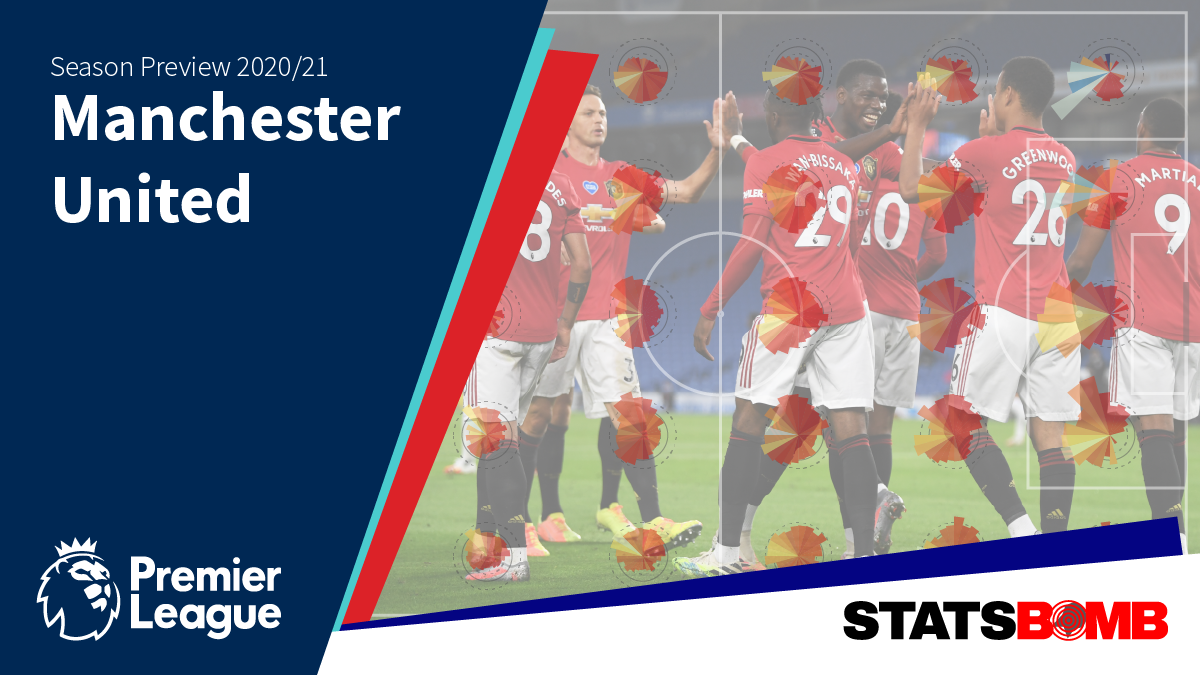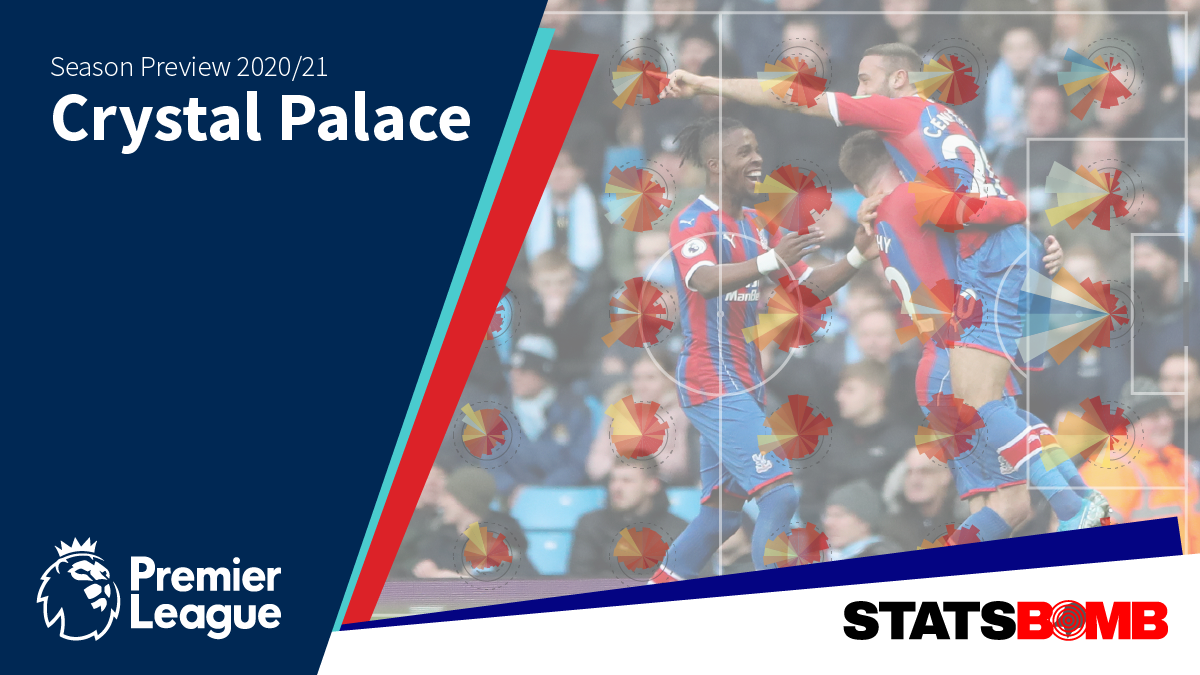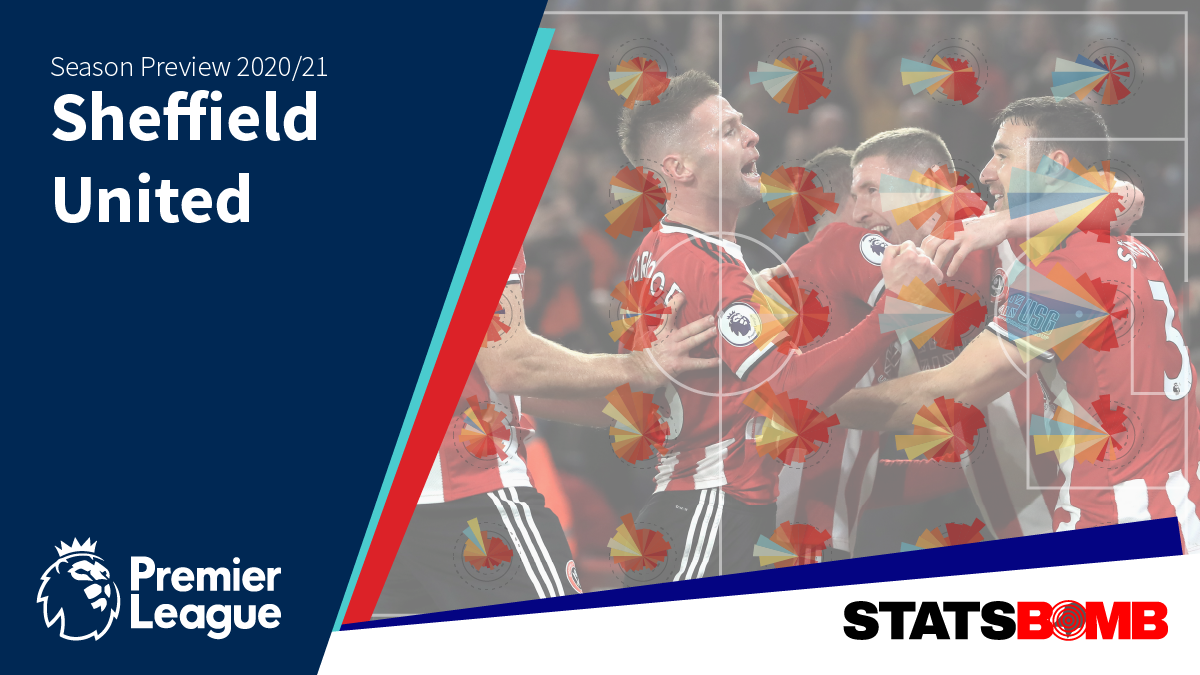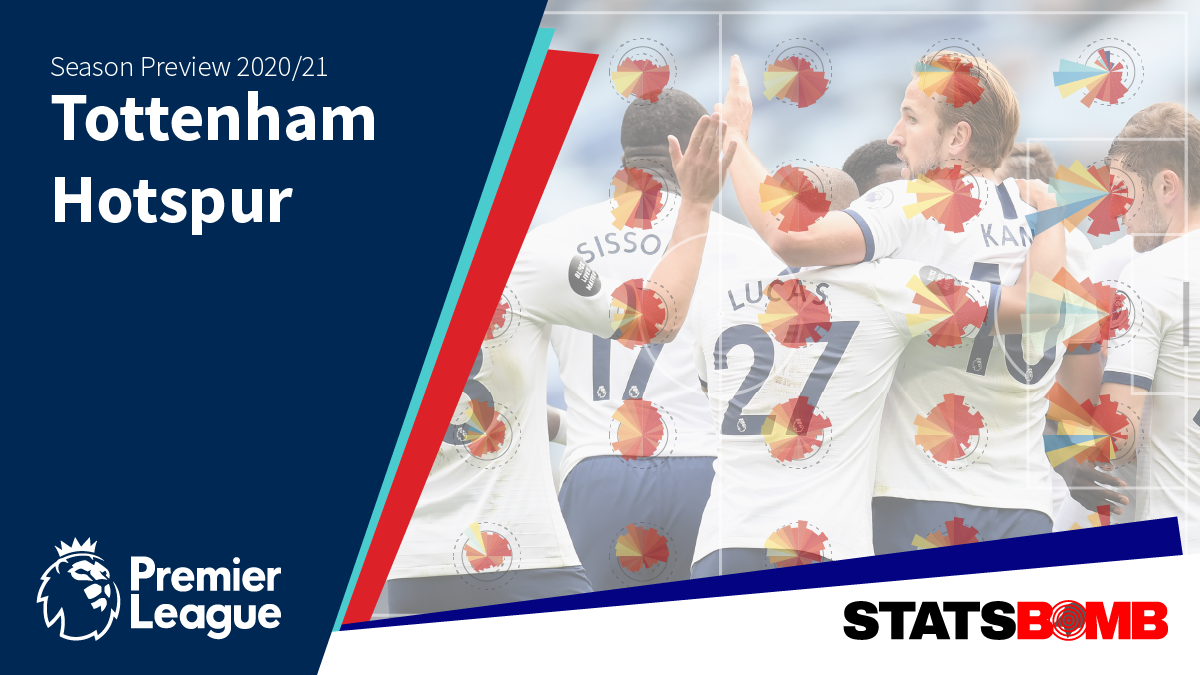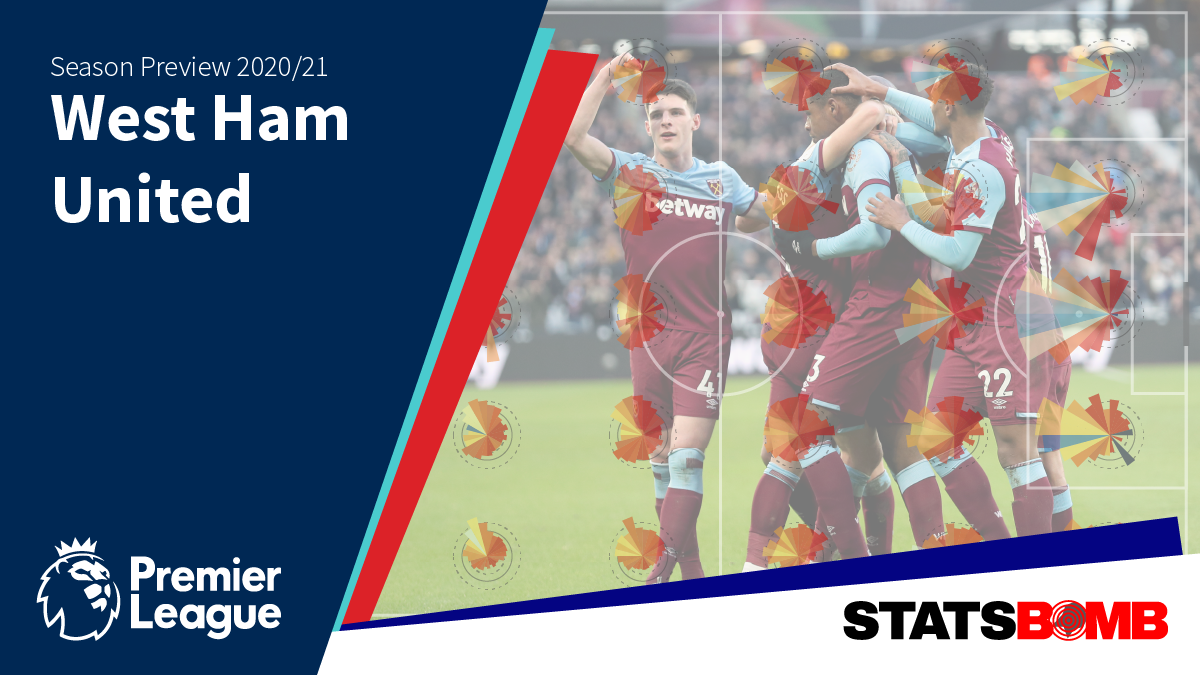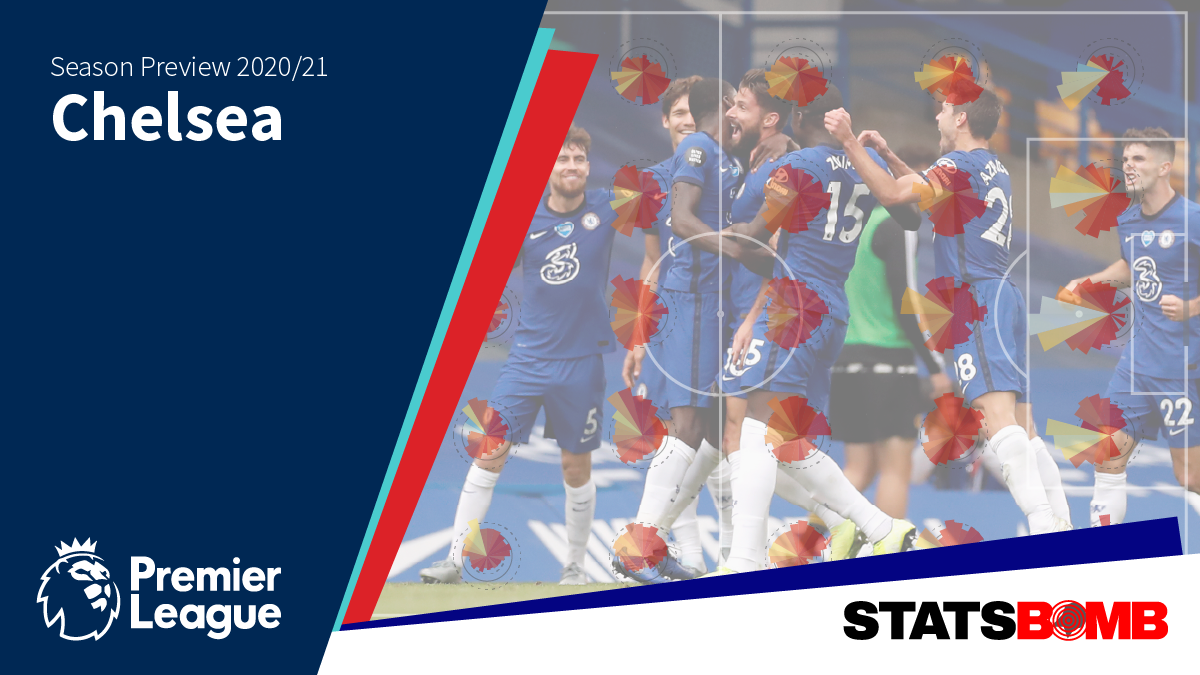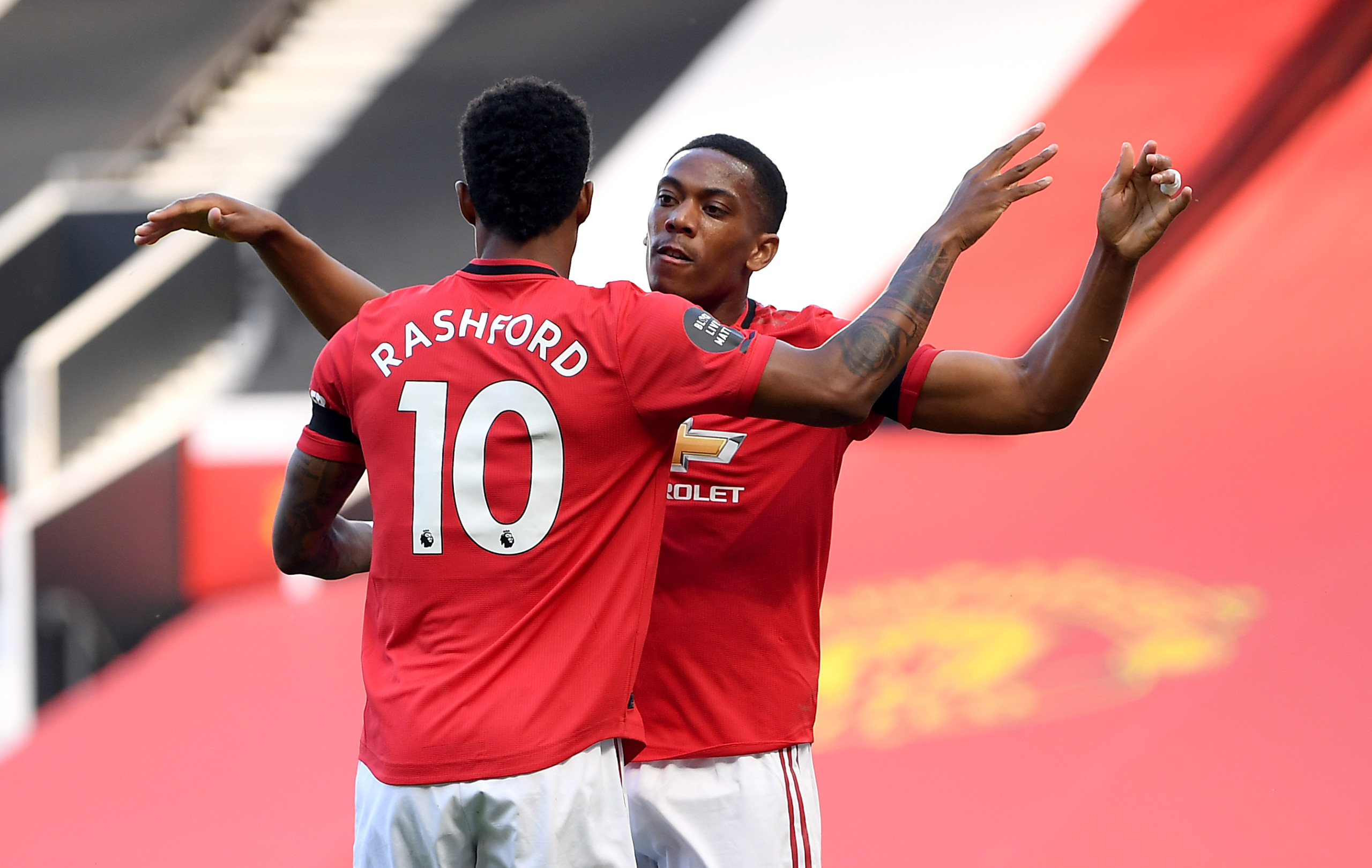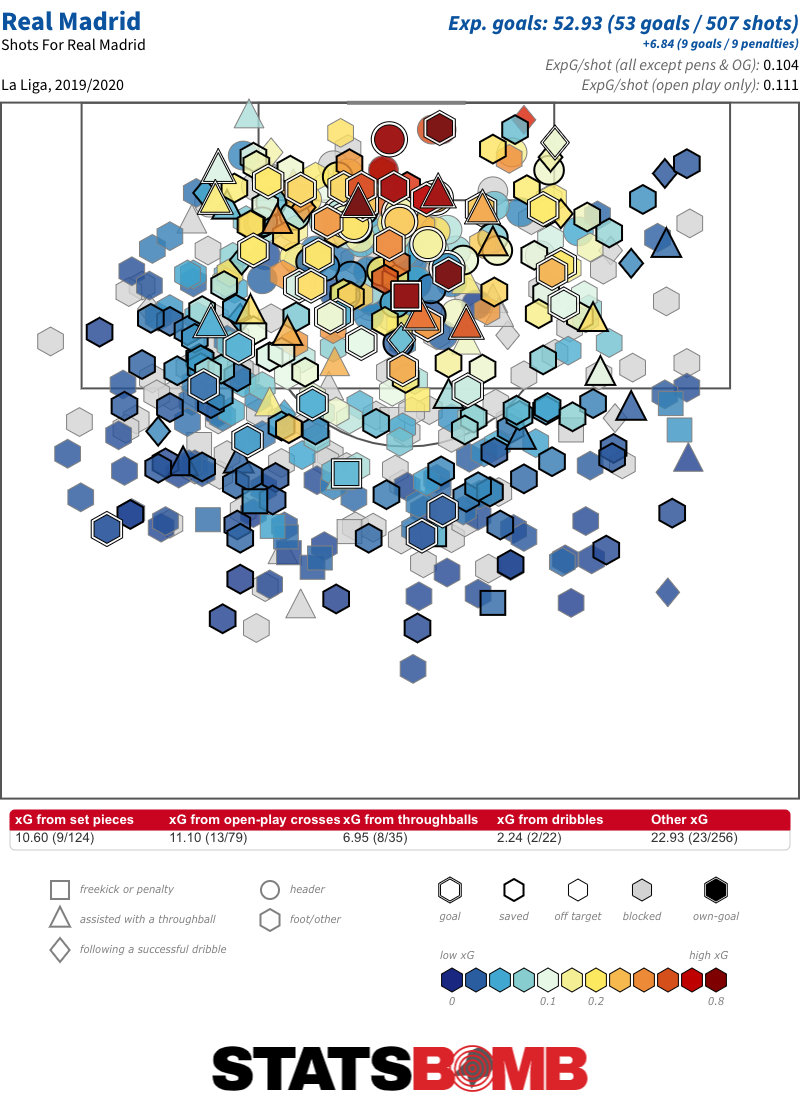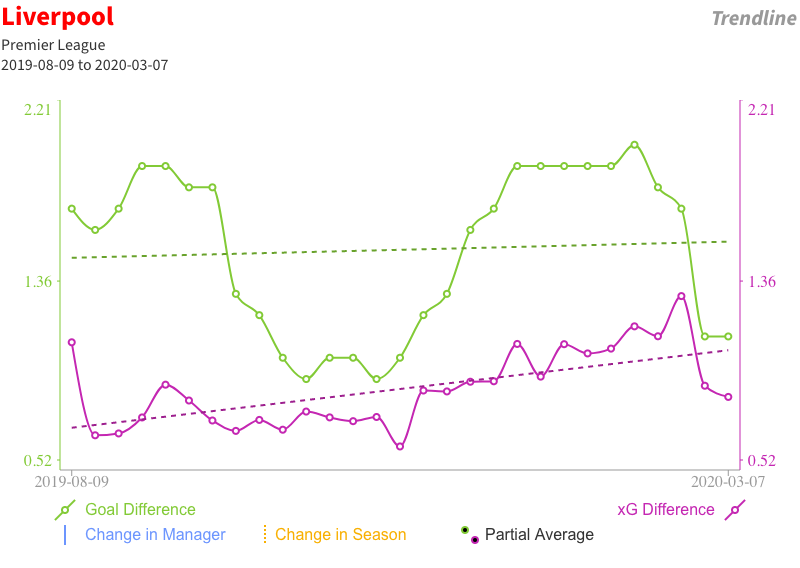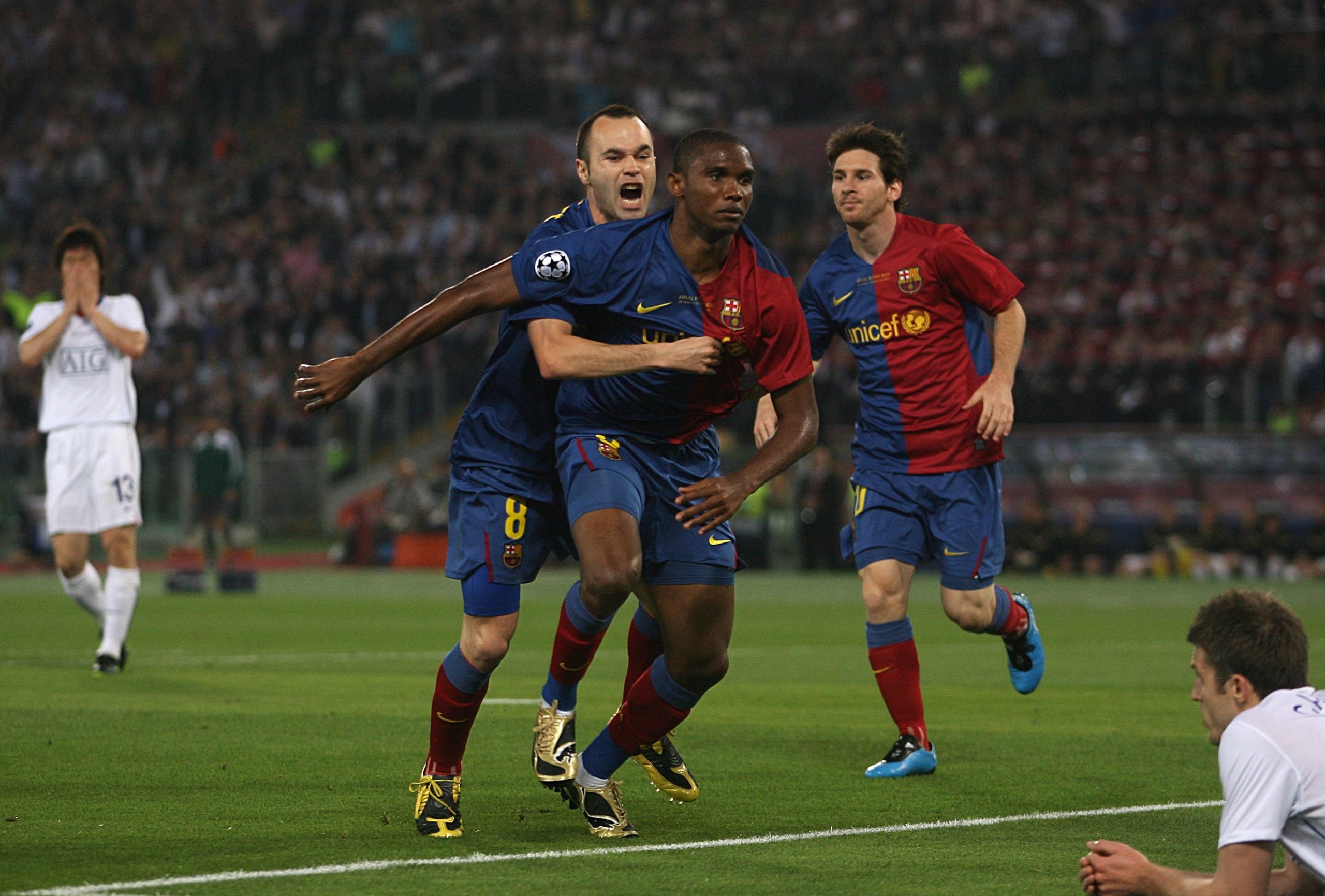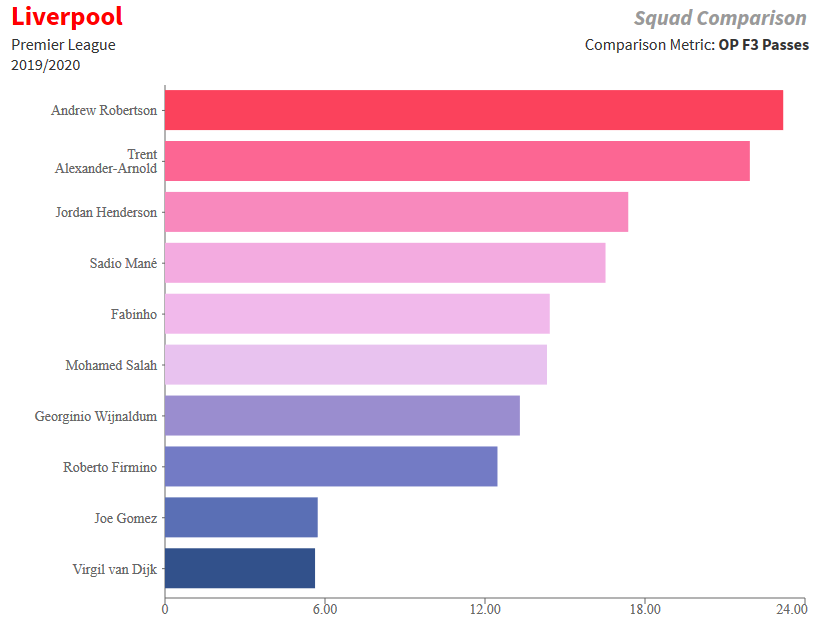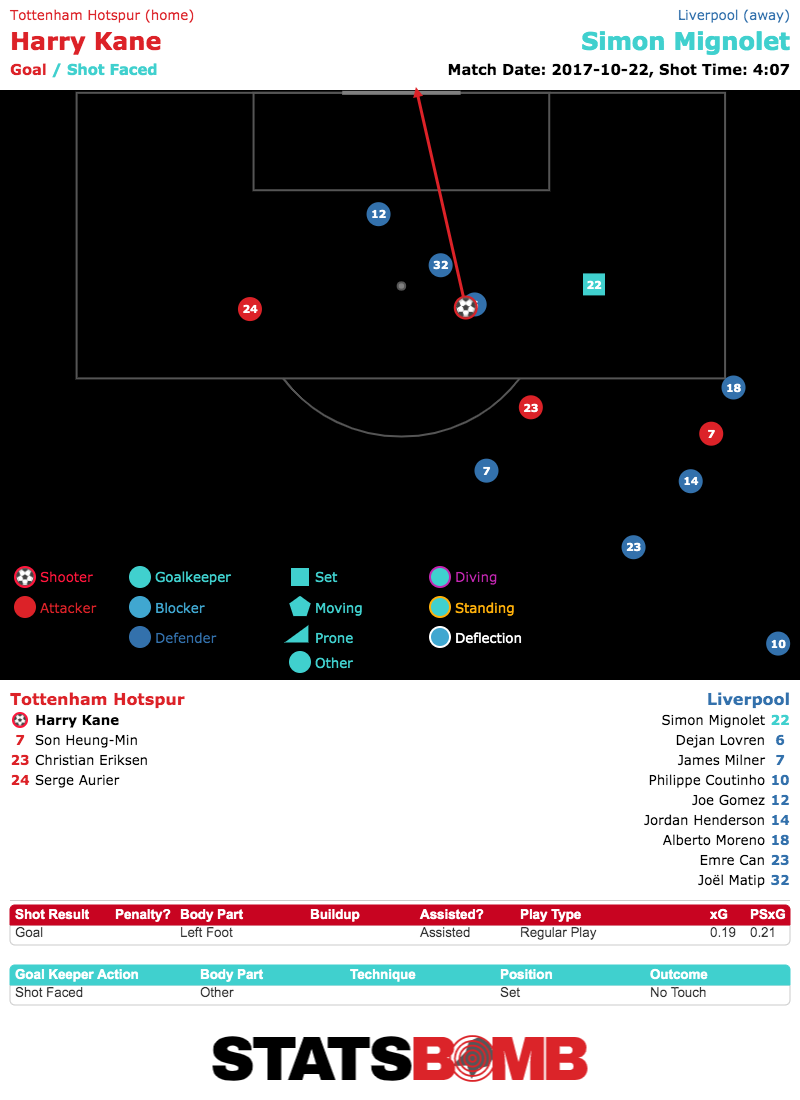Are the good times back? Ole Gunnar Solskjær is closing in on two years in the Manchester United hotseat and there’s a creeping realisation that the longer he’s been there the better things have got. That’s not to say that the journey to this point has been smooth or linear, or that the actual tangible on-pitch improvement is impossible to deny. It’s more subtle than that. When United are good, they can be very good. On paper, they have an array of attacking talent that few can match in Anthony Martial, Bruno Fernandes, Paul Pogba, Marcus Rashford and now Mason Greenwood. In defence, they were only a clip behind Liverpool and Manchester City last season and their expected metrics there were very solid. The recruitment of Fernandes in late January became a clear stake in the ground. While significantly more erratic prior to his arrival, United were unbeaten in the league from that moment onwards (fourteen games) and only lost their first match since his arrival at the club in the FA Cup semi-final in July against Chelsea. The familiar sight of Fernandes finishing a penalty occurred seven times in his first few months at the club, his technique and cool head benefiting from a team that won spot kicks at a high pace throughout the season, often thanks to the slaloming skills of Rashford, Pogba and others. But the first half of the season was less encouraging, with an odd mix of good results against strong teams and bad results against weaker sides. The consistent later form coincided with a more stable first eleven, and a kind post-Covid fixture list was the perfect environment for Pogba to return to and for Greenwood to show a finishing run exceeding that of Rashford’s own emergence four years ago. One of the odd characteristics of Solskjær's reign is how metrics and outcomes have deviated so wildly. It seemed illogical to exclude penalties from this chart (just this once!) since they were such a feature of the 2019-20 season, but it shows expected goal difference and actual goal difference across his whole tenure and how rarely the twain shall meet: 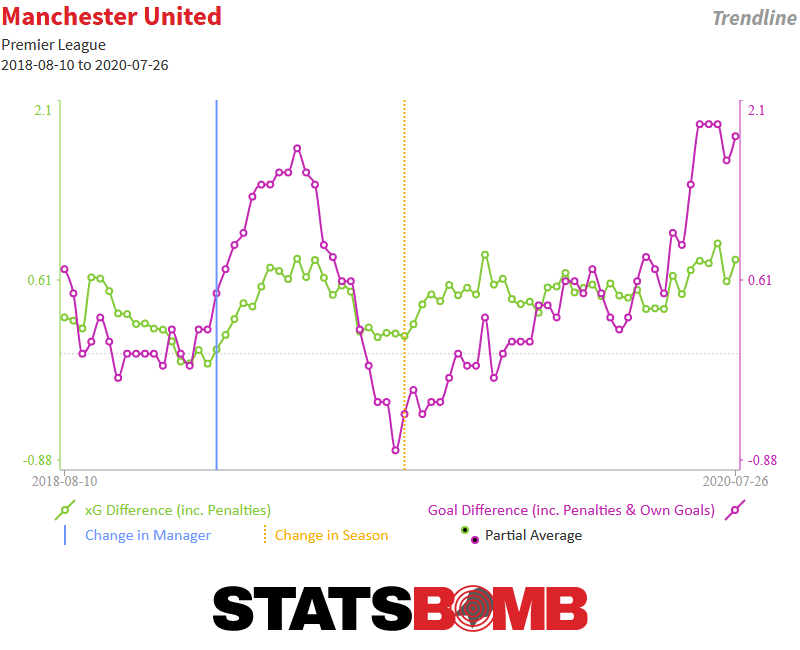 Translation? Expected metrics have slowly crept upwards over time, kinda, actual goal outcomes look more like a heart monitor. This tendency towards wild deviations has actually caused narratives to become slightly faulty. The blast of finishing and run of penalties while Fernandes has been at the club gives the impression that United's attack is their strength, when actually the opposite is likely true--the defence is their bedrock and has been for some while:
Translation? Expected metrics have slowly crept upwards over time, kinda, actual goal outcomes look more like a heart monitor. This tendency towards wild deviations has actually caused narratives to become slightly faulty. The blast of finishing and run of penalties while Fernandes has been at the club gives the impression that United's attack is their strength, when actually the opposite is likely true--the defence is their bedrock and has been for some while: 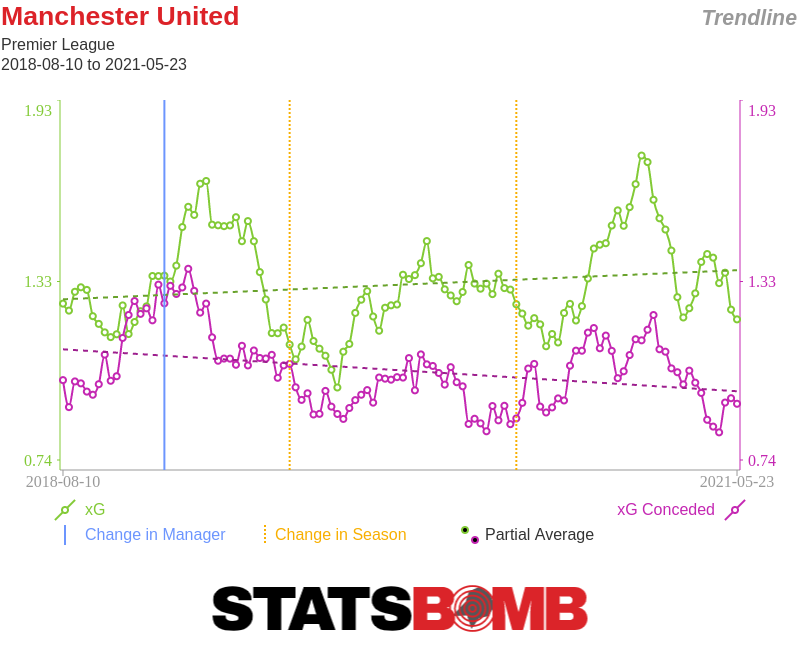 A season long expected goal against value of around 0.9 per game is in the ballpark of their rivals--including Manchester City and Liverpool. A season long expected goal for value of 1.3 per game parks then between Southampton and Everton. If this team has designs of winning enough games to point upwards out of the island of third to fourth, it will first and foremost need to get better in attack. How can this be achieved? The front five United fielded during their unbeaten run are a blend of dual purpose longer range shooters and creators (Pogba and Fernandes), shooters (Rashford and Greenwood) and a player with long term finishing prowess who has seen creativity drop off as he's been empowered into a centre forward role (Martial). It's likely that carrying Rashford, Greenwood and Martial (in this role) damages the ability for this team to create a high volume of chances. As we saw towards the end of the season, if Fernandes is quiet, United can really drift and lack incisive creativity. The depth in this area of the pitch is not ideal too with the likes of Jesse Lingard, Juan Mata or Andreas Pereira more sporadic and limited influences. The ship has sailed, but ironically, the profile provided by Alexis Sánchez, or at least a younger more virile version of him, would fit well into this set-up. Somewhere, United's balance of shooting and creativity needs to skew towards the latter. It's what makes the [potential] signing of Donny van de Beek ostensibly curious, as it's quite hard to directly envisage which of United's current attackers or midfielders he will likely replace, or specifically how he'd fit into midfield given how little he tends to contribute towards general buildup. Of course, as more required depth, he's entirely fine, but there's not an obvious way to get Van de Beek into a starting lineup that include Martial, Rashford and Greenwood unless you're entirely throwing caution to the wind and giving midfield a complete pass. This then undermines your already solid defence and puts a heck of a lot onto Pogba and/or Fernandes. This isn't Garth Crooks' team of the week; the Matic/Fred role can't just be abandoned. But at least this problem exists. Yes, the squad needs more depth and the drop off should injury hit any key starter is severe but the outright Manchester United first XI nearly picks itself, something that hasn't always been the case in the post-Ferguson era. To be more generally positive though, in Greenwood and his breakthrough, another fine talent looks to have been unearthed but this has slightly deflected focus on the development of Rashford. Of the attacking unit, his form was perhaps the least impressive post-lockdown, but now in a more settled left sided position, on aggregate his progression is tangible:
A season long expected goal against value of around 0.9 per game is in the ballpark of their rivals--including Manchester City and Liverpool. A season long expected goal for value of 1.3 per game parks then between Southampton and Everton. If this team has designs of winning enough games to point upwards out of the island of third to fourth, it will first and foremost need to get better in attack. How can this be achieved? The front five United fielded during their unbeaten run are a blend of dual purpose longer range shooters and creators (Pogba and Fernandes), shooters (Rashford and Greenwood) and a player with long term finishing prowess who has seen creativity drop off as he's been empowered into a centre forward role (Martial). It's likely that carrying Rashford, Greenwood and Martial (in this role) damages the ability for this team to create a high volume of chances. As we saw towards the end of the season, if Fernandes is quiet, United can really drift and lack incisive creativity. The depth in this area of the pitch is not ideal too with the likes of Jesse Lingard, Juan Mata or Andreas Pereira more sporadic and limited influences. The ship has sailed, but ironically, the profile provided by Alexis Sánchez, or at least a younger more virile version of him, would fit well into this set-up. Somewhere, United's balance of shooting and creativity needs to skew towards the latter. It's what makes the [potential] signing of Donny van de Beek ostensibly curious, as it's quite hard to directly envisage which of United's current attackers or midfielders he will likely replace, or specifically how he'd fit into midfield given how little he tends to contribute towards general buildup. Of course, as more required depth, he's entirely fine, but there's not an obvious way to get Van de Beek into a starting lineup that include Martial, Rashford and Greenwood unless you're entirely throwing caution to the wind and giving midfield a complete pass. This then undermines your already solid defence and puts a heck of a lot onto Pogba and/or Fernandes. This isn't Garth Crooks' team of the week; the Matic/Fred role can't just be abandoned. But at least this problem exists. Yes, the squad needs more depth and the drop off should injury hit any key starter is severe but the outright Manchester United first XI nearly picks itself, something that hasn't always been the case in the post-Ferguson era. To be more generally positive though, in Greenwood and his breakthrough, another fine talent looks to have been unearthed but this has slightly deflected focus on the development of Rashford. Of the attacking unit, his form was perhaps the least impressive post-lockdown, but now in a more settled left sided position, on aggregate his progression is tangible: 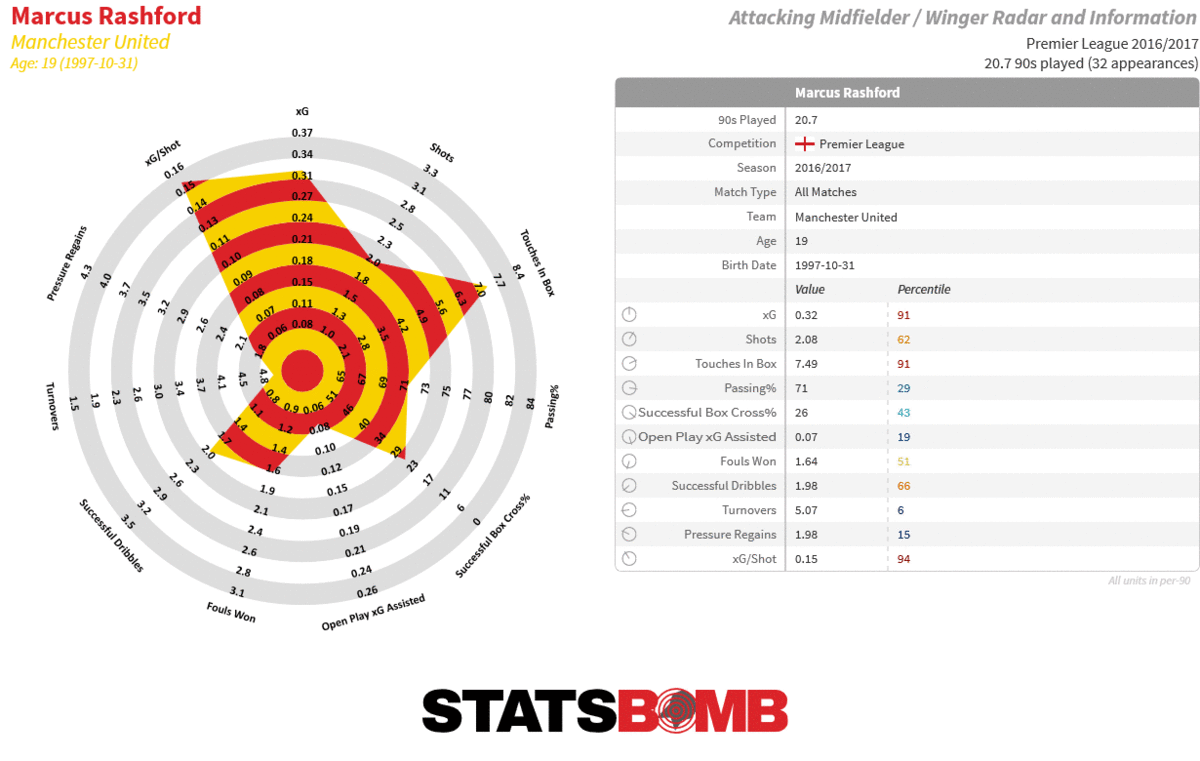 He still likes a dip from range, but has shown ever greater ability to get into good quality finishing positions, and at 22 years old, can't be far off the finished article as a player. Martial too appeared to prosper given the centre forward position. His 17 goals from an expected 10 was a welcome boost, but only continues a theme: few players are over their xG every season, but he has been for his entire time at United, albeit not to this degree before:
He still likes a dip from range, but has shown ever greater ability to get into good quality finishing positions, and at 22 years old, can't be far off the finished article as a player. Martial too appeared to prosper given the centre forward position. His 17 goals from an expected 10 was a welcome boost, but only continues a theme: few players are over their xG every season, but he has been for his entire time at United, albeit not to this degree before: 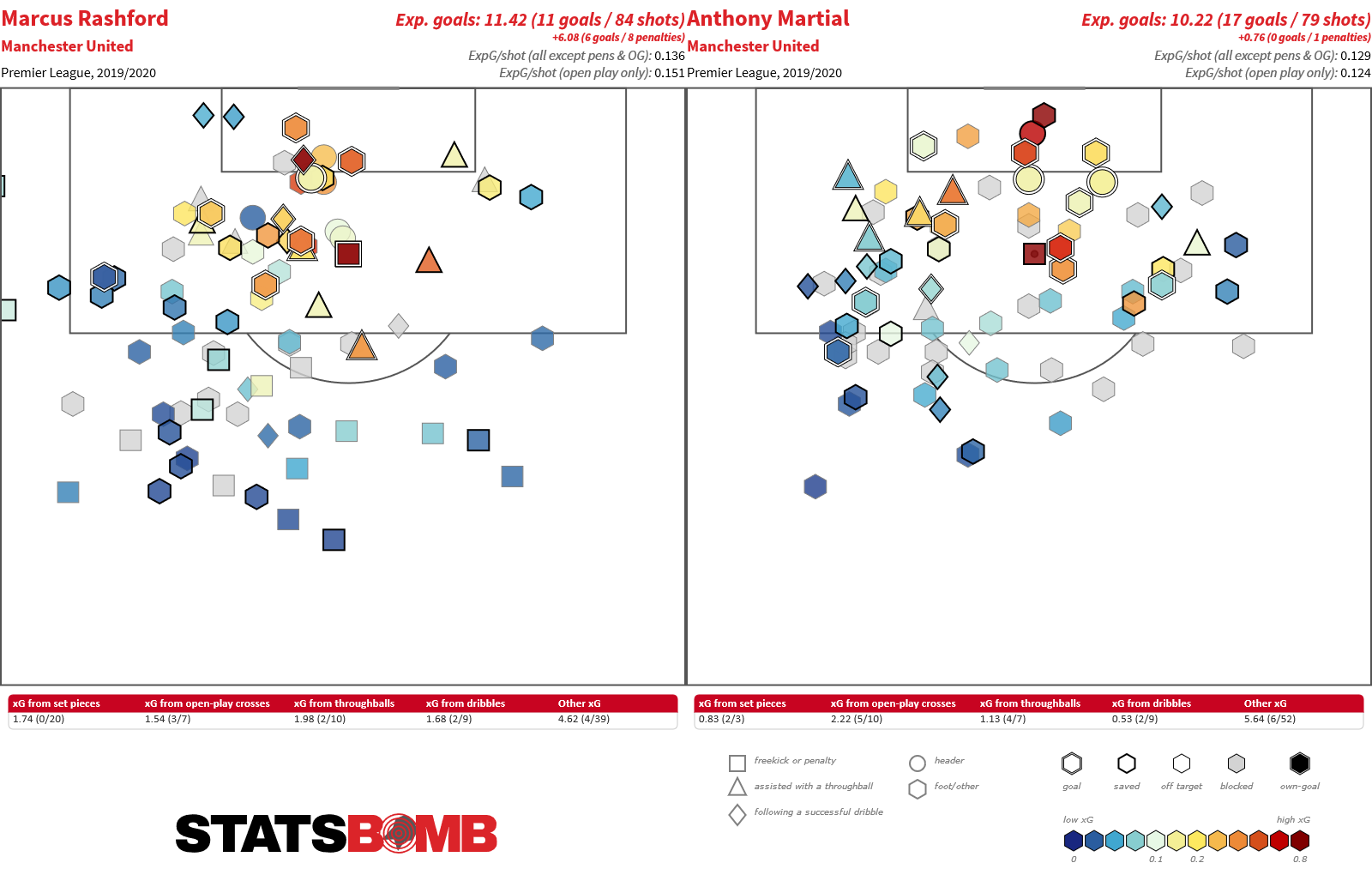 If we turn to the new man, Van de Beek, his main qualities can be seen inside the box too. He looks to be a good quality finisher, as we can see from two seasons of Eredivisie shots here:
If we turn to the new man, Van de Beek, his main qualities can be seen inside the box too. He looks to be a good quality finisher, as we can see from two seasons of Eredivisie shots here: 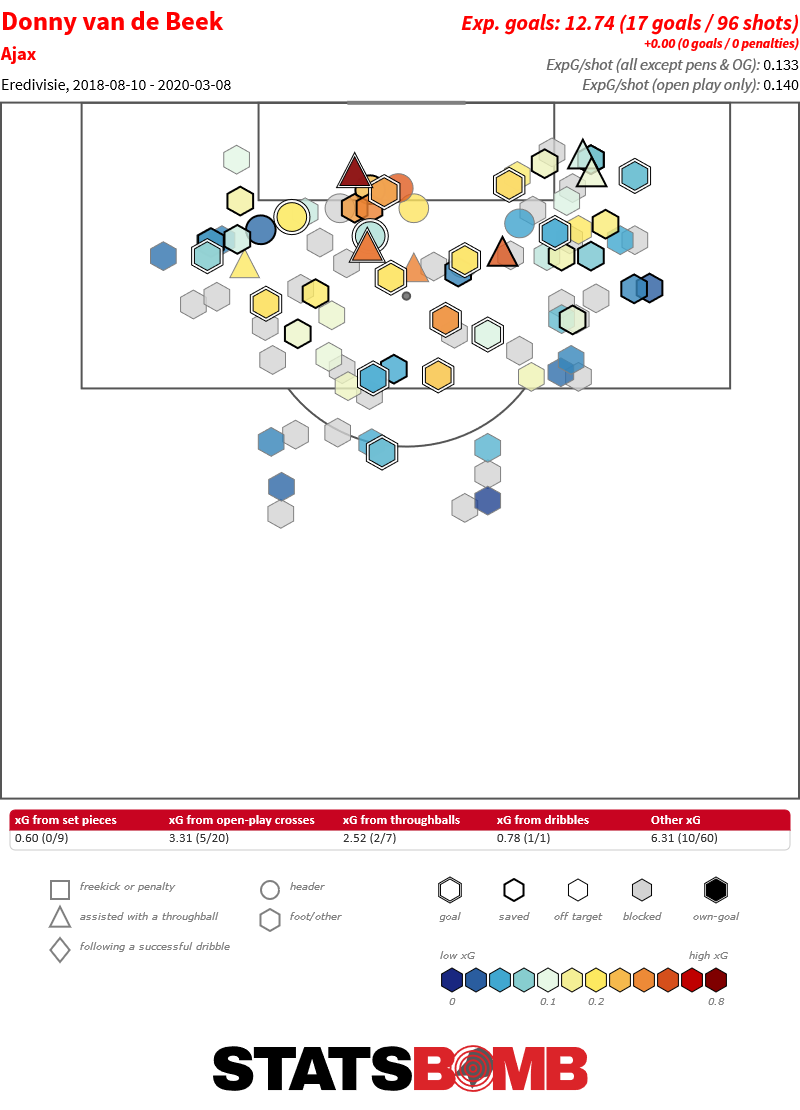 He's predominantly right footed, but there's some left foot and head in there too. We reviewed him for our Pro-Scouting project and our executive summary was as follows: Strengths ● Exceptional off-ball movement in and around the penalty area. ● Goalscoring and chance creation numbers outstanding. ● Positionally versatile, can play as central or attacking midfielder. Weaknesses ● Little involvement in build-up. ● Limited defensive output. Summary Donny van de Beek is world-class within his role. He is an exceptional goalscorer from midfield and combines that with great chance creation numbers. However, his involvement in other areas of the game is limited. It is unclear whether or not this profile is enough for clubs at the very highest level, to which he is often linked. Current: Europa League top 5 leagues Potential: Champions League level, in a very defined role. Transfer Potential ● Ajax do not sell cheap, transfer fee likely to be upwards of 40m. My sense here is that the best of Van de Beek may come later in his contract if United continue to build and recruit well, and he's able to fulfil a specific role, but goals and assists from midfield win friends and can cover sins, so he may well come out ahead regardless. With a deal for Jadon Sancho seemingly receding in likelihood and Lionel Messi yet to be sighted in Lancashire, that's it so far for United. The one position that needs no attention is goalkeeper with David De Gea likely to continue despite a less than stellar 2019-20 and Dean Henderson's future slightly uncertain. He won't be returning to Sheffield United, but is plenty good enough to continue as a Premier League number one for someone. Could there be more depth in defence? The work done last summer in acquiring Aaron Wan-Bissaka and Harry Maguire locked down two positions and Luke Shaw has staged something of a renaissance to claim left-back. Victor Lindelöf has nailed down the other starting role across the last two seasons, and again it feels like a question of whether the assorted depth that exists can cover sufficiently, or whether new blood is needed. It would be great to see Eric Bailly or Phil Jones find a run of form and fitness but those eternal question marks mean another centre back would be nice, while Brandon Williams was a successful find last season and can cover both defensive flanks as required. United's whole line up does feel one key injury away from sticking plasters in most positions so another defender and midfield option would tidily round out the summer. Projection Manchester United have a curious schedule to start. They don't face an away trip to a team that finished in the top half last season until week 12 and Sheffield United on December 15th. Of course this means a bunch of better rated teams visiting Old Trafford early on, including Manchester City, Tottenham, Arsenal and Chelsea, from which they got 10/12 points in the corresponding 2019-20 fixtures. A few things will probably happen:
He's predominantly right footed, but there's some left foot and head in there too. We reviewed him for our Pro-Scouting project and our executive summary was as follows: Strengths ● Exceptional off-ball movement in and around the penalty area. ● Goalscoring and chance creation numbers outstanding. ● Positionally versatile, can play as central or attacking midfielder. Weaknesses ● Little involvement in build-up. ● Limited defensive output. Summary Donny van de Beek is world-class within his role. He is an exceptional goalscorer from midfield and combines that with great chance creation numbers. However, his involvement in other areas of the game is limited. It is unclear whether or not this profile is enough for clubs at the very highest level, to which he is often linked. Current: Europa League top 5 leagues Potential: Champions League level, in a very defined role. Transfer Potential ● Ajax do not sell cheap, transfer fee likely to be upwards of 40m. My sense here is that the best of Van de Beek may come later in his contract if United continue to build and recruit well, and he's able to fulfil a specific role, but goals and assists from midfield win friends and can cover sins, so he may well come out ahead regardless. With a deal for Jadon Sancho seemingly receding in likelihood and Lionel Messi yet to be sighted in Lancashire, that's it so far for United. The one position that needs no attention is goalkeeper with David De Gea likely to continue despite a less than stellar 2019-20 and Dean Henderson's future slightly uncertain. He won't be returning to Sheffield United, but is plenty good enough to continue as a Premier League number one for someone. Could there be more depth in defence? The work done last summer in acquiring Aaron Wan-Bissaka and Harry Maguire locked down two positions and Luke Shaw has staged something of a renaissance to claim left-back. Victor Lindelöf has nailed down the other starting role across the last two seasons, and again it feels like a question of whether the assorted depth that exists can cover sufficiently, or whether new blood is needed. It would be great to see Eric Bailly or Phil Jones find a run of form and fitness but those eternal question marks mean another centre back would be nice, while Brandon Williams was a successful find last season and can cover both defensive flanks as required. United's whole line up does feel one key injury away from sticking plasters in most positions so another defender and midfield option would tidily round out the summer. Projection Manchester United have a curious schedule to start. They don't face an away trip to a team that finished in the top half last season until week 12 and Sheffield United on December 15th. Of course this means a bunch of better rated teams visiting Old Trafford early on, including Manchester City, Tottenham, Arsenal and Chelsea, from which they got 10/12 points in the corresponding 2019-20 fixtures. A few things will probably happen:
- Greenwood's finishing will cool off. He looks a rare talent, but will not often in his career score 10 goals for every 3.7 xG he generates as he did in the league last season
- Penalty returns will reduce. United had a +11 balance (albeit they missed four meaning +7 in goals). Next best in the Premier League across four seasons is +8. They do win a lot of penalties and may continue to do so, but in all likelihood, the gap shrinks between won and conceded.
- The defence will not allow five goals from the next 145 shots (and 12.6 xG) as it did during the 14 game unbeaten run. This equates to opposition finishing at 3.4% which is about as low as when Leicester experienced a wild and unsustainable opponent finishing run, that ultimately powered their title charge in 2015-16. Across the whole season, United's defence was close to its xG, but short term mega-skews should not be misinterpreted as legitimate form changes. The defence is good regardless, just not this good.
Elsewhere, it's hard to pull apart the numbers and categorically conclude this team is moving onwards and upwards quickly. A further comfortable top four finish, with a boost underneath in the stats would probably again represent progress. It's easy to forget the difficulties that this team faced during the first half of 2019-20 and how different it looked then compared to later. Perhaps the two cup defeats were emblematic of the status this United team has reached: nearly there but not quite. Again though the foundation feels a lot more sturdy than it did twelve months ago, and were the board to reach out and make another signing that had the potential to impact as much as Fernandes has, accelerating to better outcomes is achievable. In Solskjær, United may not have a manager driven by an emphatic football philosophy, but they may have one who is able to continue this incremental build towards a stable, strong, talented and competitive team.
If you're a club, media or gambling entity and want to know more about what StatsBomb can do for you, please contact us at Sales@StatsBomb.com We also provide education in this area, so if this taste of football analytics sparked interest, check out our Introduction to Football Analytics course Follow us on twitter in English and Spanish and also on LinkedIn
Crystal Palace were a popular pick to struggle in 2019-20, but crafty veteran Roy Hodgson oversaw a mid-table finish with few wider worries.
Once the league settled down they were never higher than seventh or lower than their finishing position of fourteenth. However, despite all but securing safety in a pre-pandemic world (the hiatus started when they were on 39 points) their form in the short summer recall was dismal (1-1-7). It’s always hard to evaluate a team with little obvious reason to max out performance, but these games were closer to the relatively poor metrics that Palace had put up through to March.
Year on year, this decline was real. While 2018-19’s twelfth placed finish had not foretold doom for this aging squad--it was backed up by tenth placed, borderline par expected goal output--pre-Covid 2019-20 was different. A -0.41 xG per game stat line ranked 17th and the decline was all inhabited within the attack. The team went backwards from twelve shots a game the season before to under ten; at that stage a league worst total. And then, upon restarting, the performances started to match the numbers. When looking at the last two seasons (shown here in the trendlines) we can clearly see how the metrics were okay in 2018-19 and distinctly-not-okay in 2019-20. This is a huge red flag.
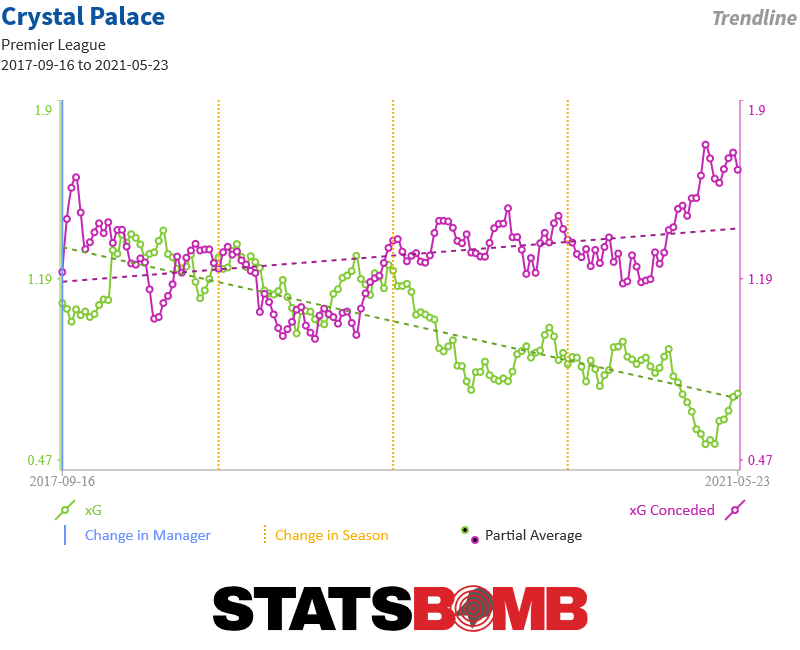
Hodgson had been well aware of his team’s potential failings, stating in September that:
“We'd like to score more but we've not been a prolific goalscoring team in these two years”.
This was a comment based on seasons scoring 45 and 51 goals. In 2019-20 they notched just 31, the lowest total in their entire history. Defence may be the priority for Roy, but usually when your attack is underperforming like this you run the risk of landing in a relegation battle. That this didn’t happen here feels like a stroke of fortune that should be recognised as such ahead of this new season. Palace got tangibly worse and somehow never had to face the music. Intriguingly, Pandemic Season One 2019-20, saw “footballing” teams like Norwich and Bournemouth relegated while Aston Villa and for half a season West Ham were also football first, results later and struggled. It doesn’t always play out this way though, and importantly, Palace's age factor won't fail to kick in forever.
This is the oldest team in the league by some margin. Their average age last season was pushing 30 in a division where 27 is normal. No player under the age of 26 played any significant minutes at all. This was the main factor that provoked pessimism ahead of 2019-20, but now with declining metrics on top of that plus another year, it’s hard to project this team positively:
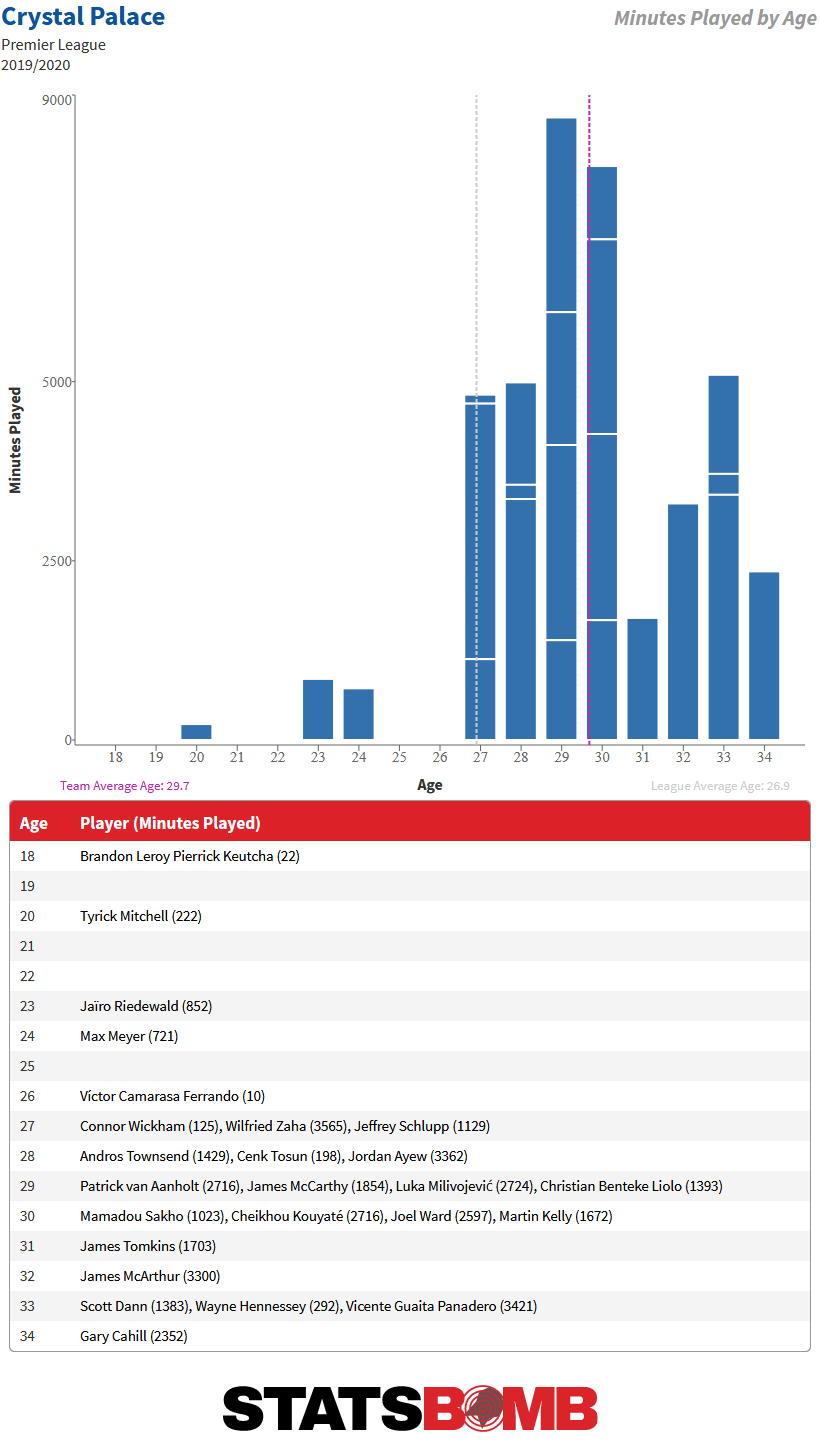
Goalkeeper Vicente Guaita was a difference maker in 2019-20. We had him ranked third in the Premier League for how active he was in making claims, behind Nick Pope and Alex McCarthy, while for shot stopping only Hugo Lloris and Emiliano Martinez (who had a fine pro-rata run in the late season) were ahead of him. Before arriving in England he was decent for Getafe, and no worse than average in 2018-19 for Palace, so despite age, has scoped out as a fairly positive contributor over a reasonable period of time. As ever though, maintaining hope that your goalkeeper is above average is a function of limited utility to pin hopes upon.
You know what you get with Wilfried Zaha. High volume dribbling, a shot map that eschews a central vortex, turnovers, fouls won and a ceiling that probably explains why the oft mooted big move has never quite materialised. His 2018-19 season saw ten goals, but only four of those were from his main shooting zone; fairly wide on his flank. He continued to shoot from there regularly in 2019-20 but notched just twice from out wide and four times overall while seven total goal contributions was around half his previous two seasons. All his expected contributions mirrored this and declined to their lowest levels since 2016-17 and it's hard to isolate the chicken from the egg. Zaha wasn't particularly good, but nor were any of his attacking teammates. Christian Benteke continues to be an unfortunate poster boy for expected goal variance. This time round his two non-penalty goals came from an expectation of over four. Interestingly, his scoring woes inhabit precisely Roy Hodgson's tenure. The season or so prior to his arrival Benteke was around par--13 goals from 13 xG. Ever since, for three long seasons, it's been hard graft for little reward:

Jordan Ayew scored nine league goals and remains one of the hardest working forwards around. He ranked second for pressure events and fifth for counterpressures among strikers in the division but eighth and 26th for the volume of team regains recorded as a result of them. He's putting the legwork in, but the team doesn't quite push up enough to enact rewards from that. Only two players broached over a quarter of a goal a game contribution for combined goals and assists, Ayew and er... Jeff Schlupp. Only Benteke exceeded the same rate for expected values but under shot by half, and only he again contributed to more than two and a half shots and key passes per game. Whichever way you look at Palace, either in possession or out of it, their attackers ploughed lonely furrows and scarcely clicked.
With the window likely closing on a sizeable windfall for Zaha, team investment may miss a shot in the arm that could have helped from his departure. They simply have to get younger this window and their first two ventures into the transfer market do finally reflect that as do Hodgson's recent comments:
"We are assembling the pieces of our jigsaw with regard to bringing in some fresh, young players to our squad who will provide the quality and energy we have highlighted as being necessary for us to take the next steps forward."
Firstly, Nathan Ferguson arrived for an as yet undecided fee from West Brom. A versatile defender, he instantly injects youth and promise in to the line up but at 19 years old, ideas towards contribution this season should probably be tempered.
More exciting is the arrival of Eberechi Eze from QPR, for what could be a decent fee, somewhere south of £20m. The Londoner's breakout season saw him notch 14 goals and 7 assists from varied attacking and midfield positions and regularly show up in highlight reels. He is positionally versatile, but frequently occupied the left side--much like Zaha has. How will the attackers all fit together? Zaha did spend time coming from the right in 2019-20 and specifically up front in 2018-19 so it's possible that whoever isn't the left sided starter of the two will find themselves filling different roles in different games, depending on other selection choices (mixing with some combination of one or more of Andros Townsend, Benteke and Ayew too). I'm not going to profess to having seen much of Eze--there's only so much time in the world, even in lockdown--but ideas around why he may have appealed to the Palace dealmakers aren't too far from home. He looks to be slightly more secure on the ball, which is an intriguing boost for an ostensibly flair player and having just turned 22, it's hard not to see his best years as imminent:
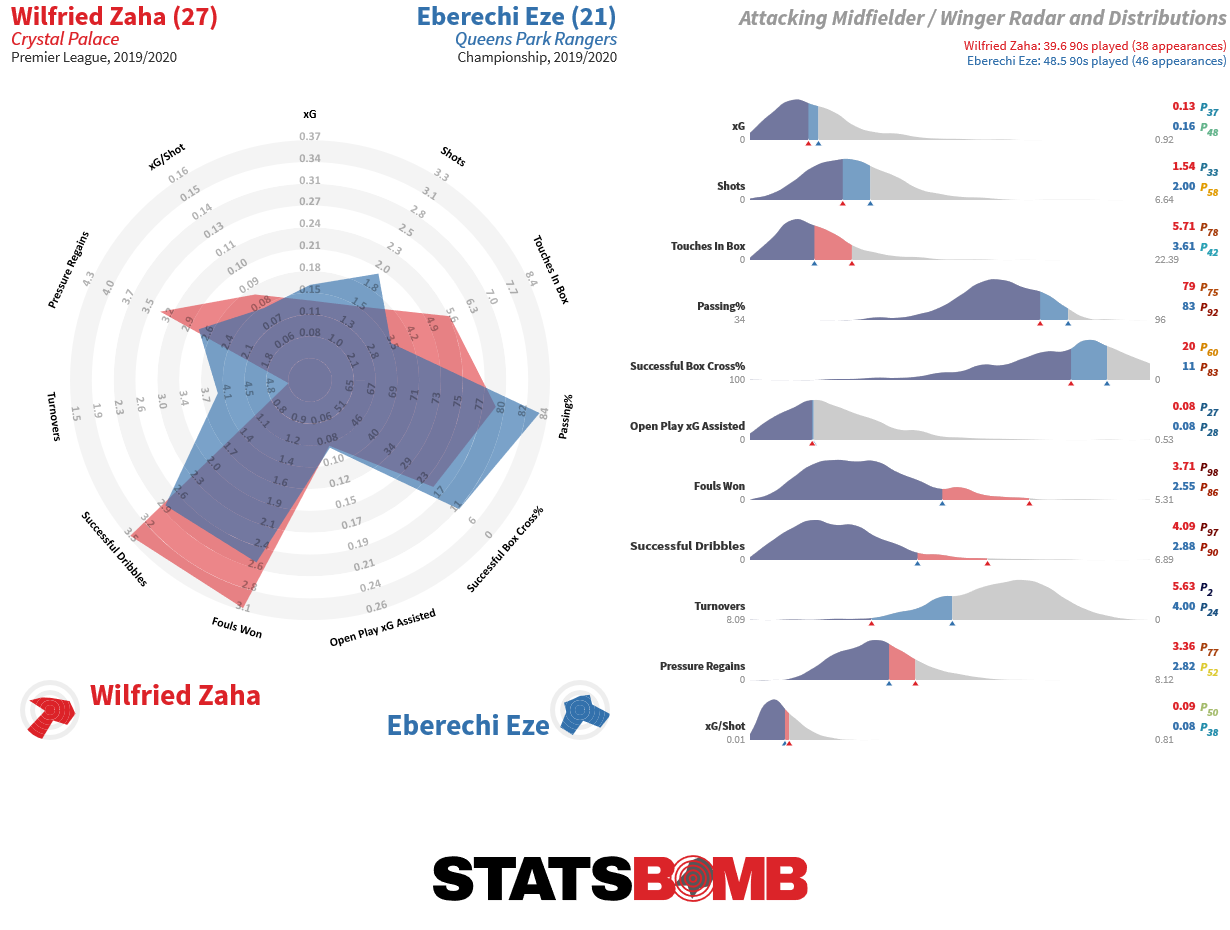
Even then, there is a cautionary side of "what next?" for Eze. A headline of 14 goals and 7 assists look great, but he started every game last season, and once you do the maths, it squares off at around 0.35 goals or assists per game, ahead of an expectation below 0.3. His passing threat is boosted by his set-piece contributions which is both great (useful players to have!) and cautionary (his xG Assisted numbers aren't huge, and shrunk just to open play, er... shrink). He looks fairly pressure resistant too which may help him gel into the side, but he is joining the league's worst attack.
Also likely to arrive is Chelsea loanee Conor Gallagher fresh off a split season with Charlton then Swansea in the Championship. His differing impact across the two tenures are a great example of why data evaluation is only part of any kind of player evaluation. Gallagher's comments here:
"I think at Swansea they have more of the ball than Charlton did, and he [manager Steve Cooper] gave me a chance to create more chances and I think that's why I've got a number of assists for Swansea." are reflected tidily in the numbers:
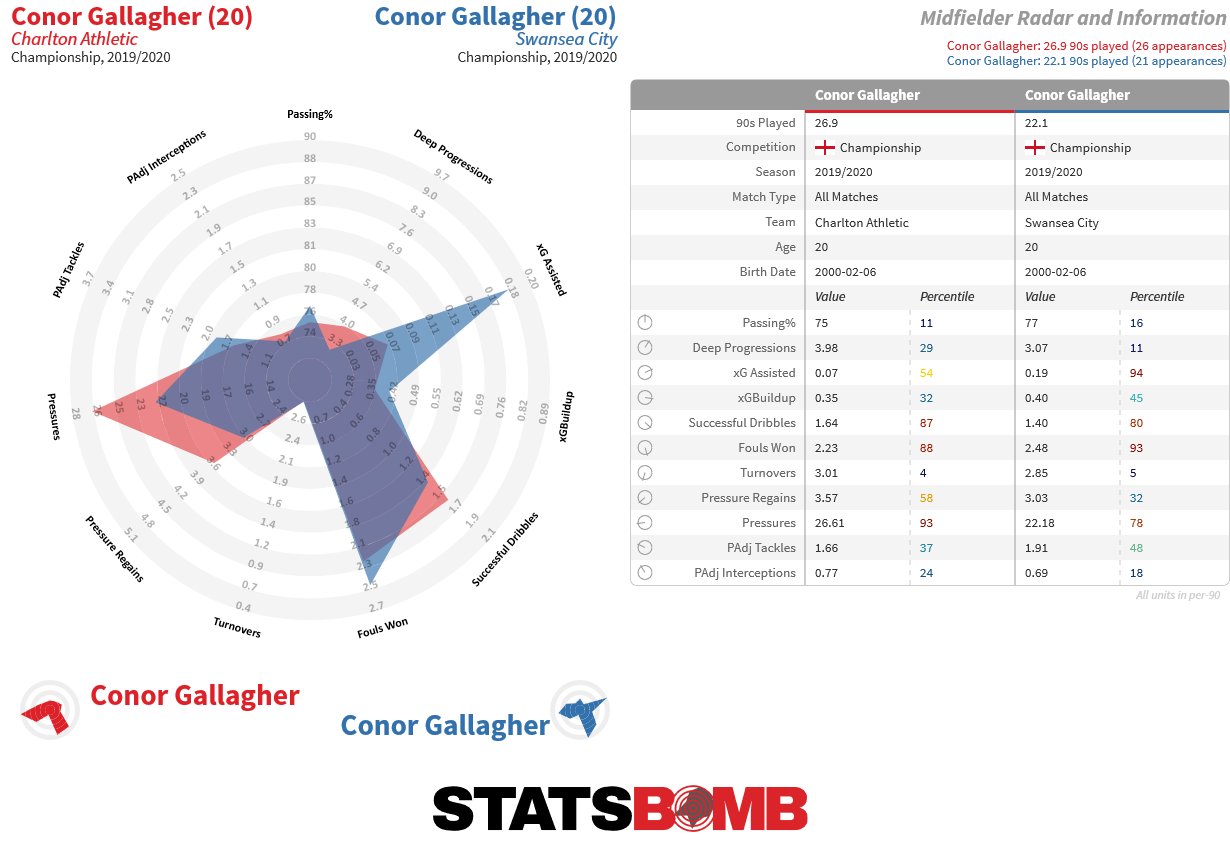
A hard-working youngster, without understanding his more withdrawn role at Charlton, it could be easy to believe he wasn't capable of being an attacking contributor, but empowered at Swansea and pushed more frequently into a central attacking midfield role, passes into the box from open play increased, his throughball rate rose, chances created came and assists followed. He's got genuine ability in front of the box, and there's just enough about him and Eze to wonder if Hodgson is looking at a change of tack and getting a rare central creator into his side.
All evidence is that Eze and Gallagher are talented players, but they could bring their best game, and still find it hard to shine in this team. They will hopefully get ample chance to prove their promise but if the season gets gritty, will Hodgson bunker down?
Projection The gambling community is understandably well aware of the risks surrounding Palace's near term potential and Sporting Index opened up with a sub-40 point, fifth worst projection. Palace have averaged below a point a game in 2020, and won four from 18 in that period. The trending is wrong and it will take distinct and real change to the team's metrics to give them a chance of steering clear of a relegation battle. Hodgson has been in the game long enough to see the warning signs and in most Premier League seasons there are double the amount of teams that perform at a level to put themselves into the relegation mix, so he may like the chances of winning a coin flip. But planning and execution of strategy are what limit risks such as this, and having been reactive rather than proactive in turning over their squad it could well be tough for the club. Offered seventeenth today, you'd have to take it.
If you're a club, media or gambling entity and want to know more about what StatsBomb can do for you, please contact us at Sales@StatsBomb.com We also provide education in this area, so if this taste of football analytics sparked interest, check out our Introduction to Football Analytics course Follow us on twitter in English and Spanish and also on LinkedIn
It was 12 months ago that we at StatsBomb proclaimed, to many a raised eyebrow and sanity check, that this newly-promoted Sheffield United side had every capability of mounting an instant challenge for a European place. Just kidding. Of course we didn’t. Nobody did. Even the most optimistic disciples of Chris Wilder and Alan Knill’s managerial abilities - A.K.A Blades supporters - would’ve scoffed at any suggestion they were about to fall just short of a top-seven finish in their return to the top flight, and yet at the same time maybe they wouldn’t have held much disbelief after all. Another season of overachievement would only be following the trend at this point, such has been the rapid and sustained ascent under their four years of management. Only a post-lockdown dip put paid to their European hopes but a 9th placed finish in your first top flight season since 2007 on comfortably the lowest budget in the division? Fans would bite your hand off and probably take a bit of arm and torso too, though it’s easy to imagine the relentlessly ambitious Wilder curling a lip at the idea of a late season dip in form, despite acknowledging prior to June’s fixture vs Manchester United that this was “A Ford Fiesta against a Ferrari”. Relegation favourites in pre-season, Sheffield United not only survived, they thrived. Of course, Wilder and Knill are responsible for setting the team up in the way that has generated this level of success, but the players take full credit for their execution of the game plan as well. The most commonly used ‘back 9’ in United’s 3-5-2 shape, i.e. all but the two forwards, each played 75% or more of the available minutes in the league. Not only was the team selection incredibly consistent, but every single one of the nine had played for the Blades in the Championship the season before. It shouldn’t go unsaid that the post-lockdown drop off coincided with a couple of injuries to members of the Reliable Nine, which only speaks to the necessity that each player knows and understands not only their role in the team but also those of their teammates in order for the sum to be greater than its parts. As much as was rightly made of the tactical novelty and innovation within the side going into and during the season, in the end it didn’t necessarily make for entertaining viewing for the goal-hungry neutral. The promotion-winning 3-4-1-2 shape was adapted to a more compact 3-5-2; personnel wise it saw the creative-but-slight Mark Duffy replaced by the three-lunged John Lundstram. The product was more suited to coping with the higher quality of opposition but games involving the Blades saw just 78 goals at an average of 2.05 per game – a Premier League low. It was a tweak to the system rather than an overhaul, the same principles of play remained: telepathic rotations and combination play, a focus on wide overloads, and a desire to create quality rather than quantity. Just like their Championship promotion season, Sheffield United again had the closest average Shot Distance in the league in 2019/20, whilst their xG/shot – the average expected conversion rate of their shots – was in esteemed company, bettered only by Man City and Arsenal and even a touch better than Liverpool’s. 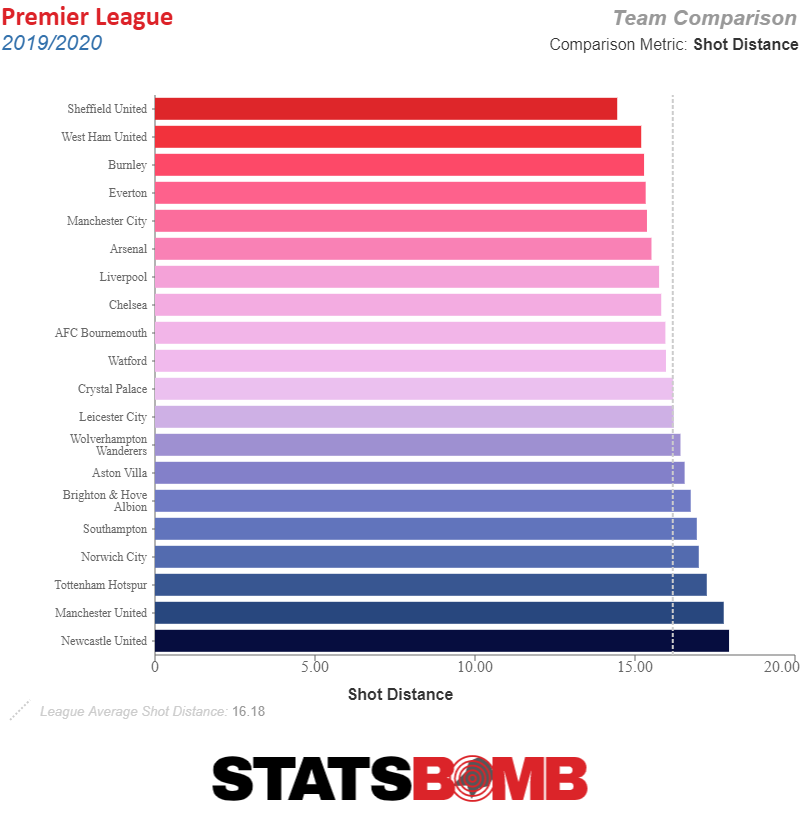 Having a laser-focus on creating quality opportunities negated the fact that they actually took the fewest shots in the league, only adding to the novelty of the Blades’ methods – creating fewer shots than all three relegated sides and the rest is not something you’d associate with a team pushing for European qualification but, unusual though it may be, it did the job. The reason for this ‘low volume / high quality’ aspect of their attacking play is their propensity for crossing both from deep and through combinations to get to the byline. Tough passes to execute but often leading to chances from central areas and close to goal when they did connect. Their wing play and crossing approach was ably supported, of course, by – get your klaxons ready people – the overlapping centre backs. Player of the year Chris Basham’s performances have led to the Bramall Lane stands christening his position the ‘Basham role’, and his pass map from right and central areas in the opposition half highlight how often he got forward to add extra numbers to United’s play in the attacking phase.
Having a laser-focus on creating quality opportunities negated the fact that they actually took the fewest shots in the league, only adding to the novelty of the Blades’ methods – creating fewer shots than all three relegated sides and the rest is not something you’d associate with a team pushing for European qualification but, unusual though it may be, it did the job. The reason for this ‘low volume / high quality’ aspect of their attacking play is their propensity for crossing both from deep and through combinations to get to the byline. Tough passes to execute but often leading to chances from central areas and close to goal when they did connect. Their wing play and crossing approach was ably supported, of course, by – get your klaxons ready people – the overlapping centre backs. Player of the year Chris Basham’s performances have led to the Bramall Lane stands christening his position the ‘Basham role’, and his pass map from right and central areas in the opposition half highlight how often he got forward to add extra numbers to United’s play in the attacking phase. 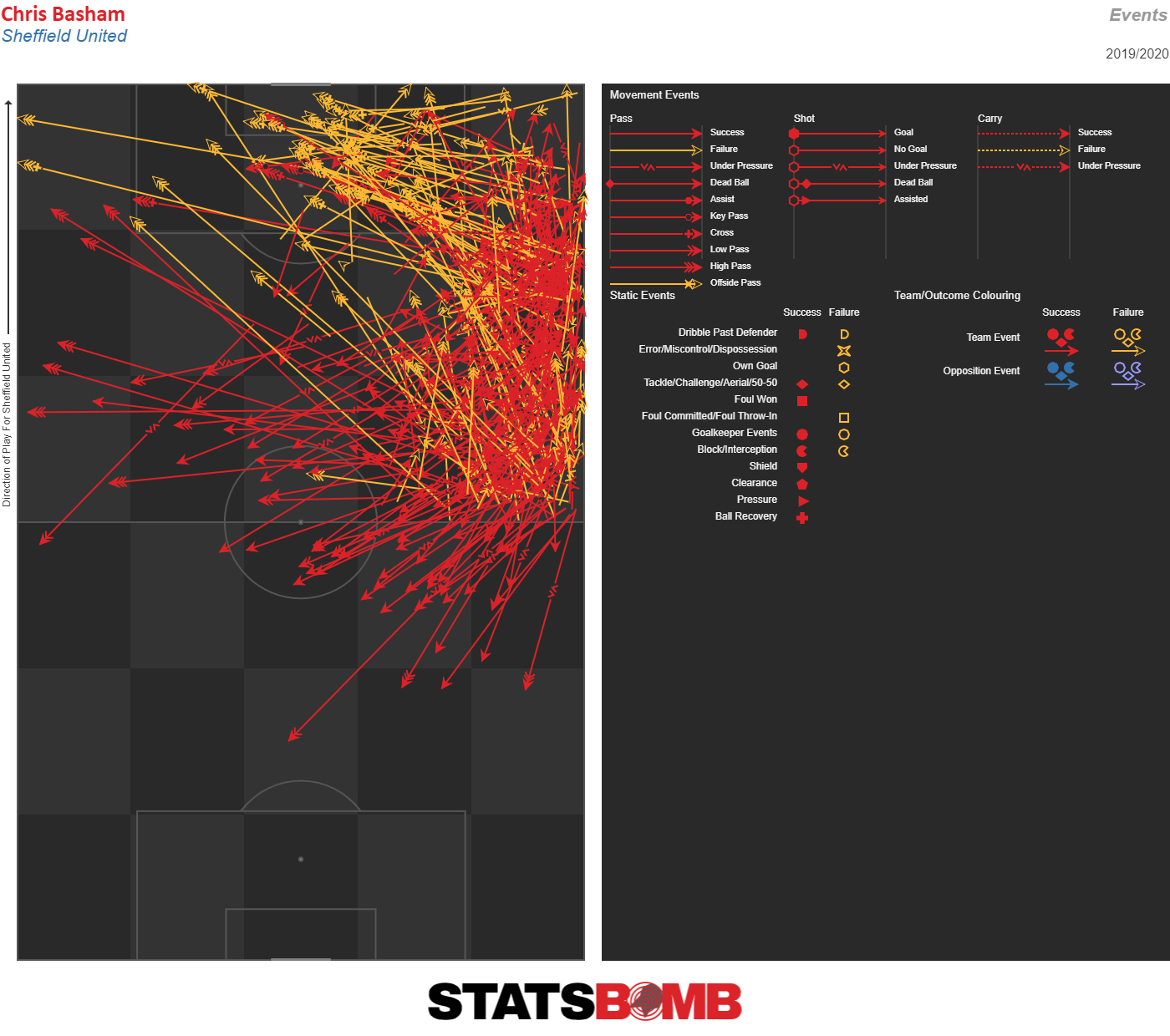 Of course, there’s little reason to focus on their attacking play when it’s the defence that powered the Blades to their lofty finish. Conceding just 39 goals as a newly promoted team, a number bettered only by the eventual top three, takes some doing. Creating openings did not come easy to their opponents, even the “Ferraris”: games against Chelsea, Spurs and Arsenal returned three wins, three draws, no defeats. Three elements forged this Steel City defence. The first was limiting the opportunities their opposition were able to generate, with the sheer number of bodies United would have in the centre of the park both in the defensive and the midfield lines often doing a fine job of congesting that area and forcing the opposition to look for openings elsewhere – the 11.32 shots conceded per game was 8th fewest. Of the sides that had a better record, only Everton finished below them.
Of course, there’s little reason to focus on their attacking play when it’s the defence that powered the Blades to their lofty finish. Conceding just 39 goals as a newly promoted team, a number bettered only by the eventual top three, takes some doing. Creating openings did not come easy to their opponents, even the “Ferraris”: games against Chelsea, Spurs and Arsenal returned three wins, three draws, no defeats. Three elements forged this Steel City defence. The first was limiting the opportunities their opposition were able to generate, with the sheer number of bodies United would have in the centre of the park both in the defensive and the midfield lines often doing a fine job of congesting that area and forcing the opposition to look for openings elsewhere – the 11.32 shots conceded per game was 8th fewest. Of the sides that had a better record, only Everton finished below them. 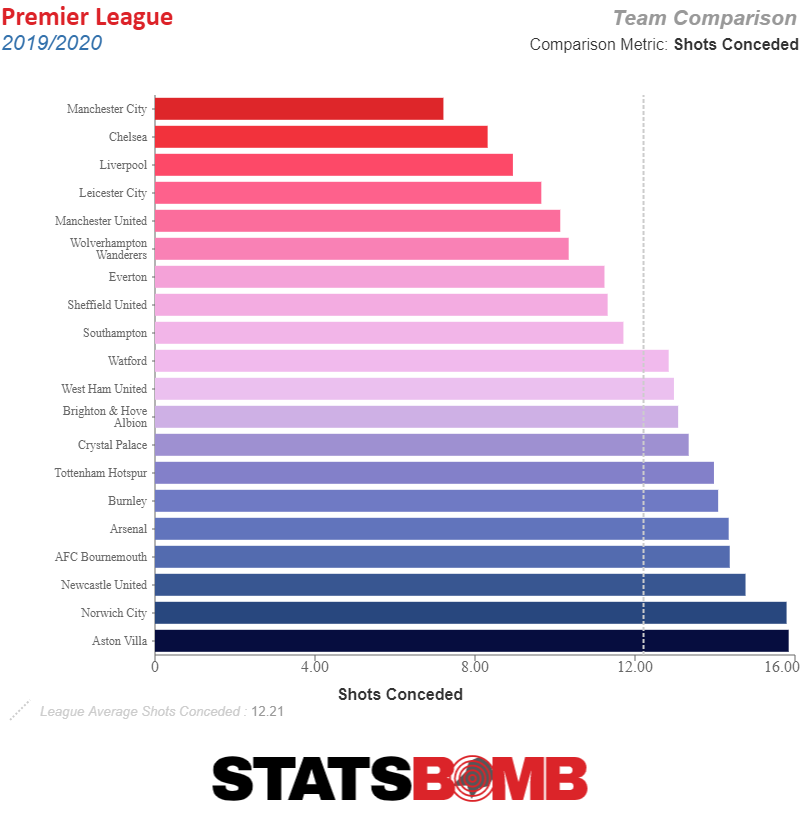 The second element? Dean Henderson. When their opponents did generate a shot, they often found the Manchester United loanee in the sort of form that catapulted him into immediate England contention, earning him a first senior callup in October. Henderson particularly excelled in the old-fashioned arts of goalkeeping: taking pressure off the defence by claiming crosses and making saves that you shouldn’t necessarily expect him to make. Lastly, the Blades performed well on set play’s once again, though this time the acclaim comes on the defensive end, tying with Leicester for the fewest set play goals conceded with 6. When combined, these elements made for a stubborn defence that gave United a reasonable chance of taking a result from virtually every game they played in the 2019/20 season. Unfortunately, Henderson’s form was too good for the decision makers at Old Trafford to ignore and he looks set to compete with David De Gea for the #1 jersey there in 2020/21. Wilder and his recruitment team moved quickly to replace him, spending £18.5 million on bringing Aaron Ramsdale in from relegated Bournemouth. Not far behind Henderson in the England pecking order, Ramsdale will be hoping he can follow in his predecessor’s footsteps and comes with decent pedigree and an upwardly mobile trajectory mirroring that of his new club; capped 26 times in England’s age group squads and also comes in on the back of winning Young Player of the Year at AFC Wimbledon in 2018/19 and Supporters Player of the Year at Bournemouth in 2019/20.
The second element? Dean Henderson. When their opponents did generate a shot, they often found the Manchester United loanee in the sort of form that catapulted him into immediate England contention, earning him a first senior callup in October. Henderson particularly excelled in the old-fashioned arts of goalkeeping: taking pressure off the defence by claiming crosses and making saves that you shouldn’t necessarily expect him to make. Lastly, the Blades performed well on set play’s once again, though this time the acclaim comes on the defensive end, tying with Leicester for the fewest set play goals conceded with 6. When combined, these elements made for a stubborn defence that gave United a reasonable chance of taking a result from virtually every game they played in the 2019/20 season. Unfortunately, Henderson’s form was too good for the decision makers at Old Trafford to ignore and he looks set to compete with David De Gea for the #1 jersey there in 2020/21. Wilder and his recruitment team moved quickly to replace him, spending £18.5 million on bringing Aaron Ramsdale in from relegated Bournemouth. Not far behind Henderson in the England pecking order, Ramsdale will be hoping he can follow in his predecessor’s footsteps and comes with decent pedigree and an upwardly mobile trajectory mirroring that of his new club; capped 26 times in England’s age group squads and also comes in on the back of winning Young Player of the Year at AFC Wimbledon in 2018/19 and Supporters Player of the Year at Bournemouth in 2019/20. 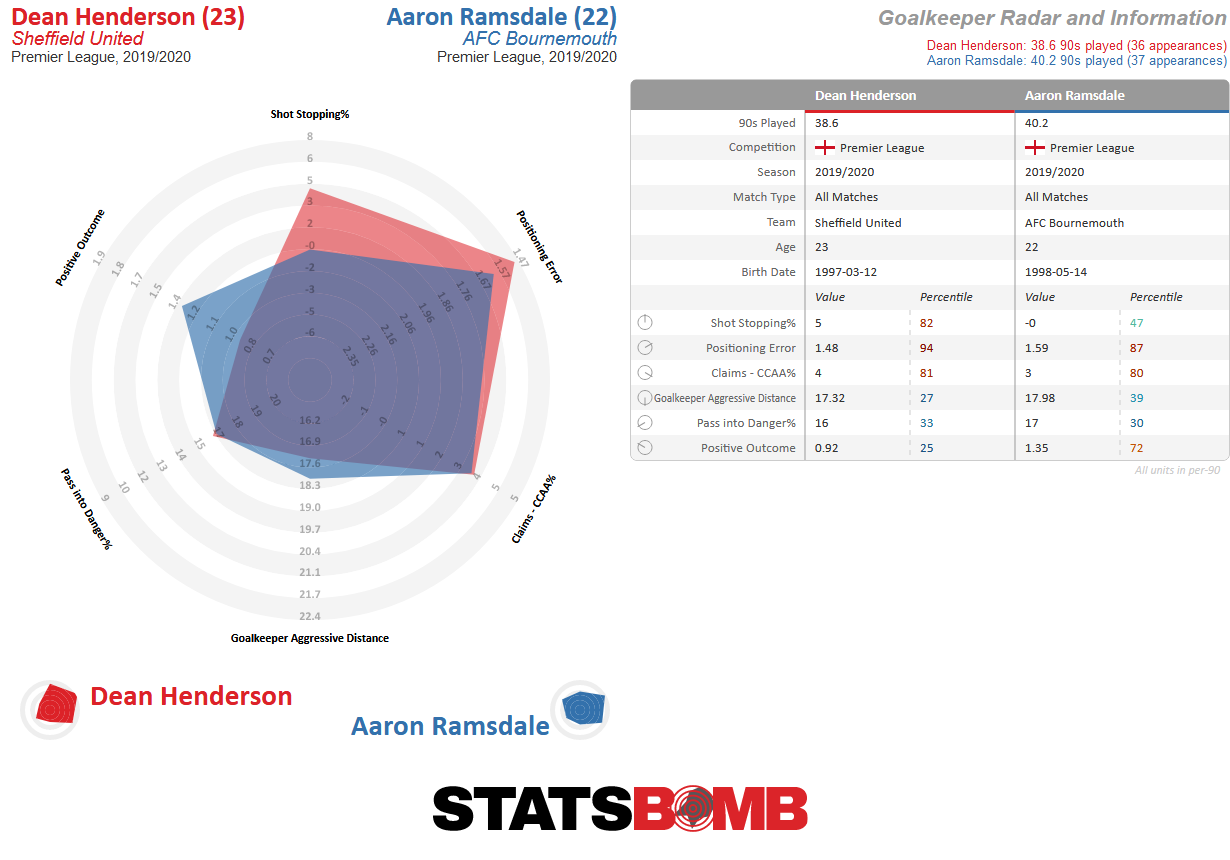 To date, only Wes Foderingham as a backup ‘keeper has followed Ramsdale through the door, but it’s clear that the Blades will be targeting a bit more quality in the middle and top end of the pitch in order to enhance their attacking output. Links with Matty Cash who had an impressive season for Nottingham Forest make sense – the winger-turned-right-back would provide quality in the final third, though the intensity of those links seem to have died down in recent weeks. A deal for Reading’s John Swift would also add some much-needed creativity to the Blades midfield line and could make the difference in games when they’re on top and in search of a breakthrough. Swift’s last two seasons in the Championship have seen him regularly demonstrate his creative capabilities, but he also has a dribbling ability that has been missing from Sheffield United’s arsenal in the last couple of seasons.
To date, only Wes Foderingham as a backup ‘keeper has followed Ramsdale through the door, but it’s clear that the Blades will be targeting a bit more quality in the middle and top end of the pitch in order to enhance their attacking output. Links with Matty Cash who had an impressive season for Nottingham Forest make sense – the winger-turned-right-back would provide quality in the final third, though the intensity of those links seem to have died down in recent weeks. A deal for Reading’s John Swift would also add some much-needed creativity to the Blades midfield line and could make the difference in games when they’re on top and in search of a breakthrough. Swift’s last two seasons in the Championship have seen him regularly demonstrate his creative capabilities, but he also has a dribbling ability that has been missing from Sheffield United’s arsenal in the last couple of seasons. 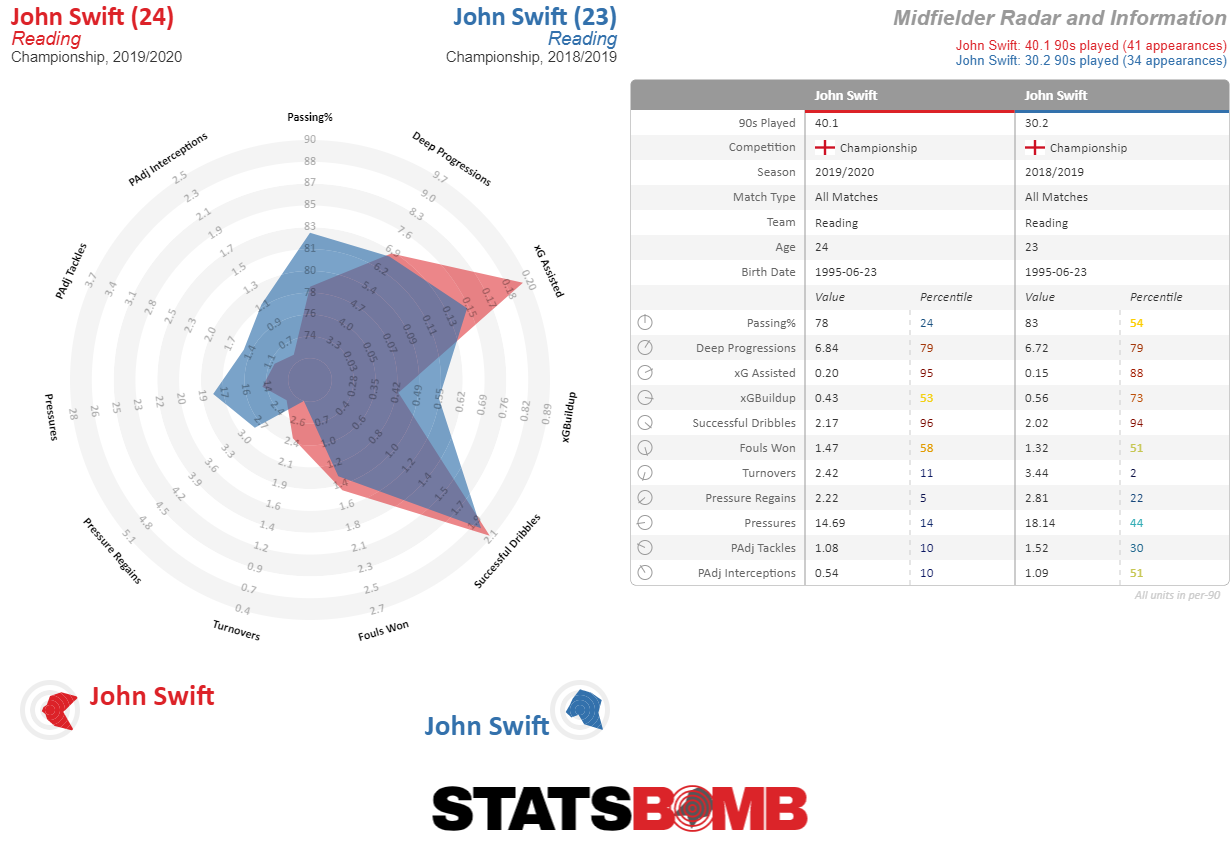 A refresh will also be needed up top soon, if not now. Despite his well-documented finishing issues, David McGoldrick remains a key cog in the Sheffield United frontline for his all-round play but at 32 will need more help and sooner rather than later. Oli McBurnie will be hoping to improve his goal output despite a reasonable first season in red-and-white overall, whilst Lys Mousset sneakily finished the season with 0.67 Goals+Assists per 90 minutes played, but lacked the fanfare due to rarely being able to get on the pitch and lacking the same contribution in other areas of the game that McGoldrick and McBurnie are able to make. Billy Sharp can always be counted on to poach goals but, at 34, isn’t likely to see an increase on the 1134 minutes he played in 2019/20. You can’t help but wonder what would now represent a season of over or underachievement for United given expectation levels are having to realign themselves once again. There’s no two ways about it, the element of surprise has gone and the opposition will know what to expect from them this time around, whilst conceding the 4th-fewest goals in the league will be a tough act to repeat. That said, Wilder will be expecting his attacking players to make a larger contribution to compensate for that and it’s likely that he’ll be challenging his players to go and repeat their achievements now they’ve already proven that it can be done. Repeating or improving on the 9th place finish will undoubtedly be a challenge but you sense that failing to do so may not represent a step backwards for this side anyway. A season of further consolidation may just be the springboard United need in order to hurl themselves through another glass ceiling further down the line.
A refresh will also be needed up top soon, if not now. Despite his well-documented finishing issues, David McGoldrick remains a key cog in the Sheffield United frontline for his all-round play but at 32 will need more help and sooner rather than later. Oli McBurnie will be hoping to improve his goal output despite a reasonable first season in red-and-white overall, whilst Lys Mousset sneakily finished the season with 0.67 Goals+Assists per 90 minutes played, but lacked the fanfare due to rarely being able to get on the pitch and lacking the same contribution in other areas of the game that McGoldrick and McBurnie are able to make. Billy Sharp can always be counted on to poach goals but, at 34, isn’t likely to see an increase on the 1134 minutes he played in 2019/20. You can’t help but wonder what would now represent a season of over or underachievement for United given expectation levels are having to realign themselves once again. There’s no two ways about it, the element of surprise has gone and the opposition will know what to expect from them this time around, whilst conceding the 4th-fewest goals in the league will be a tough act to repeat. That said, Wilder will be expecting his attacking players to make a larger contribution to compensate for that and it’s likely that he’ll be challenging his players to go and repeat their achievements now they’ve already proven that it can be done. Repeating or improving on the 9th place finish will undoubtedly be a challenge but you sense that failing to do so may not represent a step backwards for this side anyway. A season of further consolidation may just be the springboard United need in order to hurl themselves through another glass ceiling further down the line.
If you're a club, media or gambling entity and want to know more about what StatsBomb can do for you, please contact us at Sales@StatsBomb.com We also provide education in this area, so if this taste of football analytics sparked interest, check out our Introduction to Football Analytics course Follow us on twitter in English and Spanish and also on LinkedIn
Ahead of 2019-20, on the surface, it was relatively easy to be positive about the future for Tottenham. Fresh from another top four finish and a memorable run to the Champions League final, the club had finally secured the future of its midfield by acquiring Giovani Lo Celso on a loan-to-buy deal from Real Betis while Tanguy Ndombélé had arrived for a large fee from Lyon. Sure, the club had no rotation for Harry Kane and their metrics had been declining alarmingly for 18 months, but what could go wrong? A TV show was even commissioned! 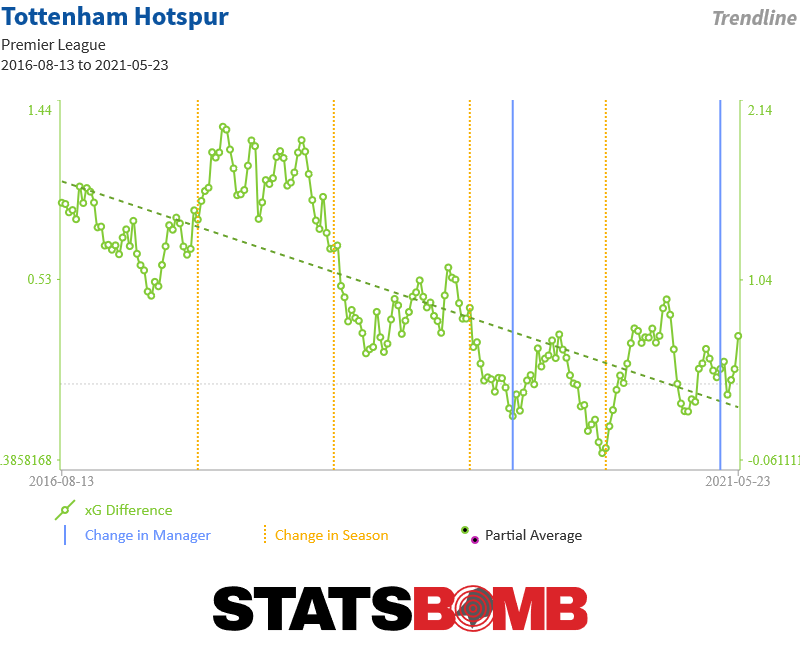 Well, the first thing that went wrong was that the metrics got worse. The second thing that went wrong was the results were terrible. The third thing that went wrong was Mauricio Pochettino was fired. Really, this was all just one large thing that engulfed the club in a manner befitting of a 22-minute segment in a documentary. There was no way around it though, Tottenham had three wins from twelve in the league, had deserved no more from their performances and had been annihilated 7-2 in the Champions League by a promising German side, Bayern Munich. Enter Mourinho. On the surface the 26 league games Mourinho has overseen have been just about good enough. Tottenham got 45 points (65 point pace) which ranked fourth and their goal difference of +13 ranked fourth too. What that conceals is that Mourinho’s tenure has already been through three distinct acts, and the main hope for fans is that the most recent of those acts involved winning more frequently than not. It's also challenging to get used to a Tottenham team that plays very different football to that of the best of Pochettino--and by the time of his departure, despite the Champions League run, that best was a long time passed. Act 1: Duration: 8 games in 2019 Results: 5-1-2 GD: +6 xG: +5 Note: xG Against at 0.65 per game is best in the league The start for Mourinho was promising but didn't come without disappointments. Defeats against his two former clubs, Manchester United (2-1 at Old Trafford in a low event game decided by a Marcus Rashford penalty) and Chelsea (2-0 at home, a Willian penalty sealing the deal soon after renowned hatchet man Son Heung-min was sent off) were classics in the "create nothing, try not to lose" Mourinho canon. Elsewhere the team won five from six before the turn of the new year and certain metrics shone brightly; in defence, the team was giving up very few shots, specifically in good, central dangerous locations. Occasional penalties apart, Tottenham were repelling all. Yes, the schedule was quite kind, but there was a win over Wolves in there too alongside more straightforward victories against lower ranked teams such as Burnley, West Ham, Brighton and Bournemouth. Something to build on? Act 2: Duration: 9 games in a world gradually learning about coronaviruses Results: 3-2-4 GD: +0 xG: -5 Note: xG Against at 1.82 per game is second worst in the whole league The second act was not-so-good. In fact it was downright bad. The schedule bit a little with defeats against Southampton (1-0, created nothing), Liverpool (1-0, played surprisingly well, at least in the second half), Chelsea (again 2-1, this time created nothing, deserved nothing) and Wolves (3-2, overpowered late on, gave it away). There was also a 2-0 win against Manchester City which was as equally improbable as the 2-2 draw earlier in the season at the Etihad. In both games City did enough to win multiple games but somehow couldn't get anything to stick. But the underlying concern came in the same form that had looked so promising weeks before. The defence faltered horribly, moving from league best to nearly league worst and in every one of these nine games Tottenham allowed xG worth between 1.4 to 3.7 per game. They didn't have a single defensively secure game all through and were averaging 16 shots per game against. Really grim stuff. Tottenham also departed the Champions League after being significantly worse than RB Leipzig and lost in the FA Cup on penalties to Norwich, the kind of result that is hard to explain away when you know, deep down, the manager would like to nab a trophy and quick. When the curtains came down on football, they had lost five out of six, and were limping along having been left weakened by injuries to key men such as Kane and Son. Act 3: Duration: 9 games, summer is here and so is your Premier League finale Results: 5-3-1 GD: +7 xG: -2 Note: xG For is 15th, xG Against is 6th Turns out a three month break does wonders for the health of a squad! With Kane and Son back fit, the back end of 2019-20 held a degree of promise. Results were generally good. Performances were... less so. The 0-0 with Bournemouth was about as poorly as Tottenham have played in memory, with the Sheffield United defeat not far behind. Tottenham's attack created very little during this spell: in six of nine games the took ten or fewer shots or failed to create more than one expected goal. To brazenly defy expected goals they also took the lead three times via an own goal. The only game in which the result happily matched expectation was the 2-1 derby win over Arsenal. The defence was sturdier--in four of nine games the expected goals allowed was less than one--and in two further games it was just a shade over. Overall, it's impossible to be analytically inclined and generally happy with how performances have developed across the Mourinho reign, but the better post-break results certainly eased pressure that had been building, even this quickly into his tenure. Style Undoubtedly the style of play is very different. After five hard years, the Pochettino press had already somewhat waned a deal of time before his departure:
Well, the first thing that went wrong was that the metrics got worse. The second thing that went wrong was the results were terrible. The third thing that went wrong was Mauricio Pochettino was fired. Really, this was all just one large thing that engulfed the club in a manner befitting of a 22-minute segment in a documentary. There was no way around it though, Tottenham had three wins from twelve in the league, had deserved no more from their performances and had been annihilated 7-2 in the Champions League by a promising German side, Bayern Munich. Enter Mourinho. On the surface the 26 league games Mourinho has overseen have been just about good enough. Tottenham got 45 points (65 point pace) which ranked fourth and their goal difference of +13 ranked fourth too. What that conceals is that Mourinho’s tenure has already been through three distinct acts, and the main hope for fans is that the most recent of those acts involved winning more frequently than not. It's also challenging to get used to a Tottenham team that plays very different football to that of the best of Pochettino--and by the time of his departure, despite the Champions League run, that best was a long time passed. Act 1: Duration: 8 games in 2019 Results: 5-1-2 GD: +6 xG: +5 Note: xG Against at 0.65 per game is best in the league The start for Mourinho was promising but didn't come without disappointments. Defeats against his two former clubs, Manchester United (2-1 at Old Trafford in a low event game decided by a Marcus Rashford penalty) and Chelsea (2-0 at home, a Willian penalty sealing the deal soon after renowned hatchet man Son Heung-min was sent off) were classics in the "create nothing, try not to lose" Mourinho canon. Elsewhere the team won five from six before the turn of the new year and certain metrics shone brightly; in defence, the team was giving up very few shots, specifically in good, central dangerous locations. Occasional penalties apart, Tottenham were repelling all. Yes, the schedule was quite kind, but there was a win over Wolves in there too alongside more straightforward victories against lower ranked teams such as Burnley, West Ham, Brighton and Bournemouth. Something to build on? Act 2: Duration: 9 games in a world gradually learning about coronaviruses Results: 3-2-4 GD: +0 xG: -5 Note: xG Against at 1.82 per game is second worst in the whole league The second act was not-so-good. In fact it was downright bad. The schedule bit a little with defeats against Southampton (1-0, created nothing), Liverpool (1-0, played surprisingly well, at least in the second half), Chelsea (again 2-1, this time created nothing, deserved nothing) and Wolves (3-2, overpowered late on, gave it away). There was also a 2-0 win against Manchester City which was as equally improbable as the 2-2 draw earlier in the season at the Etihad. In both games City did enough to win multiple games but somehow couldn't get anything to stick. But the underlying concern came in the same form that had looked so promising weeks before. The defence faltered horribly, moving from league best to nearly league worst and in every one of these nine games Tottenham allowed xG worth between 1.4 to 3.7 per game. They didn't have a single defensively secure game all through and were averaging 16 shots per game against. Really grim stuff. Tottenham also departed the Champions League after being significantly worse than RB Leipzig and lost in the FA Cup on penalties to Norwich, the kind of result that is hard to explain away when you know, deep down, the manager would like to nab a trophy and quick. When the curtains came down on football, they had lost five out of six, and were limping along having been left weakened by injuries to key men such as Kane and Son. Act 3: Duration: 9 games, summer is here and so is your Premier League finale Results: 5-3-1 GD: +7 xG: -2 Note: xG For is 15th, xG Against is 6th Turns out a three month break does wonders for the health of a squad! With Kane and Son back fit, the back end of 2019-20 held a degree of promise. Results were generally good. Performances were... less so. The 0-0 with Bournemouth was about as poorly as Tottenham have played in memory, with the Sheffield United defeat not far behind. Tottenham's attack created very little during this spell: in six of nine games the took ten or fewer shots or failed to create more than one expected goal. To brazenly defy expected goals they also took the lead three times via an own goal. The only game in which the result happily matched expectation was the 2-1 derby win over Arsenal. The defence was sturdier--in four of nine games the expected goals allowed was less than one--and in two further games it was just a shade over. Overall, it's impossible to be analytically inclined and generally happy with how performances have developed across the Mourinho reign, but the better post-break results certainly eased pressure that had been building, even this quickly into his tenure. Style Undoubtedly the style of play is very different. After five hard years, the Pochettino press had already somewhat waned a deal of time before his departure:  Despite clear mentions of pressing in the Amazon documentary, it doesn't really come out in the metrics. Tottenham may still work hard, but not as high up the pitch as before. The signing of Steven Bergwijn defines what Mourinho wants from his non-Kane attackers. Quick and able to stretch defences especially on the break, Bergwijn's talents categorise neatly alongside Lucas Moura and Son. Midfield has been a problem for Tottenham for a number of seasons, and Mourinho's solution was somewhat creative: try to bypass it.
Despite clear mentions of pressing in the Amazon documentary, it doesn't really come out in the metrics. Tottenham may still work hard, but not as high up the pitch as before. The signing of Steven Bergwijn defines what Mourinho wants from his non-Kane attackers. Quick and able to stretch defences especially on the break, Bergwijn's talents categorise neatly alongside Lucas Moura and Son. Midfield has been a problem for Tottenham for a number of seasons, and Mourinho's solution was somewhat creative: try to bypass it. 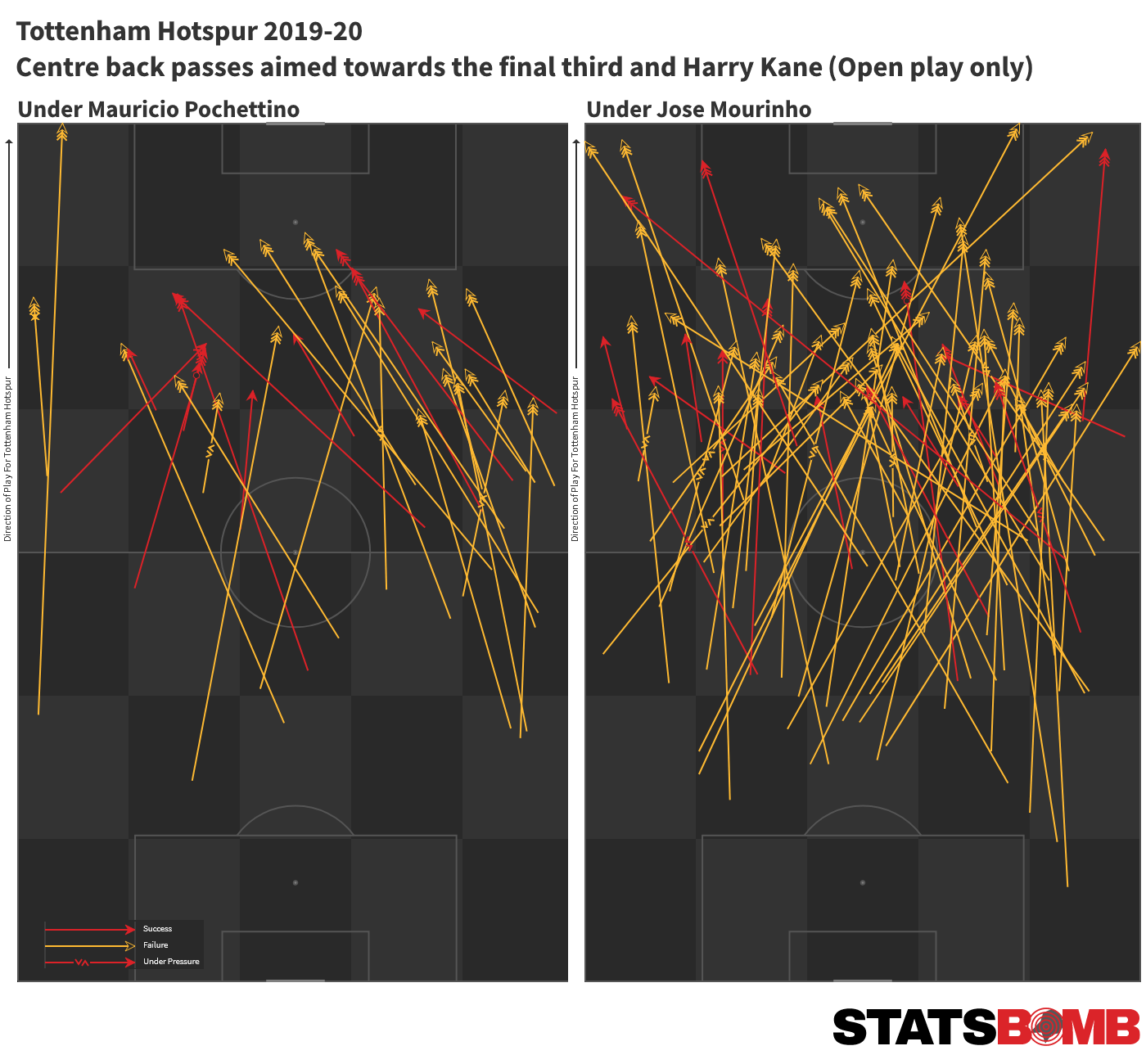 The change here from the steadier possession game deployed by Pochettino to a more direct targeted passing system was notable. The graphic shows balls aimed at Kane from centre backs in open play, and this type of pass went from three per game under Pochettino with a huge skew towards Alderweireld (over two-thirds of these passes were from him) to over five per game under Mourinho, with all the centre backs looking for this ball. The other attackers saw a similar uptick in receiving targeted long passes too, with Son, Lucas and eventually Bergwijn under Mourinho combining to receive nearly six of these passes per game up from three, and again a large skew away from just Alderweireld towards all centre backs. Both goalkeepers looked for similar out balls too, with a large rise in any keeper clearance (dead ball or otherwise) aimed at the forwards. This is also where the signing of Matt Doherty is interesting, as he's shown himself to be well capable in competing for long, high balls and taking up an advanced position -- Serge Aurier already takes up similar roles but hasn't the aerial prowess to dominate opposing full backs. Doherty may well be able to do this and provide flicks and nod downs, to help release Tottenham's speedy forwards. It's not total football, but it could well be part of the Mourinho plan. Personnel The eternal dance at Tottenham between Chairman Daniel Levy and incumbent managers regarding player acquisition appears so far to not be taking place with Mourinho. Players that have been recruited are not wildly expensive or apparently indulgent and may well be better than the raw detail suggests. The talent within the Tottenham squad is impossible to deny, from World Cup winner Hugo Lloris in goal right through to Kane up front. But supporting roles have waned over time, and the signings of Pierre-Emile Højbjerg and Doherty in particular, appear to show the intent to solidify key positions to perhaps allow the gifted attackers to flourish. There are distinct "do everything, but just a bit" vibes to Højbjerg's metrics in particular, but perhaps that's what this team needs: consistency and stability.
The change here from the steadier possession game deployed by Pochettino to a more direct targeted passing system was notable. The graphic shows balls aimed at Kane from centre backs in open play, and this type of pass went from three per game under Pochettino with a huge skew towards Alderweireld (over two-thirds of these passes were from him) to over five per game under Mourinho, with all the centre backs looking for this ball. The other attackers saw a similar uptick in receiving targeted long passes too, with Son, Lucas and eventually Bergwijn under Mourinho combining to receive nearly six of these passes per game up from three, and again a large skew away from just Alderweireld towards all centre backs. Both goalkeepers looked for similar out balls too, with a large rise in any keeper clearance (dead ball or otherwise) aimed at the forwards. This is also where the signing of Matt Doherty is interesting, as he's shown himself to be well capable in competing for long, high balls and taking up an advanced position -- Serge Aurier already takes up similar roles but hasn't the aerial prowess to dominate opposing full backs. Doherty may well be able to do this and provide flicks and nod downs, to help release Tottenham's speedy forwards. It's not total football, but it could well be part of the Mourinho plan. Personnel The eternal dance at Tottenham between Chairman Daniel Levy and incumbent managers regarding player acquisition appears so far to not be taking place with Mourinho. Players that have been recruited are not wildly expensive or apparently indulgent and may well be better than the raw detail suggests. The talent within the Tottenham squad is impossible to deny, from World Cup winner Hugo Lloris in goal right through to Kane up front. But supporting roles have waned over time, and the signings of Pierre-Emile Højbjerg and Doherty in particular, appear to show the intent to solidify key positions to perhaps allow the gifted attackers to flourish. There are distinct "do everything, but just a bit" vibes to Højbjerg's metrics in particular, but perhaps that's what this team needs: consistency and stability. 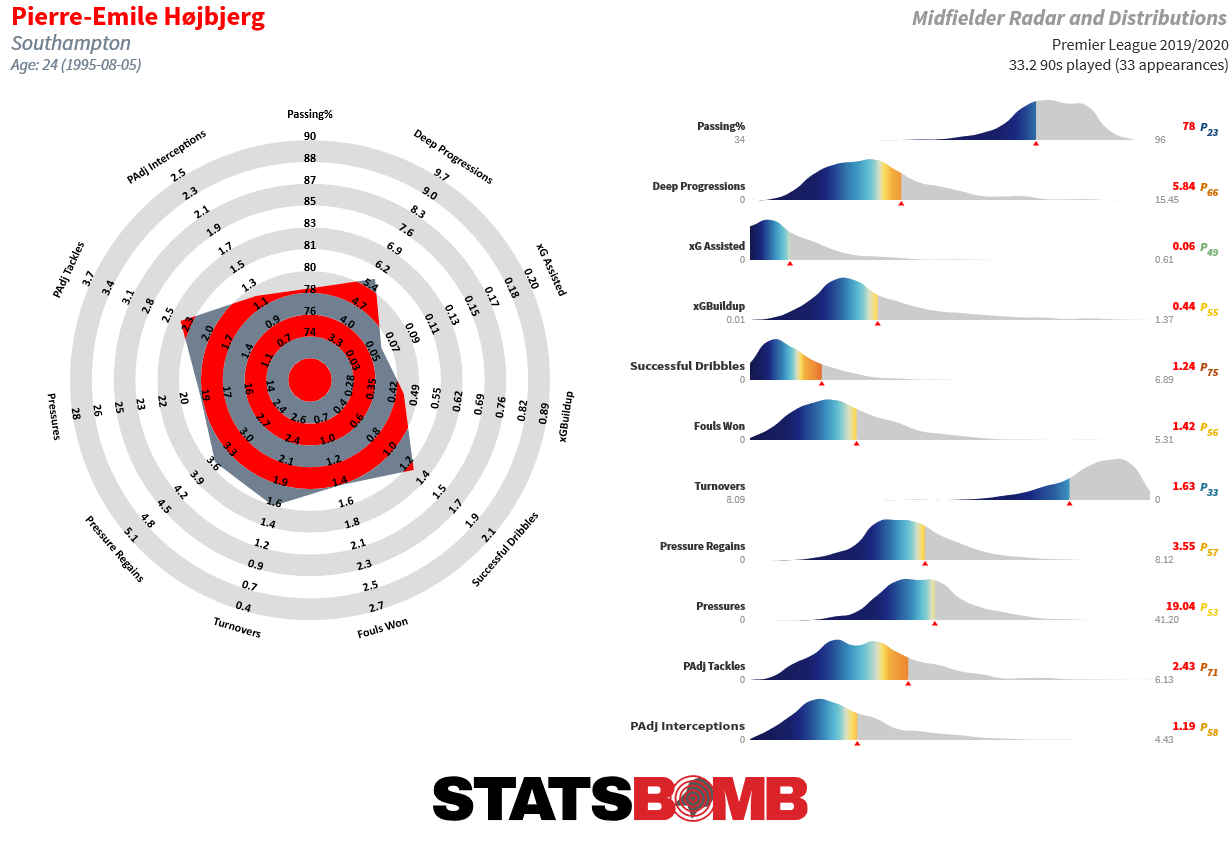 Will it work? Getting Højbjerg in as a likely guaranteed starter means we're unlikely to see Harry Winks and Moussa Sissoko start many games together with Giovani Lo Celso already the passing heartbeat of the side picked ahead of them. Doherty's arrival allows Aurier to depart and locks down one position. The attacking midfield band is rich with Dele Alli, Bergwijn, Moura, Son and Erik Lamela competing for a maximum of three positions. What of Tanguy Ndombélé? I'll plead the fifth, thanks. It's possible that the Frenchman's inability to nail down a starting place is indicative of the slightly altered transfer focus, as his signing combined with an investment in Jack Clarke and Ryan Sessegnon that is a long way off bearing fruit means £100m of summer 2019 purchases are not yet directly impacting the first team. Doherty and Højbjerg scope out at around £30m (and books are balancing a little more once Kyle Walker-Peters' departure is factored in) and will likely play every week. Getting purchases into the team and contributing counts for a lot. There are noises that more players could arrive, most notably a rotational striker, but in Covid-19 world, it's likely to be more book-balancing than big purchases, so it also depends who is on the outs. With football finishing only a month ago, we have fresh answers to long term questions. Whether Kane could refind something near to his best form after a six month break to recover from his latest injury appeared to be answered in the affirmative by a tidy finishing streak. To the casual eye he looked more dynamic than before, and whatever the truth is of his long term mobility and the impact of injuries on him, the work that he's put into his finishing over the course of many years will likely carry him well into his latter career. It's also possible that there's a bias generated in seeing him score three goals from five throughball shots as it's never been an area in which he's been wildly prolific (10 goals from 31 such shots in the league across the previous four seasons). Still: at 2.5 shots per 90, albeit for a ten shot a game team, he needs the finishing to stay sharp to get the totals up and mini runs such as this will not persist long term:
Will it work? Getting Højbjerg in as a likely guaranteed starter means we're unlikely to see Harry Winks and Moussa Sissoko start many games together with Giovani Lo Celso already the passing heartbeat of the side picked ahead of them. Doherty's arrival allows Aurier to depart and locks down one position. The attacking midfield band is rich with Dele Alli, Bergwijn, Moura, Son and Erik Lamela competing for a maximum of three positions. What of Tanguy Ndombélé? I'll plead the fifth, thanks. It's possible that the Frenchman's inability to nail down a starting place is indicative of the slightly altered transfer focus, as his signing combined with an investment in Jack Clarke and Ryan Sessegnon that is a long way off bearing fruit means £100m of summer 2019 purchases are not yet directly impacting the first team. Doherty and Højbjerg scope out at around £30m (and books are balancing a little more once Kyle Walker-Peters' departure is factored in) and will likely play every week. Getting purchases into the team and contributing counts for a lot. There are noises that more players could arrive, most notably a rotational striker, but in Covid-19 world, it's likely to be more book-balancing than big purchases, so it also depends who is on the outs. With football finishing only a month ago, we have fresh answers to long term questions. Whether Kane could refind something near to his best form after a six month break to recover from his latest injury appeared to be answered in the affirmative by a tidy finishing streak. To the casual eye he looked more dynamic than before, and whatever the truth is of his long term mobility and the impact of injuries on him, the work that he's put into his finishing over the course of many years will likely carry him well into his latter career. It's also possible that there's a bias generated in seeing him score three goals from five throughball shots as it's never been an area in which he's been wildly prolific (10 goals from 31 such shots in the league across the previous four seasons). Still: at 2.5 shots per 90, albeit for a ten shot a game team, he needs the finishing to stay sharp to get the totals up and mini runs such as this will not persist long term: 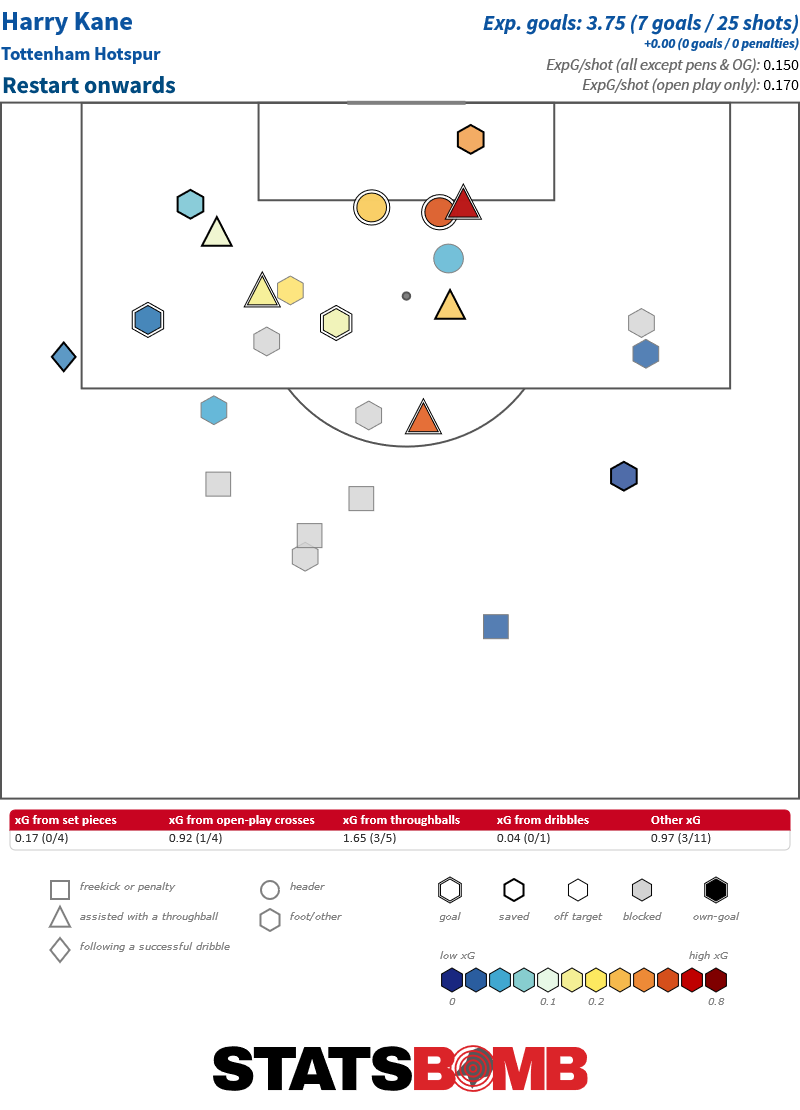 As important is the form of Son. A beacon of consistency in the aggregate throughout the good times, and not-so-good times, he has now registered four consecutive seasons oscillating close to a combined 0.7 per 90 for goals and assists, most usually ahead of expectation thanks to his versatile finishing. He can blow hot and cold at times from week to week, but when on-song, is as devastating an attacking midfielder as there is in the league:
As important is the form of Son. A beacon of consistency in the aggregate throughout the good times, and not-so-good times, he has now registered four consecutive seasons oscillating close to a combined 0.7 per 90 for goals and assists, most usually ahead of expectation thanks to his versatile finishing. He can blow hot and cold at times from week to week, but when on-song, is as devastating an attacking midfielder as there is in the league:  Projection Everything from a metric perspective at Tottenham has pointed downwards since the end of 2017-18, so the first thing to try and do is reverse that slide. Can Mourinho do that? His Zlatan-powered first Manchester United season was a legitimately dominant shooting team with a finishing problem, so there's a blueprint to get to a position of strength. The following season United finished second with 81 points despite less impressive metrics and season three is a well worn trail now. It's just about possible to give the benefit of the doubt and offer a pass for 2019-20 given weird circumstances and a mid-season appointment, but Tottenham will need to start well to keep any goodwill in the tank, and the Amazon documentary is dropping and building a whole new set of memes and storylines just as this season emerges. It's the Jose Mourinho Show again, and he needs to show he can still provide an above average return for his salary. Mourinho-era metrics don't yet offer solid encouragement, given how variable they have been. Teams with minus expected goal differences and minus shot counts simply don't earn high league positions in this league. The Sporting Index projection has Arsenal and Tottenham in the fifth and sixth slots, but no more than a result or two from below and significantly further away from Chelsea and Manchester United in the backend of the top four. Somewhere in the top four does represent the very best outcome, and a plan realised, but it is not the most likely outcome at all. However, if Tottenham can improve metrics and somehow stay in range of such an outcome deep into the season, all good, if not, then the Mourinho project may founder ahead of any expected three year timeline.
Projection Everything from a metric perspective at Tottenham has pointed downwards since the end of 2017-18, so the first thing to try and do is reverse that slide. Can Mourinho do that? His Zlatan-powered first Manchester United season was a legitimately dominant shooting team with a finishing problem, so there's a blueprint to get to a position of strength. The following season United finished second with 81 points despite less impressive metrics and season three is a well worn trail now. It's just about possible to give the benefit of the doubt and offer a pass for 2019-20 given weird circumstances and a mid-season appointment, but Tottenham will need to start well to keep any goodwill in the tank, and the Amazon documentary is dropping and building a whole new set of memes and storylines just as this season emerges. It's the Jose Mourinho Show again, and he needs to show he can still provide an above average return for his salary. Mourinho-era metrics don't yet offer solid encouragement, given how variable they have been. Teams with minus expected goal differences and minus shot counts simply don't earn high league positions in this league. The Sporting Index projection has Arsenal and Tottenham in the fifth and sixth slots, but no more than a result or two from below and significantly further away from Chelsea and Manchester United in the backend of the top four. Somewhere in the top four does represent the very best outcome, and a plan realised, but it is not the most likely outcome at all. However, if Tottenham can improve metrics and somehow stay in range of such an outcome deep into the season, all good, if not, then the Mourinho project may founder ahead of any expected three year timeline.
If you're a club, media or gambling entity and want to know more about what StatsBomb can do for you, please contact us at Sales@StatsBomb.com We also provide education in this area, so if this taste of football analytics sparked interest, check out our Introduction to Football Analytics course Follow us on twitter in English and Spanish and also on LinkedIn
In 2016-17, West Ham finished 11th with 45 points with below par metrics that roughly merited their points haul. By the start of the following November, Slaven Bilić had steered them downwards to 18th with bad metrics and a worse goal difference. He promptly exited and David Moyes was hired. Moyes did nothing for the underlying metrics (they were fairly stable at -0.5 xG per game across both managers) but eked out just enough from his team to keep them up. Moyes may have felt some displeasure at not being handed a longer tenure at that point but objectively, despite fulfilling the first remit of keeping the team in the Premier League, only a very charitable-minded review could say that he had improved his team. Mauricio Pellegrini was hired instead. In 2018-19, West Ham finished 10th with 52 points with below par metrics that did not merit their points haul. By end of the following December, Manuel Pellegrini had steered them downwards to 17th with a bad goal difference and worse metrics. He promptly exited and David Moyes was hired. Moyes did nothing for the underlying metrics (they were fairly stable at -0.6 xG per game across both managers) then the world fell apart, everyone stopped playing football and stayed in the house for three months. Pellegrini’s main issue had been a horribly open defence: the value of the shots they were giving up was higher than any other team in the league (0.13 xG/shot) and Moyes, ever the pragmatist, set about shutting that down. In the ten games before the suspension of play, West Ham recorded the lowest PPDA (pass per defensive action) value in the league (16.2). They had the deepest average defensive distance (39.8m). They were the least aggressive pressers of opponent ball receipts (19%). They had less of the ball than any other team. Translation for all that? They sat off. It had barely any effect though, as opponent shot quality remained high (0.12 xG/shot). Under either manager opponents could get nice and deep into the penalty box and grab good shots: 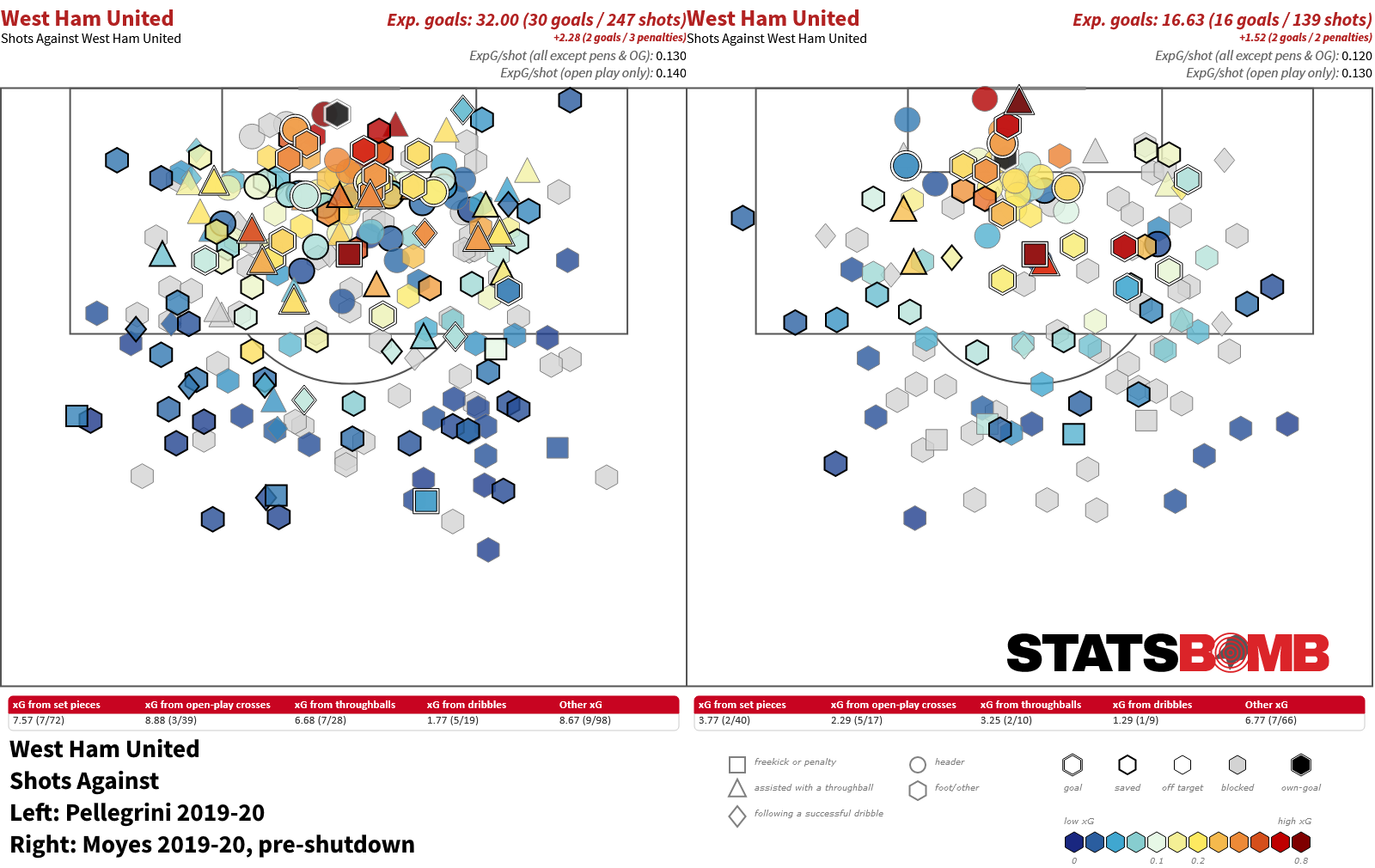 It’s an open question what may have happened to West Ham’s season had the viral intervention not occurred. The team were in sixteenth on 27 points, level with Watford and Bournemouth in seventeenth and eighteenth and with nine games left to rescue themselves from possible relegation. It's also an open question as to how reliable the form is of this concentrated post-lockdown period. Oddly, since leaving Everton and starting at Manchester United, Moyes has had four further managerial tenures, and apart from the summer of 2015 while in charge of Real Sociedad, the Covid break has been the only time he has had an extended period as a manager outside the grind of regular in season games. And given three months to prepare, Moyes managed to hit upon something that worked. The initial Moyes period did have the misfortune of some schedule stacking--they faced Liverpool twice, and Manchester City-- so there is room for some caution when considering the apparent improvement the team made, but he chopped and changed his formations in that early run, and post-lockdown stuck with a 4-2-3-1. As the season wound up, his starting eleven became more consistent too: Łukasz Fabiański in goal, a back four of Ryan Fredricks, Issa Diop, Angelo Ogbonna, Aaron Cresswell, Declan Rice and Tomáš Souček sitting, Pablo Fornals or Manuel Lanzini left, Jarrod Bowen right, Mark Noble's aging legs parked upfield as an attacking midfielder, at least in name, and Michail Antonio up front. This left a selection of expensive potential game-changers often manning the bench. Sébastien Haller, Andriy Yarmolenko and Felipe Anderson's combined cost was around £100m and they watched a good deal of football in those final weeks, occasionally, pitching in late on in games. The players that benefited most from Moyes' June reboot were the two January signings, Bowen and Souček and converted striker Antonio. Souček is a fascinating player for a central midfielder as despite many column inches being spent on the possibility of his midfield partner Rice becoming a centre back, at least from a data perspective he looks to have more centre back aligned tools. No central midfielder in the league got anywhere near his 5.1 aerial wins per 90 (next best was Phillip Billing at 3.4). He's also useful at the other end of the pitch as a goal threat in open play and from set-pieces having scored 30 goals in his last two seasons at Slavia Prague. He's added three more since arriving in England. He's a curious passer for a defensive midfielder too. Keeping the ball on the deck and playing short, he's just about secure enough (he completed over 90% of passes, still less than Rice's 95%) but as soon as he puts the ball forward and in the air it drops to 40% (down from 60% at Slavia). Quick analysis suggests that quite a lot of these failed attempts are out balls aimed at Antonio or Bowen, and Rice scopes out better at those too. Add Noble into the mix, who nominally played in the middle of the attacking midfield band as the season drew to a close, but effectively sat a lot closer to the other two defensive midfielders, and we see a clear strategy--find Antonio or Bowen if you can--that is effective only sporadically. Just 28% of high and longer passes from their own half forward and into the opponent half are finding their intended target. All this feeds into the idea of what you can get from Bowen and Antonio. Each is effective at carrying the ball deep into opposition territory (as is Felipe Anderson, moreso even, across the whole season, he ranks second behind Adama Traoré for these long carries) and are a danger to the opponent's goal:
It’s an open question what may have happened to West Ham’s season had the viral intervention not occurred. The team were in sixteenth on 27 points, level with Watford and Bournemouth in seventeenth and eighteenth and with nine games left to rescue themselves from possible relegation. It's also an open question as to how reliable the form is of this concentrated post-lockdown period. Oddly, since leaving Everton and starting at Manchester United, Moyes has had four further managerial tenures, and apart from the summer of 2015 while in charge of Real Sociedad, the Covid break has been the only time he has had an extended period as a manager outside the grind of regular in season games. And given three months to prepare, Moyes managed to hit upon something that worked. The initial Moyes period did have the misfortune of some schedule stacking--they faced Liverpool twice, and Manchester City-- so there is room for some caution when considering the apparent improvement the team made, but he chopped and changed his formations in that early run, and post-lockdown stuck with a 4-2-3-1. As the season wound up, his starting eleven became more consistent too: Łukasz Fabiański in goal, a back four of Ryan Fredricks, Issa Diop, Angelo Ogbonna, Aaron Cresswell, Declan Rice and Tomáš Souček sitting, Pablo Fornals or Manuel Lanzini left, Jarrod Bowen right, Mark Noble's aging legs parked upfield as an attacking midfielder, at least in name, and Michail Antonio up front. This left a selection of expensive potential game-changers often manning the bench. Sébastien Haller, Andriy Yarmolenko and Felipe Anderson's combined cost was around £100m and they watched a good deal of football in those final weeks, occasionally, pitching in late on in games. The players that benefited most from Moyes' June reboot were the two January signings, Bowen and Souček and converted striker Antonio. Souček is a fascinating player for a central midfielder as despite many column inches being spent on the possibility of his midfield partner Rice becoming a centre back, at least from a data perspective he looks to have more centre back aligned tools. No central midfielder in the league got anywhere near his 5.1 aerial wins per 90 (next best was Phillip Billing at 3.4). He's also useful at the other end of the pitch as a goal threat in open play and from set-pieces having scored 30 goals in his last two seasons at Slavia Prague. He's added three more since arriving in England. He's a curious passer for a defensive midfielder too. Keeping the ball on the deck and playing short, he's just about secure enough (he completed over 90% of passes, still less than Rice's 95%) but as soon as he puts the ball forward and in the air it drops to 40% (down from 60% at Slavia). Quick analysis suggests that quite a lot of these failed attempts are out balls aimed at Antonio or Bowen, and Rice scopes out better at those too. Add Noble into the mix, who nominally played in the middle of the attacking midfield band as the season drew to a close, but effectively sat a lot closer to the other two defensive midfielders, and we see a clear strategy--find Antonio or Bowen if you can--that is effective only sporadically. Just 28% of high and longer passes from their own half forward and into the opponent half are finding their intended target. All this feeds into the idea of what you can get from Bowen and Antonio. Each is effective at carrying the ball deep into opposition territory (as is Felipe Anderson, moreso even, across the whole season, he ranks second behind Adama Traoré for these long carries) and are a danger to the opponent's goal: 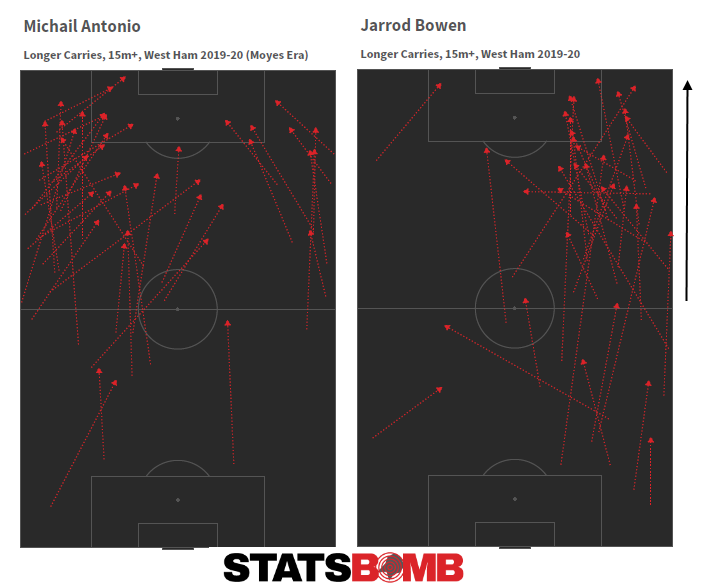 Once they have the ball, there's a good chance you'll see a shot at the end of it. One of Bowen's known weaknesses is shot selection, but from enforced turnovers, his rate of getting shots (any kind) leads the league, with Antonio not that far behind:
Once they have the ball, there's a good chance you'll see a shot at the end of it. One of Bowen's known weaknesses is shot selection, but from enforced turnovers, his rate of getting shots (any kind) leads the league, with Antonio not that far behind: 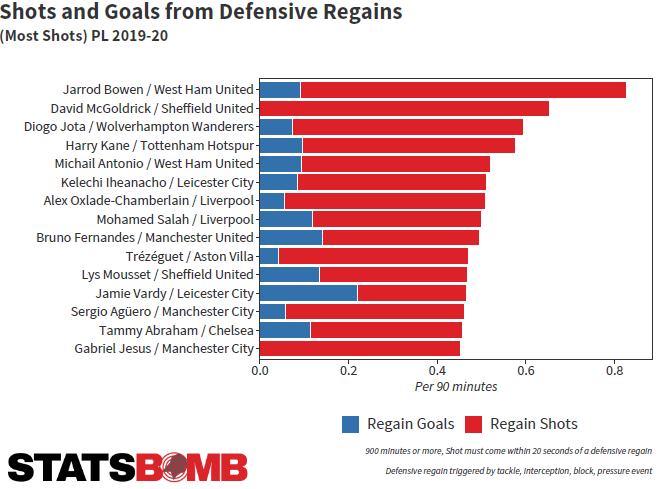 So Moyesball 2.0 is thus: defence first, a defensive midfielder with centre back qualities and an eye for goal, a converted passing defensive midfielder in the 10 slot and targeting zone movers to get the ball up the pitch and shoot. The result of this was spectacular for Antonio, who was second only to Raheem Sterling for xG per 90 after the restart. Once more reborn as a striker, he was more than a handful:
So Moyesball 2.0 is thus: defence first, a defensive midfielder with centre back qualities and an eye for goal, a converted passing defensive midfielder in the 10 slot and targeting zone movers to get the ball up the pitch and shoot. The result of this was spectacular for Antonio, who was second only to Raheem Sterling for xG per 90 after the restart. Once more reborn as a striker, he was more than a handful: 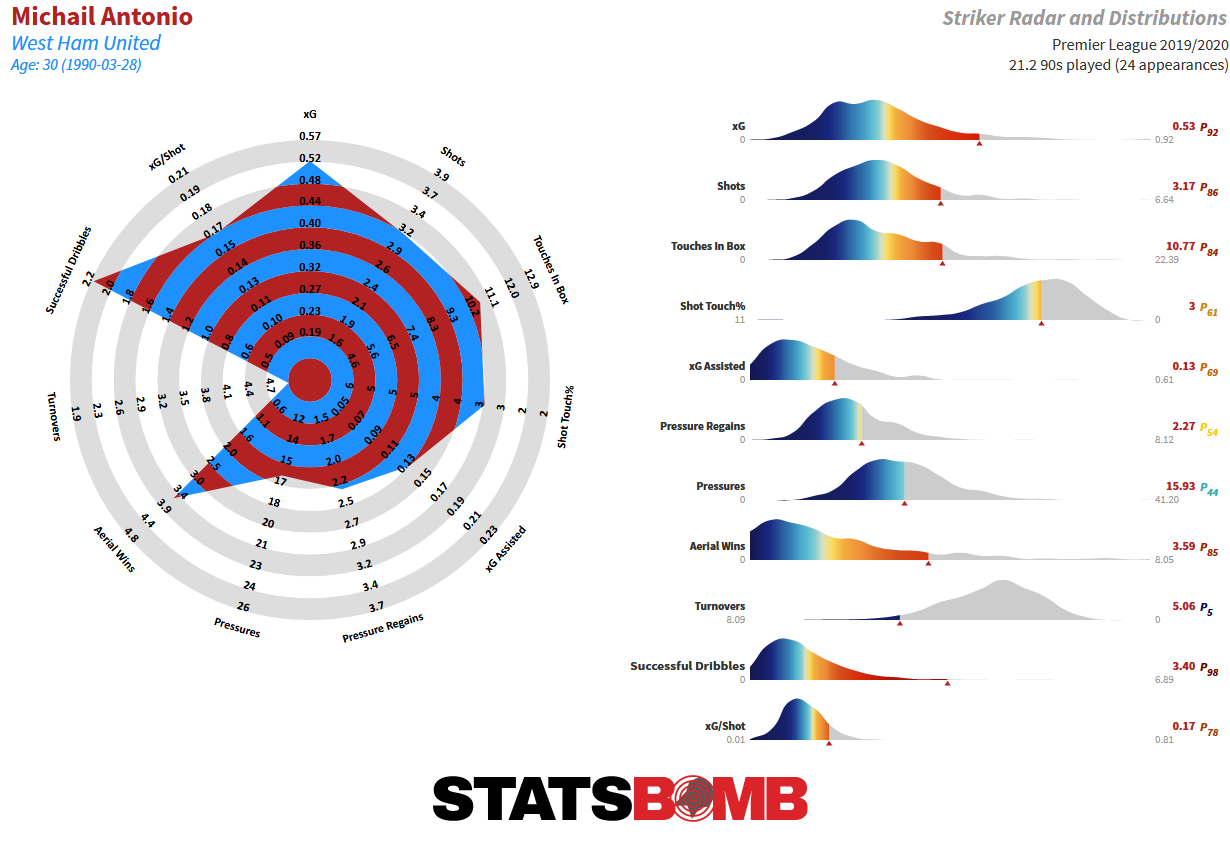 Even if we unfairly disregard his four-goal, nine shot, 2.1 xG game against Norwich, he still scopes out very well. A shade under three shots and 0.55 xG per 90 in the Moyes era is everything you want from a centre forward on a non-elite team. It will be hard to keep him out of the starting line-up when the league resumes providing an injury sustained in a warm-up match against Brentford does not persist. The period of summer football saw West Ham pick up twelve points from nine games. Not bad. But among that their metrics took a huge u-turn moving from "actually bad" to "really quite good":
Even if we unfairly disregard his four-goal, nine shot, 2.1 xG game against Norwich, he still scopes out very well. A shade under three shots and 0.55 xG per 90 in the Moyes era is everything you want from a centre forward on a non-elite team. It will be hard to keep him out of the starting line-up when the league resumes providing an injury sustained in a warm-up match against Brentford does not persist. The period of summer football saw West Ham pick up twelve points from nine games. Not bad. But among that their metrics took a huge u-turn moving from "actually bad" to "really quite good":  Post-lockdown xG difference was around +0.3 per 90, and goal difference matched it. The key to this defensively was the opposition shot quality finally taking a positive hit. It crashed down to 0.09 per shot. This shaved around a third off versus their season long xG Against during this period, and they also had the better end of set-pieces, scoring four and allowing just one, in line with expectation there too. Now a lot of these movements fall into the realm of possible variance within a short period of time, but West Ham haven't see this kind of positive move in metrics for a long time. At least, for now, there can be some hope that they can continue to play the style of football they provided in the summer of 2020 and be more successful, perhaps even lift themselves out of the mix for a relegation battle. Recruitment and fitness of key men may play a part in how successful that desire is. Personnel Director of Football Mario Husillos left with Manuel Pellegrini in December 2019. His record was embodied by a lot of money spent on appealing attackers, few of which have really made enough of a mark when factored against fees spent. This senior role hasn’t subsequently been publicly filled by anyone, though somebody signed off on the transfers of Bowen and Souček in January. Moyes appeared clear minded in what he wanted to do this window in an early August interview with the Evening Standard and is presumably close to the throne here, and is perhaps sitting in it: “We would like to strengthen in a lot of areas. We’re lacking in defensive cover … We’re trying to bring in a younger group but we will also need a couple of experienced players. Central defenders are usually better when they’re more experienced … Anyone who knows anything about football would surely say, ‘This is a club that could do with a period of stability.’” With the extended transfer window not shutting til October, West Ham haven't yet been active, so it's hard to get a handle on any specific recruits. Rice's future is surely more settled now that Chelsea have purchased elsewhere and in the very short term West Ham's overall squad is relatively well set for the season ahead without overt tinkering. There are aging players in the squad--Ogbonna and Noble in particular saw high minutes last season and may perhaps need extra monitoring as they enter their 33rd and 34th years--but most recent recruitment has prioritised youth or prime ages. Antonio and Cresswell are two more starters that are the wrong side of 30 now, but, as Moyes alluded, an awareness of balancing youth and experience needs to be maintained. Prediction How good is this team? In the Moyes-era overall, West Ham collected points at 40 point pace. In the Moyes-post-lockdown-period, they were better and their 12 points in 9 games was 50 point pace. Expected goals under Moyes pegs then as among the best of the rest, top of the bottom half type range, so twelfth, and the Sporting Index pre-season points prediction has them about there too. Recent spending indicates a desire to exceed the old Pulis zone (40 to 50 points) and that may be enough to set sail for better times to come, providing the owners are happy to be solid first and entertaining second, something that they haven't always appeared to endorse. You know what you will get from Moyes teams. It might not be pretty, and there's not quite enough evidence in the tank to suggest that it will definitely be effective again, but there is a route for this team to create a stable and safe outcome. They just have to commit to it and execute.
Post-lockdown xG difference was around +0.3 per 90, and goal difference matched it. The key to this defensively was the opposition shot quality finally taking a positive hit. It crashed down to 0.09 per shot. This shaved around a third off versus their season long xG Against during this period, and they also had the better end of set-pieces, scoring four and allowing just one, in line with expectation there too. Now a lot of these movements fall into the realm of possible variance within a short period of time, but West Ham haven't see this kind of positive move in metrics for a long time. At least, for now, there can be some hope that they can continue to play the style of football they provided in the summer of 2020 and be more successful, perhaps even lift themselves out of the mix for a relegation battle. Recruitment and fitness of key men may play a part in how successful that desire is. Personnel Director of Football Mario Husillos left with Manuel Pellegrini in December 2019. His record was embodied by a lot of money spent on appealing attackers, few of which have really made enough of a mark when factored against fees spent. This senior role hasn’t subsequently been publicly filled by anyone, though somebody signed off on the transfers of Bowen and Souček in January. Moyes appeared clear minded in what he wanted to do this window in an early August interview with the Evening Standard and is presumably close to the throne here, and is perhaps sitting in it: “We would like to strengthen in a lot of areas. We’re lacking in defensive cover … We’re trying to bring in a younger group but we will also need a couple of experienced players. Central defenders are usually better when they’re more experienced … Anyone who knows anything about football would surely say, ‘This is a club that could do with a period of stability.’” With the extended transfer window not shutting til October, West Ham haven't yet been active, so it's hard to get a handle on any specific recruits. Rice's future is surely more settled now that Chelsea have purchased elsewhere and in the very short term West Ham's overall squad is relatively well set for the season ahead without overt tinkering. There are aging players in the squad--Ogbonna and Noble in particular saw high minutes last season and may perhaps need extra monitoring as they enter their 33rd and 34th years--but most recent recruitment has prioritised youth or prime ages. Antonio and Cresswell are two more starters that are the wrong side of 30 now, but, as Moyes alluded, an awareness of balancing youth and experience needs to be maintained. Prediction How good is this team? In the Moyes-era overall, West Ham collected points at 40 point pace. In the Moyes-post-lockdown-period, they were better and their 12 points in 9 games was 50 point pace. Expected goals under Moyes pegs then as among the best of the rest, top of the bottom half type range, so twelfth, and the Sporting Index pre-season points prediction has them about there too. Recent spending indicates a desire to exceed the old Pulis zone (40 to 50 points) and that may be enough to set sail for better times to come, providing the owners are happy to be solid first and entertaining second, something that they haven't always appeared to endorse. You know what you will get from Moyes teams. It might not be pretty, and there's not quite enough evidence in the tank to suggest that it will definitely be effective again, but there is a route for this team to create a stable and safe outcome. They just have to commit to it and execute.
If you're a club, media or gambling entity and want to know more about what StatsBomb can do for you, please contact us at Sales@StatsBomb.com We also provide education in this area, so if this taste of football analytics sparked interest, check out our Introduction to Football Analytics course Follow us on twitter in English and Spanish and also on LinkedIn
Chelsea came through their transfer ban season unscathed, securing Champions League football with a fourth-place finish in Frank Lampard’s first year at the helm. That proved to be the understated prelude to a transfer window of heavy spending that has raised expectations ahead of the new campaign. There are two opposing ways of assessing last season. You either think Lampard did a very good job in steering a relatively young team, written off by some, and shorn of Eden Hazard, their primary attacking contributor, to a top-four finish; or, you think that despite Hazard’s departure, the strength of the squad was undersold, that Chelsea had some clear faults Lampard struggled to fix as the season went on and that he somewhat lucked into a top-four finish due to Arsenal and Tottenham’s woes and Leicester’s late collapse. There are other considerations on both sides of the argument, but the reality likely lies somewhere in between: he performed about par given the quality of the players at his disposal. Chelsea secured six less points than under Maurizio Sarri in 2018-19, scoring six more goals but conceding 15 more. You have to go all the way back to 1997 to find the last time they conceded more than their total of 54 goals (although they did let in 53 in finishing 10th in 2015-16). The underlying numbers offer more support of Lampard’s work. This wasn’t a repeat run of his 2018-19 season at Derby, where his team converted mediocre metrics into a spot in the playoff final. His Chelsea side actually had the third-best expected goal (xG) difference in the Premier League. 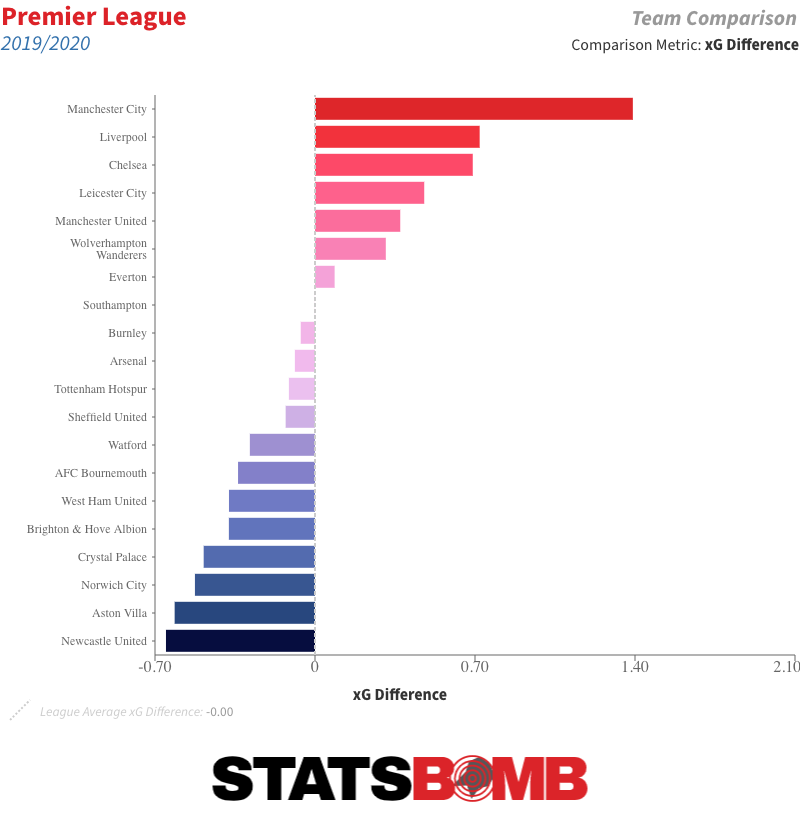 Chelsea regularly dominated the shot count. Only Manchester City took more than their 16.29 per match or conceded less than their 8.32 per match. The transitions forward were slightly quicker and more direct than under Sarri, and there was less of an overt focus on possession, although Lampard did continue the shift to a more aggressive high press.
Chelsea regularly dominated the shot count. Only Manchester City took more than their 16.29 per match or conceded less than their 8.32 per match. The transitions forward were slightly quicker and more direct than under Sarri, and there was less of an overt focus on possession, although Lampard did continue the shift to a more aggressive high press. 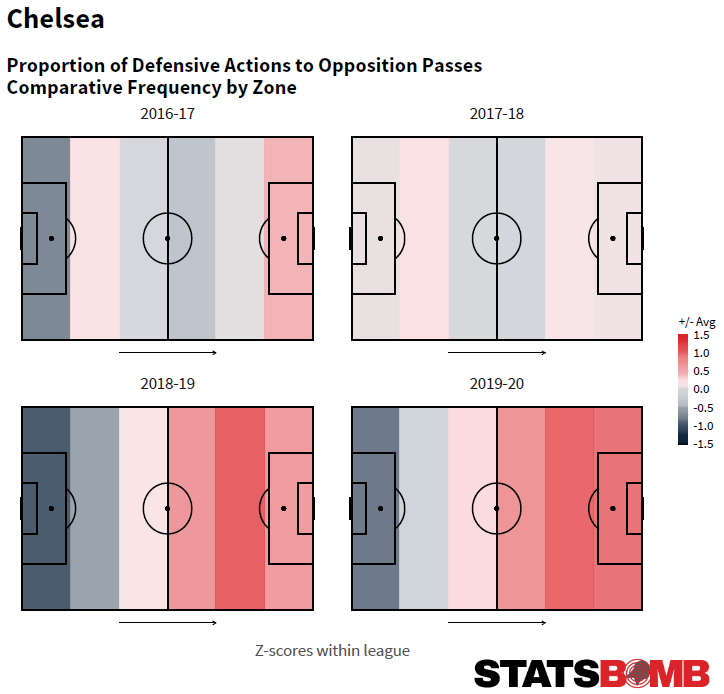 That was the main commonality with Lampard’s Derby team, who were also more aggressive in contesting possession high up the pitch than an average Championship side. Unlike at Derby, this approach was successful in suppressing opposition shot volume, but with the classic tradeoff: the average quality of the shots Chelsea conceded was amongst the highest in the league.
That was the main commonality with Lampard’s Derby team, who were also more aggressive in contesting possession high up the pitch than an average Championship side. Unlike at Derby, this approach was successful in suppressing opposition shot volume, but with the classic tradeoff: the average quality of the shots Chelsea conceded was amongst the highest in the league. 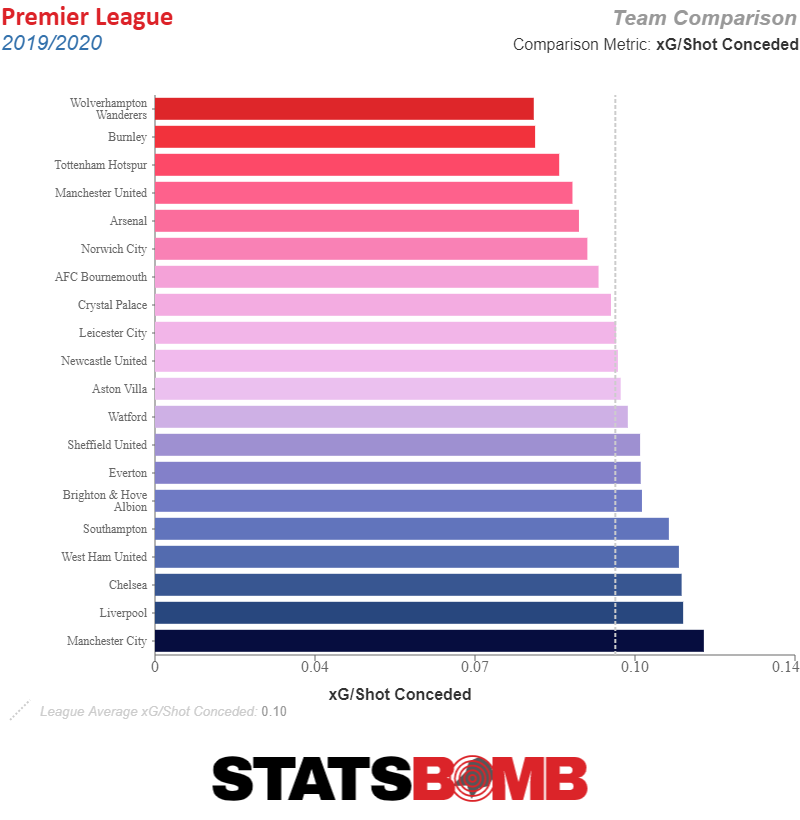 It was on the defensive side that Chelsea severely underperformed their metrics. They were about par in attack, scoring 62 non-penalty goals from 63.06 xG; in defence, they conceded 16 goals more than the expectation: 52 non-penalty goals from 36.03 xG.
It was on the defensive side that Chelsea severely underperformed their metrics. They were about par in attack, scoring 62 non-penalty goals from 63.06 xG; in defence, they conceded 16 goals more than the expectation: 52 non-penalty goals from 36.03 xG. 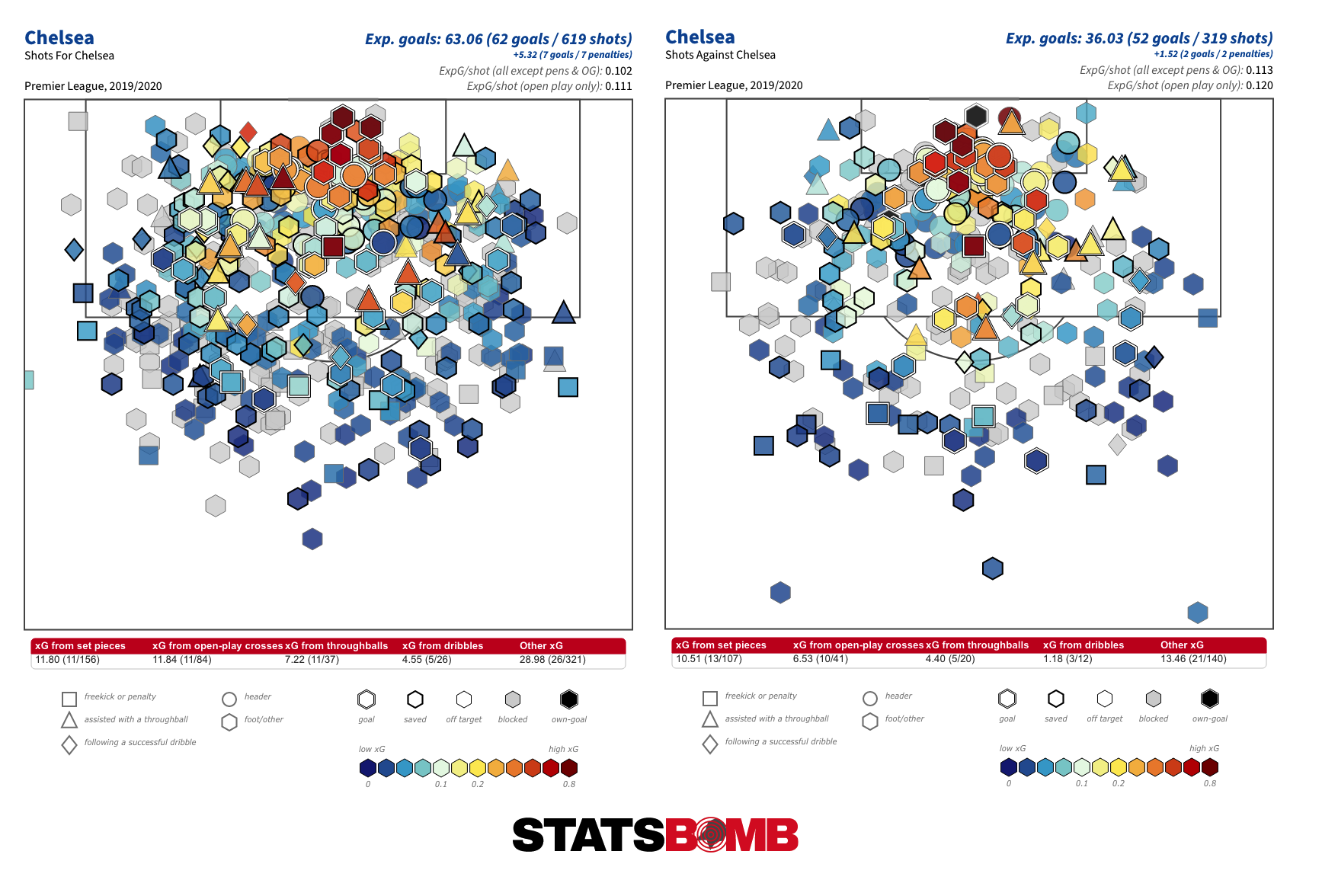 We’ve been clear from the start that we believe Kepa Arrizabalaga to be average goalkeeper at best, and the numbers do suggest he was a negative contributor last season. It still isn’t enough to account for all that difference. It’s also notable that this has been a thing at Chelsea for some time now, even before Kepa’s arrival in the summer of 2018. From the second half of 2017-18 onwards, they’ve pretty consistently underperformed their metrics, with the bulk of that attributable to the defence.
We’ve been clear from the start that we believe Kepa Arrizabalaga to be average goalkeeper at best, and the numbers do suggest he was a negative contributor last season. It still isn’t enough to account for all that difference. It’s also notable that this has been a thing at Chelsea for some time now, even before Kepa’s arrival in the summer of 2018. From the second half of 2017-18 onwards, they’ve pretty consistently underperformed their metrics, with the bulk of that attributable to the defence. 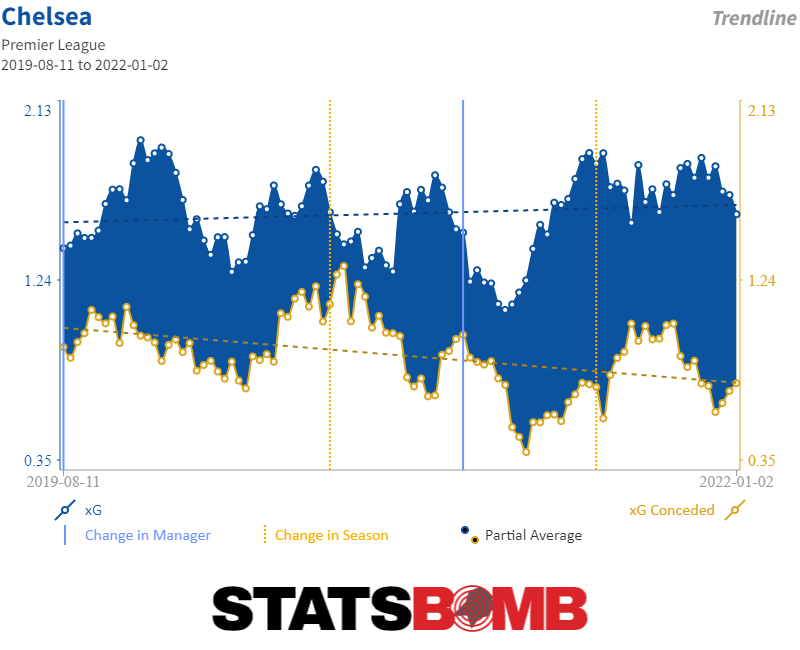 A small part of last season's difference can perhaps be assigned to set pieces, where Chelsea conceded 13 times (only two teams conceded more) from 10.51 xG. That is an area in which you'd usually expect to see most variation from the model. The tape does also suggest that they were pretty open in midfield. The previously bulletproof N’Golo Kanté missed 16 matches through injury, and covering large swathes of midfield territory in transition is not exactly Jorginho’s strongpoint. The backline was often left exposed, given impossibly large spaces to defend. Now, our xG model already includes goalkeeper and defender positioning, which is a huge help in determining how clear chances really are. Perhaps there is something on the margins of what the model picks up, like balance, relative body positioning, etc, that has made a small (and it would be small) contribution to the difference? Or maybe last season was just the latest episode in a particularly long run of bad luck in terms of opposition finishing? We won’t get a stable sample with which to test those theories because it will be a very different Chelsea who step out onto the pitch in 2020-21. With purse strings tightening across the continent, Chelsea have found themselves in the enviable position of being one of the few sides of genuine means with funds freely available. They’ve already laid out north of £130 million on three new arrivals, with a further £90 million soon to put down on Kai Havertz. Add to that the free transfer signing of Paris Saint-Germain central defender Thiago Silva, whose wages presumably aren’t cheap, and it's quite the outlay. The three new attackers all look a good fit for the play style, coming off of some of the most aggressive high-pressing teams in their respective leagues. Timo Werner is real thoroughbred, a striker all the continent’s biggest teams should have been looking at. He combines relentless running into the channels with high-volume and high-quality shot output. He is a direct upgrade on Tammy Abraham, who himself scored a very respectable 15 goals last season, and also someone who could easily play alongside him.
A small part of last season's difference can perhaps be assigned to set pieces, where Chelsea conceded 13 times (only two teams conceded more) from 10.51 xG. That is an area in which you'd usually expect to see most variation from the model. The tape does also suggest that they were pretty open in midfield. The previously bulletproof N’Golo Kanté missed 16 matches through injury, and covering large swathes of midfield territory in transition is not exactly Jorginho’s strongpoint. The backline was often left exposed, given impossibly large spaces to defend. Now, our xG model already includes goalkeeper and defender positioning, which is a huge help in determining how clear chances really are. Perhaps there is something on the margins of what the model picks up, like balance, relative body positioning, etc, that has made a small (and it would be small) contribution to the difference? Or maybe last season was just the latest episode in a particularly long run of bad luck in terms of opposition finishing? We won’t get a stable sample with which to test those theories because it will be a very different Chelsea who step out onto the pitch in 2020-21. With purse strings tightening across the continent, Chelsea have found themselves in the enviable position of being one of the few sides of genuine means with funds freely available. They’ve already laid out north of £130 million on three new arrivals, with a further £90 million soon to put down on Kai Havertz. Add to that the free transfer signing of Paris Saint-Germain central defender Thiago Silva, whose wages presumably aren’t cheap, and it's quite the outlay. The three new attackers all look a good fit for the play style, coming off of some of the most aggressive high-pressing teams in their respective leagues. Timo Werner is real thoroughbred, a striker all the continent’s biggest teams should have been looking at. He combines relentless running into the channels with high-volume and high-quality shot output. He is a direct upgrade on Tammy Abraham, who himself scored a very respectable 15 goals last season, and also someone who could easily play alongside him. 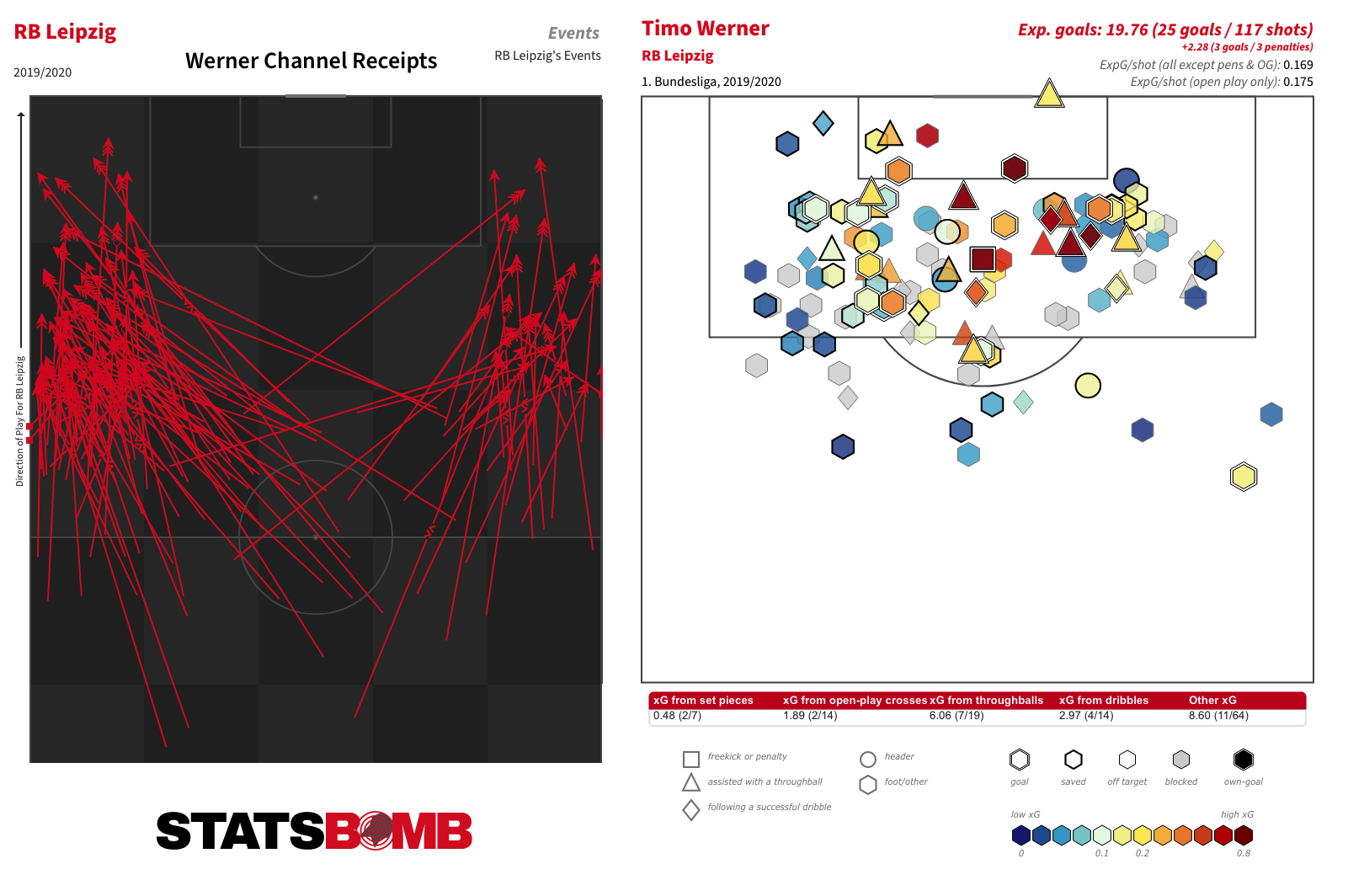 Hakim Ziyech is a high-usage, high risk/reward passer and shooter. You might think his high shot count last season (4.89 per 90) was conditioned by Ajax’s strength relative the rest of the Eredivisie, but he got off even more on their run to the final four of the 2018-19 Champions League. In fact, he’s always been a high volume shooter, even back to his Heerenveen and Twente days. How he’ll work out on a team who had a fairly equitable share of shots between their players last season remains to be seen.
Hakim Ziyech is a high-usage, high risk/reward passer and shooter. You might think his high shot count last season (4.89 per 90) was conditioned by Ajax’s strength relative the rest of the Eredivisie, but he got off even more on their run to the final four of the 2018-19 Champions League. In fact, he’s always been a high volume shooter, even back to his Heerenveen and Twente days. How he’ll work out on a team who had a fairly equitable share of shots between their players last season remains to be seen. 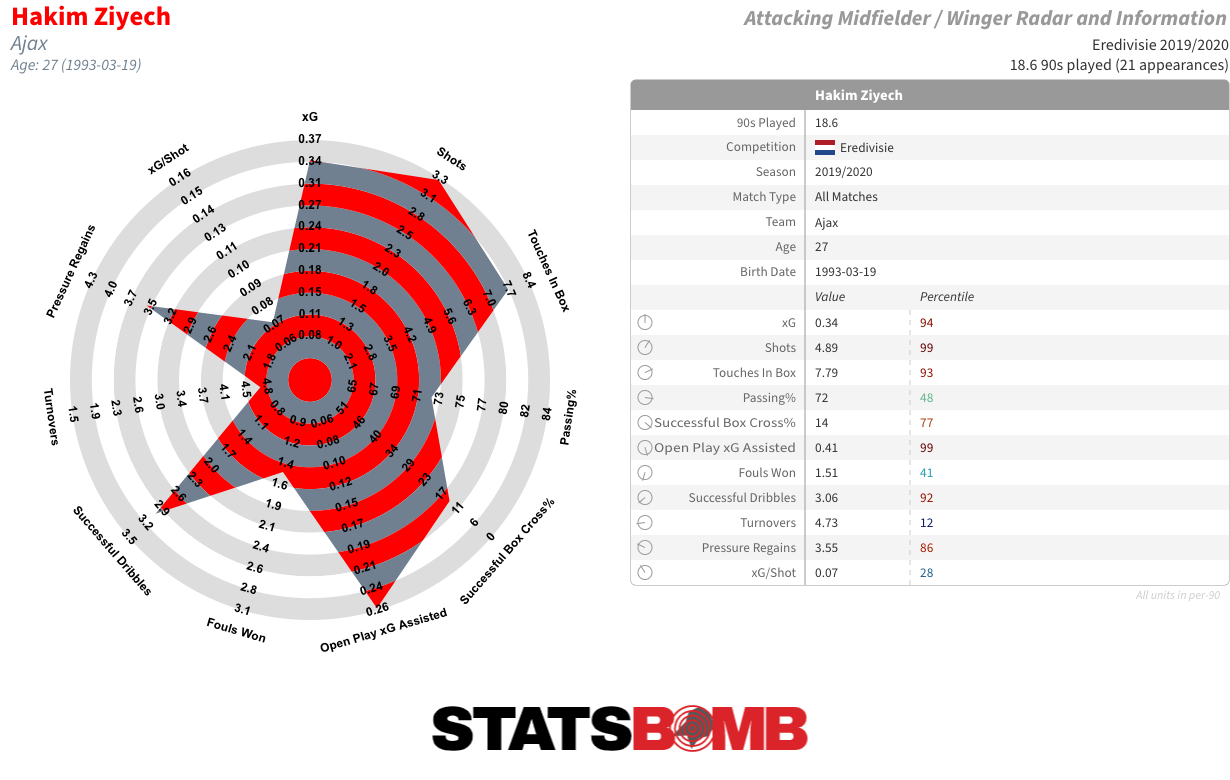 Havertz is a tall, skilled and deceptively quick player who fulfilled a variety of roles at Bayer Leverkusen last season. He saw minutes as a right winger, central attacking midfielder and even as a false nine. He provides both shot and creative output, tallying 11 goals and six assists from 14.61 xG and xG assisted last season, and might be ready to explode.
Havertz is a tall, skilled and deceptively quick player who fulfilled a variety of roles at Bayer Leverkusen last season. He saw minutes as a right winger, central attacking midfielder and even as a false nine. He provides both shot and creative output, tallying 11 goals and six assists from 14.61 xG and xG assisted last season, and might be ready to explode. 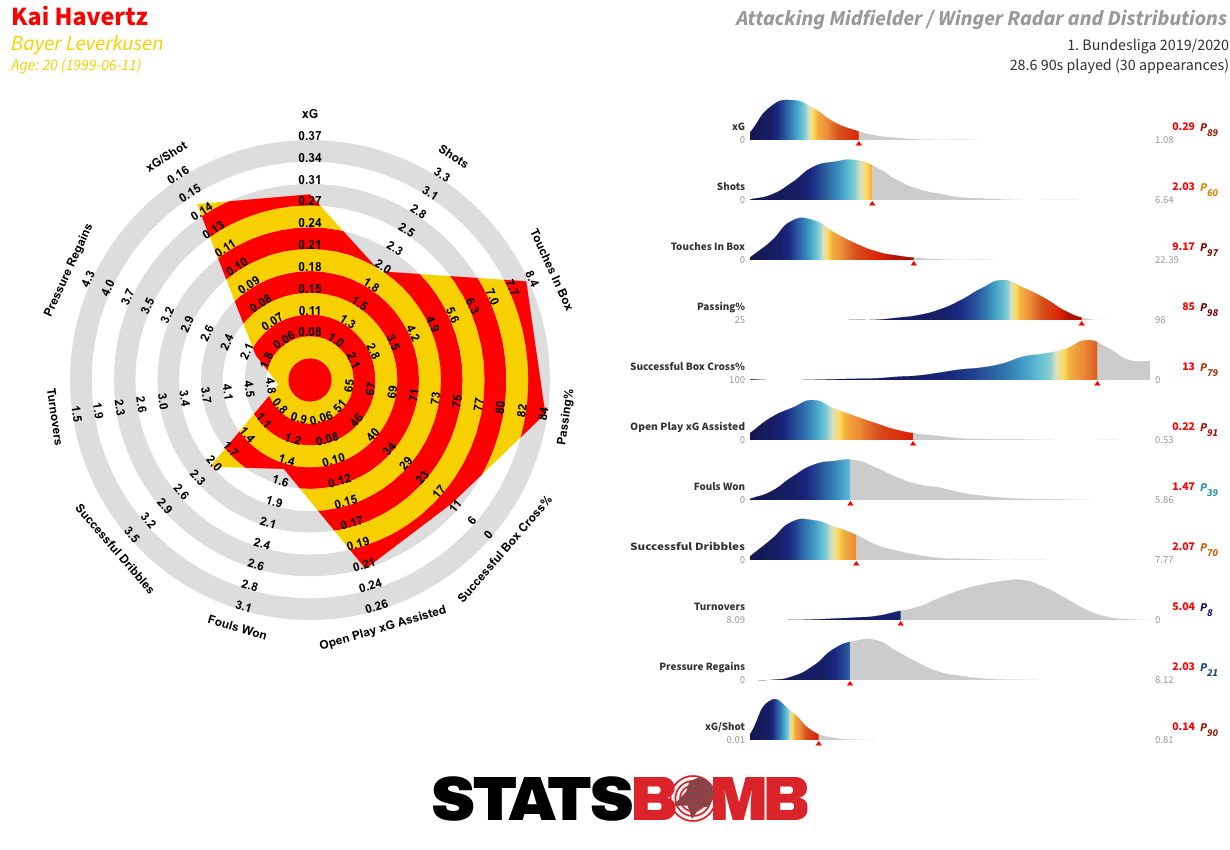 Those three will all have to fit in around Christian Pulisic, who produced over a goal or assist for every two matches he played in terms of both expected and actual output in his first season at the club. Lampard seemed hesitant to start him during the early part of the campaign, but he got two good runs of starts either side of his mid-season injury, and established himself as a key player down the final stretch. Lampard now has a superb set of options for the four forward-most positions, and there is enough wiggle room in their respective skillsets to fit them all together into a somewhat coherent system. There is also natural symmetry there, with Pulisic and Werner generally preferring to receive towards the left; Havertz and Ziyech, the right. Elsewhere, there is no replacement yet for Kepa nor a capable ball-winner in midfield. In addition to question marks over whether Lampard's system makes best use of Kanté's attributes, there may be concerns that last season’s fitness issues were the early signs of physical decline. The money spent in the final third might prove a little superfluous if those needs are not also addressed. There have been reinforcements in defence. Ben Chilwell is a good, solid Premier League full-back, better going forward than he is at defending. He's not a huge upgrade on what Chelsea already had on the left, but he is both homegrown and younger, which may be justification enough. He’ll likely be a relatively dependable performer, and he still has time to refine the defensive side of his game, but the feeling persists that they might have found someone a little more inspiring at that price point.
Those three will all have to fit in around Christian Pulisic, who produced over a goal or assist for every two matches he played in terms of both expected and actual output in his first season at the club. Lampard seemed hesitant to start him during the early part of the campaign, but he got two good runs of starts either side of his mid-season injury, and established himself as a key player down the final stretch. Lampard now has a superb set of options for the four forward-most positions, and there is enough wiggle room in their respective skillsets to fit them all together into a somewhat coherent system. There is also natural symmetry there, with Pulisic and Werner generally preferring to receive towards the left; Havertz and Ziyech, the right. Elsewhere, there is no replacement yet for Kepa nor a capable ball-winner in midfield. In addition to question marks over whether Lampard's system makes best use of Kanté's attributes, there may be concerns that last season’s fitness issues were the early signs of physical decline. The money spent in the final third might prove a little superfluous if those needs are not also addressed. There have been reinforcements in defence. Ben Chilwell is a good, solid Premier League full-back, better going forward than he is at defending. He's not a huge upgrade on what Chelsea already had on the left, but he is both homegrown and younger, which may be justification enough. He’ll likely be a relatively dependable performer, and he still has time to refine the defensive side of his game, but the feeling persists that they might have found someone a little more inspiring at that price point. 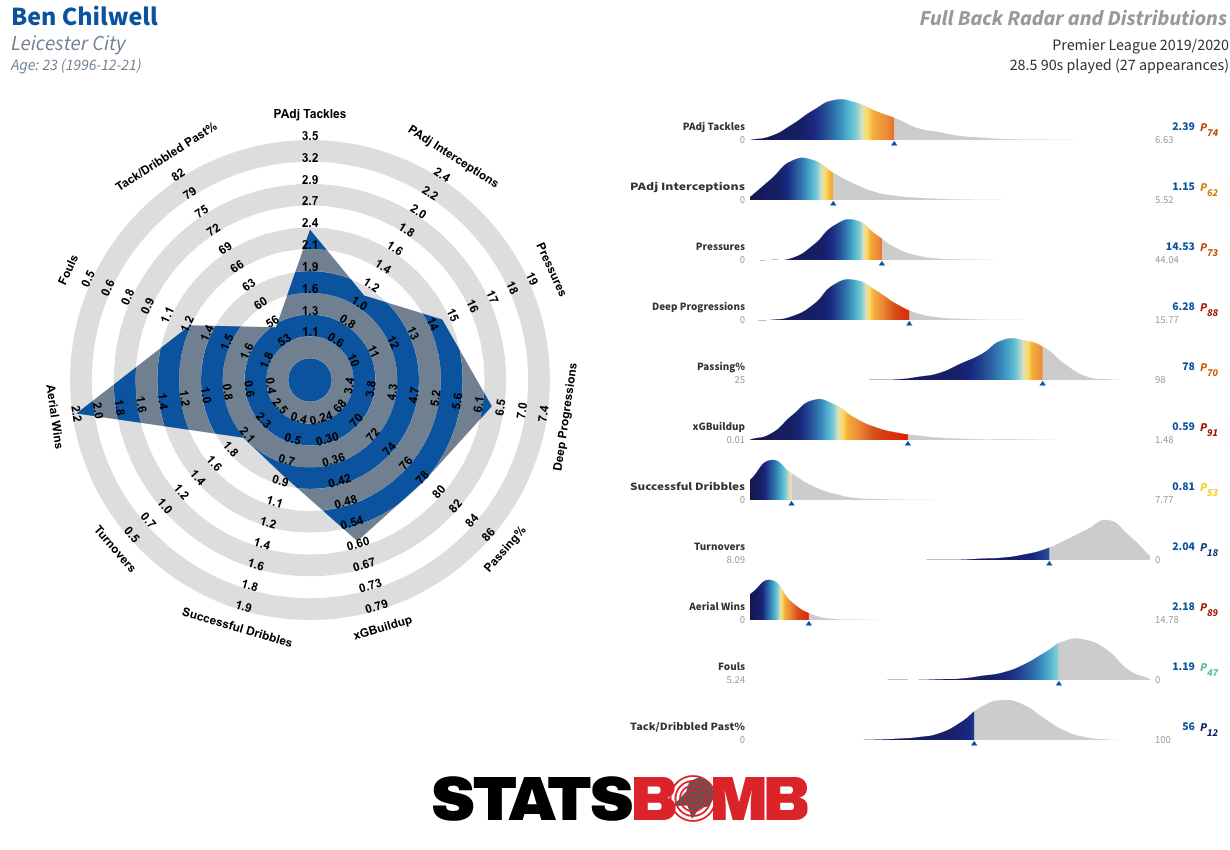 Thiago Silva obviously has great pedigree and even at this late stage of his career probably represents an improvement on last season’s starters. But at 35, soon to be 36, any physical decline is likely to be a bit more obvious at Chelsea than it was at PSG. Malang Sarr, another free transfer arrival, is an the opposite end of the age curve. Now 21, he's been a starter at Nice since he was 17. There are some suggestions he might be loaned out, and this could simply be Chelsea taking advantage of value in the market with an eye on future profit, but he seems to roughly fit the profile of what they might be looking for in a central defender. The incomings raise doubts over the future and development of some of the younger players who got good game time last season, particularly Callum Hudson-Odoi, who produced solid output when he made the pitch but never seemed to totally convince Lampard. It is also likely that Abraham and Mason Mount will see their minutes reduced. The enforced use of internal options has, though, had clear benefit. Chelsea now have good, first-hand information on a group of young players who, if nothing else, have had their market value raised by a year in the first team. So where should expectations be set for Chelsea this season? The points gap to Liverpool and Manchester City is probably too large to overcome in a single campaign, even if all of the new signings do immediately click, but the level of their spending suggests that reducing it will be the minimum requirement. A third-place finish seems the most likely outcome. If that isn't achieved, and previous problems also persist, Lampard's job may well be at risk.
Thiago Silva obviously has great pedigree and even at this late stage of his career probably represents an improvement on last season’s starters. But at 35, soon to be 36, any physical decline is likely to be a bit more obvious at Chelsea than it was at PSG. Malang Sarr, another free transfer arrival, is an the opposite end of the age curve. Now 21, he's been a starter at Nice since he was 17. There are some suggestions he might be loaned out, and this could simply be Chelsea taking advantage of value in the market with an eye on future profit, but he seems to roughly fit the profile of what they might be looking for in a central defender. The incomings raise doubts over the future and development of some of the younger players who got good game time last season, particularly Callum Hudson-Odoi, who produced solid output when he made the pitch but never seemed to totally convince Lampard. It is also likely that Abraham and Mason Mount will see their minutes reduced. The enforced use of internal options has, though, had clear benefit. Chelsea now have good, first-hand information on a group of young players who, if nothing else, have had their market value raised by a year in the first team. So where should expectations be set for Chelsea this season? The points gap to Liverpool and Manchester City is probably too large to overcome in a single campaign, even if all of the new signings do immediately click, but the level of their spending suggests that reducing it will be the minimum requirement. A third-place finish seems the most likely outcome. If that isn't achieved, and previous problems also persist, Lampard's job may well be at risk.
If you're a club, media or gambling entity and want to know more about what StatsBomb can do for you, please contact us at Sales@StatsBomb.com We also provide education in this area, so if this taste of football analytics sparked interest, check out our Introduction to Football Analytics course Follow us on twitter in English and Spanish and also on LinkedIn
When Marcelo Bielsa joined Leeds United in June 2018, the move surprised football. Club Chairman Andrea Radrizzani was evidently proud of the work done by Director of Football Victor Orta and CEO Angus Kinnear in securing the Argentinian legend on a two year deal, and was effusive in how he felt this piece of recruitment could help the club evolve:
"He is a coach that I have admired for many years and when the opportunity arose to bring him to Elland Road, we made it our top priority for the summer.
Marcelo has a wealth of experience and he will use that to create a new culture and a winning mentality at our football club." (1)
Bielsa himself was characteristically modest about the challenges that lay ahead and his reason for joining the club:
"It has always been my ambition to work in England and I have had several opportunities to do so during my career, however I have always felt it was important to wait for the right project to come along and so when a club with Leeds United's history made me an offer, it was impossible to turn down...
I am excited for the challenge ahead."
What Bielsa has achieved since then has been nothing short of remarkable and he has delivered on his chairman’s words. Since relegation to the Championship in 2004, Leeds have suffered much instability and unrest but since the very first game that Bielsa helmed-- a 3-1 home victory against Stoke City--they have been pointing firmly upwards. A mid-table Championship side has been transformed into a Premier League club for 2020-21. StatsBomb are proud to have provided services to the club during the 2019-20 season and will continue to do so throughout the forthcoming year.
Let’s take a look at some of the analytical aspects that have led to the club finding it’s way back to the Premier League.
Quick impact, retained squad
The season before Bielsa was appointed, Leeds finished thirteenth in the Championship under first Thomas Christansen and then Paul Heckingbottom. This was the sixth time in eight seasons they had finished adrift in mid-table since being promoted out of League One in 2009-10. When decisions were made that summer, Heckingbottom hadn’t done enough in his short tenure to gain the backing of the board.
The core of the playing group that Bielsa inherited has been together a long time; indeed, nine senior players who featured heavily in the promotion run were at the club and regularly playing during that mid-table finish in 2017-18. Bielsa didn’t make wild changes to personnel; to start with he largely used what he already had.
As such, that first game against Stoke featured familiar names: Luke Ayling, Liam Cooper, Ezdzhan Alioski, Pablo Hernández, Kalvin Phillips, Stuart Dallas, Mateusz Klich and Jack Harrison were eight of the fourteen players that featured that day. During 2019-20 each of those players played more than 2000 minutes, while furthermore Gaetano Berardi, Barry Douglas and Adam Forshaw were also on the pitch that day and remained part of this squad nearly two years on.
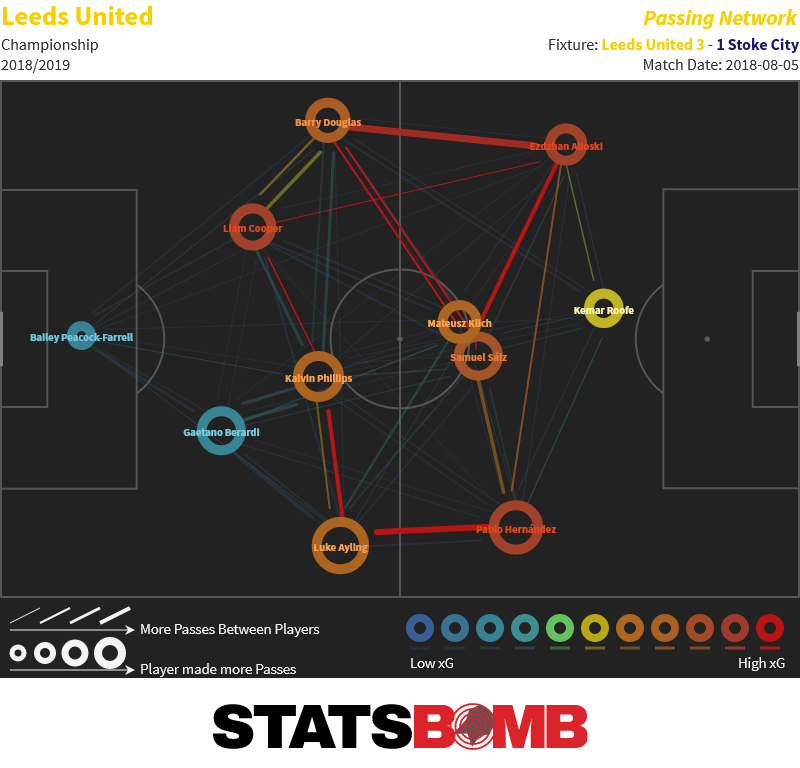
The associated cast brought in via the transfer market has been relatively cheaply assembled, especially when considering the somewhat profligate spending that can be associated with teams pushing to lift themselves out from the Championship. Patrick Bamford and Barry Douglas arrived for fees in the summer of 2018, but were mostly accompanied by loans. This was a trend that continued in 2019-20 with loanees Ben White and Hélder Costa the major new factors in the team, the latter on a loan-to-buy deal.
Improved metrics
Looking at metrics, Bielsa turned a mid-table, negative expected goal team into one with the league's best metrics.
It also happened very quickly.
Within his first ten games the team was recording close to 0.7xG per game more than their opponents. That is to say, their underlying performances were around seven goals better than the opposition. From that point onward, across two seasons, their metrics only really dipped once, going through January and February 2020, and they were still at worst worth three goals more than their opponents in any given ten game stretch.
At their strongest--through the crossover of 2018-19 to 2019-20 and beyond-- they were frequently posting metrics that were worth eleven or twelve goals more than their opponents across ten games. That early 2020 blip was the only time under Bielsa that the defence was offering up chances worth more than a goal per game, and coming out of that stretch they improved to a defensive level that was better than at any period prior. Team metrics have remained extremely strong across two seasons:
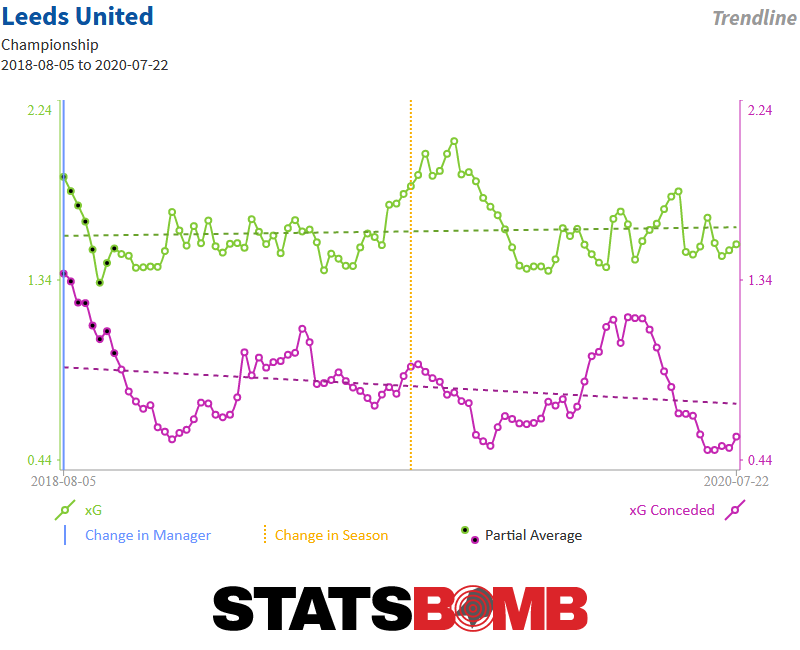
However expected metrics are not reality and the inevitable ebb and flow of variance around them did contribute to two divergent outcomes. Firstly, Leeds dropping out of the automatic promotion positions in 2018-19, in part due to a 10 goal swing against their expected metrics. Secondly, a similar positive swing, largely in their attack that cemented their promotion after the return from the lockdown break in 2019-20:
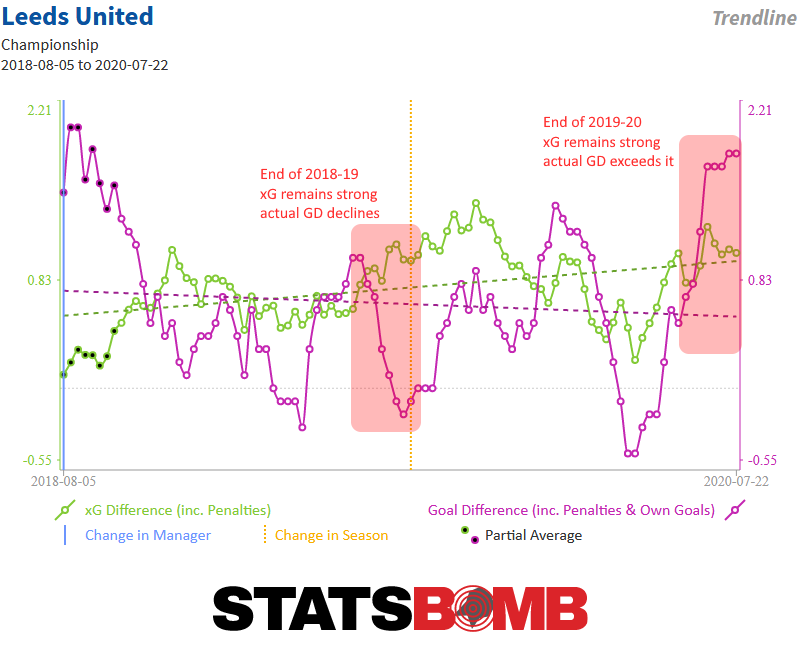
The drift out of the automatic promotion positions in 2018-19 led to a familiar narrative around Bielsa teams tiring at the end of seasons. Certainly the high energy style deployed by Leeds requires extremely high physical fitness levels, but the evidence in this scenario was far less concrete. While results dipped, general performance levels remained high. Also, when considering the shape of the 2018-19 Championship promotion battle, the circumstances around Leeds' rivals is worth scrutinising: Norwich City only lost two of their last 34 games while Sheffield United lost just two from 24.
By contrast, Leeds lost seven times between Christmas (although their overall form was still fourth best in the division) and ahead of a crucial and bizarre game they lost at home to Wigan on April 19th. At that point their fate was still in their own hands, and after an early red card for Wigan's Cedric Kipre was quickly followed by a Bamford goal, all looked well.
However, Leeds contrived to concede twice to the ten men by the hour mark, and despite a complete bombardment--15 shots in the last half an hour, 35 in total--they couldn't peg Wigan back.
After a defeat to Brentford in the next game, Bielsa was fairly shrewd in his judgment of the season as a whole:
“The level of the team has always been the same, the effort has always been the same. Of course the team has limits…This team has hidden many limits with huge effort. With personality, and by being demanding. Each player has played very close to his maximum during many games. “If we are to explain these circumstances, what we can say is this team deserves to have 10-12 points more and we don’t have them because we needed too many chances to actually score one goal. This is the vision I have through the whole season.” (2)
The freakish Wigan result ultimately tilted the promotion race in Sheffield United's favour while the Brentford result sealed it. Automatic promotion was out of their hands, with a play-off defeat to Frank Lampard's Derby an ironic coda to finish the season.
Goalkeeper woes
Leeds' non-penalty expected goals in attack across the whole of 2018-19 was best in the division at close to 71 goals, but matching this in goals scored was only enough to rank fifth. There is nothing intrinsically wrong with matching expected numbers, but teams that win titles frequently see them exceed expectation. That short term boost can make a huge difference and here each of the promoted teams exceeded expectation by reasonable margins.
In aggregate, it was the other end of the pitch that was more costly for Leeds as a negative defensive skew was large. In conceding 50 goals, Leeds allowed around 13 goals more than expectation. We can see where a majority of that came from if we just look at shots on target from range:
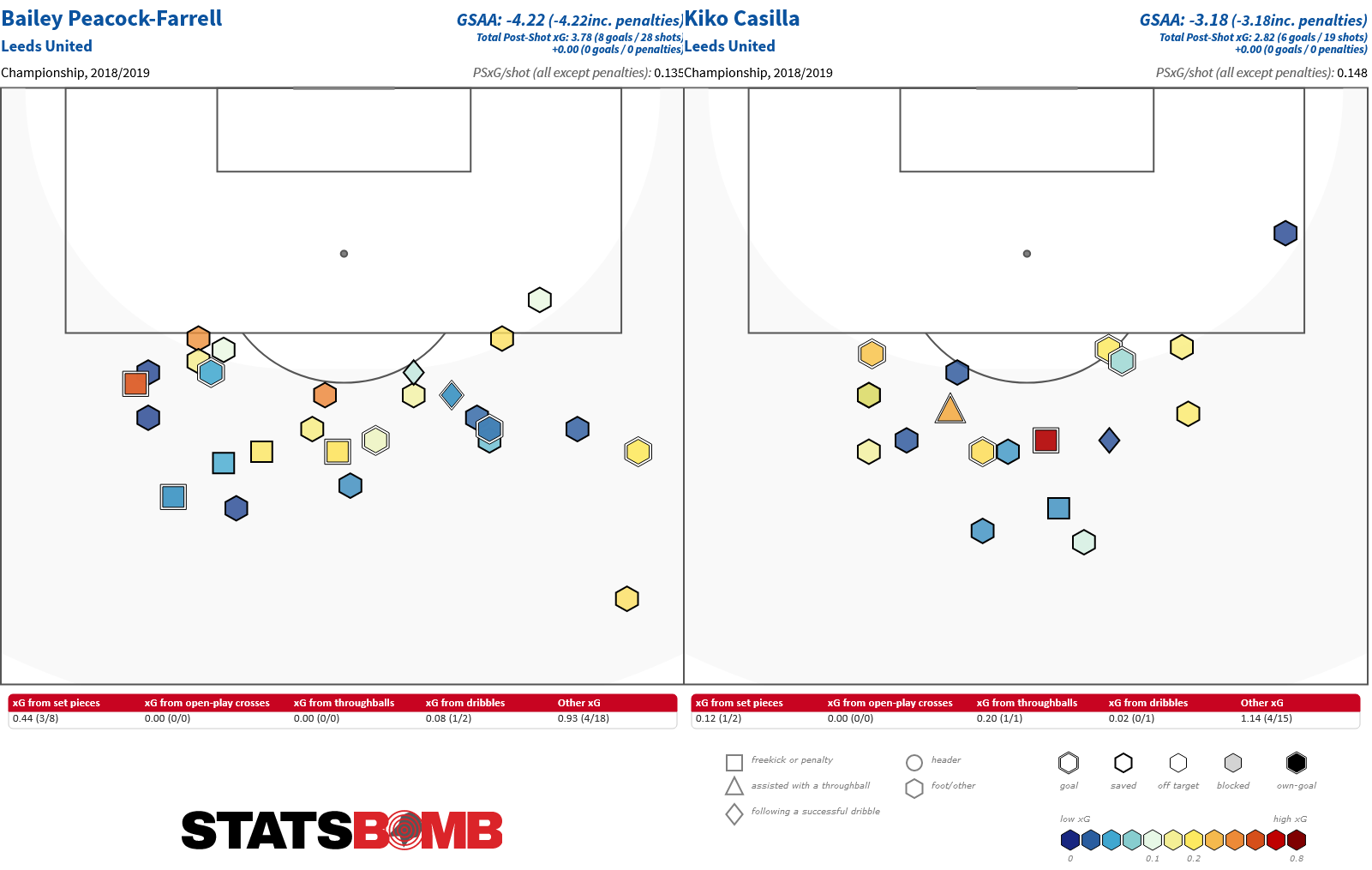
Bailey Peacock-Farrell conceded 8 goals from 28 shots on target at the range indicated in these charts, while Kiko Casilla conceded 6 from 19. We can forgive Casilla one goal here as Albert Adomah's goal for Villa was a literal gift and on review, in the main the shots he conceded were hard to keep out. Peacock-Farrell's tenure was less stable entirely and was littered with tame shots creeping in, slight fumbles or touches failing to keep the ball out. Only a miracle goal from Adam Reach for Sheffield Wednesday left the keeper entirely blameless.
Regardless of how this all occurred the facts remain stark. On aggregate, all shots on target are converted at around 30%. In 2018-19, Leeds' goalkeepers conceded shots on target at that rate just from long range shots. The mix of keeper error, deflections, good finishing and plain old luck essentially accounts for the vast majority of why Leeds struggled to limit opponent goals. From shots inside the box, Leeds allowed goals at a rate close to expectation.
To chime more directly with Bielsa's comments, we can look at how Leeds scored and allowed goals while the game was level. Across the whole of 2018-19, the worst deviation from expectation in the whole division occurred when Leeds were drawing games. In such circumstances, they outshot their opponents by nearly 150 shots yet scored just one more goal. The difference was valid at both ends; the attack scored close to five goals fewer than expected while the defence allowed 30 goals compared to an expectation of just over 19.
This is a classic representation of how from an analytics perspective, we can observe that the process is solid while the outcomes are more variable--in this case to Leeds' detriment. Knowing Leeds expected metrics were extremely strong in Bielsa's first season made the answer to the question "Could Leeds run it back?" easier to answer: providing they maintained their style in 2019-20, there was no reason why they couldn't.
Unique style
The change in style of play under Bielsa has created a degree of interest up and down the football league, even to the extent that one club, Huddersfield Town, have now employed one of his assistants, Carlos Corberán as Head Coach. It's worth asking, if a team can press with such vigour and achieve significant success, could other teams replicate the style? We can see via our opponent pass volume to defensive action (PPDA) charts that Leeds' style off the ball was like no other team in the Championship in 2018-19, indeed, like few other teams in world football:

What you see here is a representation of proportional defensive activity with regard to opposition pass volumes. It allows us to compare each team and shows what a huge outlier Leeds were as soon as Bielsa arrived. They were hugely active in every zone of the pitch apart from near to their own goal. This profile is unusual. Usually high quality pressing teams (Liverpool, Manchester City) show as significantly active high up the pitch, Leeds cover nearly all of it.
You only have to watch Leeds for a couple of minutes to understand how they play and how it's different to many other teams. They press. A lot. Here we get a window into the role Patrick Bamford has played over the last two seasons too.
Through a combination of injury and selection, Bamford only began to start regularly in February 2019 but has ever since been the primary striker in Leeds' team. While his goalscoring woes are well documented (he scored 14 non-penalty goals from an xG of over 22.5 in 2019-20) the effort he puts into defensive work cannot be overlooked. In 2018-19, no forward in the league on average pressed as high, or had as high a percentage of pressure events in the opposition half (87%) and he ranked top three among forwards for a variety of other related metrics, all a clear uptick on Kemar Roofe who played much of the season in the role.
These metrics ticked slightly downwards across a fuller season in 2019-20, but nevertheless, that Bamford was the focal point of this team's attack in and out of possession was clear. The thing is though, everyone presses. Bamford leads the way high up the pitch. It is straightforward to see how this style has persisted season to season when we look at the same graphic as before for 2019-20:
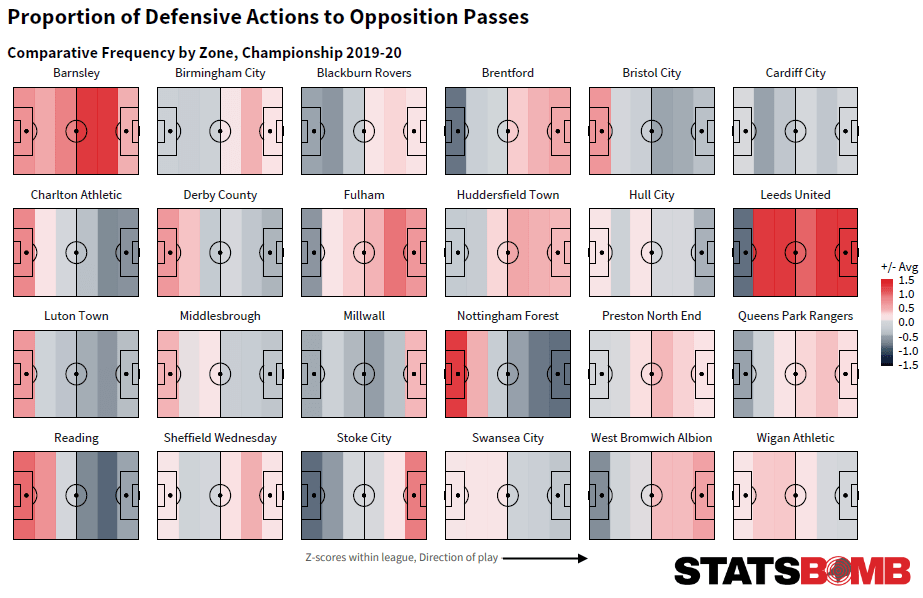
As an aside, such stylistic consistency does provide a clear pathway to recruitment. Though far less active overall, we can see particularly how Brentford's chart season to season displays this too. Across the entire 92 (91 in 2019-20) clubs in the Premier League and EFL, Leeds ranked second for "aggression" (defined as the percentage of opposition pass receipts faced by a pressure event or defensive action) in both seasons, marginally behind only Manchester City in 2018-19 and Barnsley in 2019-20. They actually slightly raised their volume here in 2019-20 from 29% to 30% too.
Defensive security
During the 2019-20 season, Leeds never dropped beneath fifth place in the table and after a win against Luton on the 19th November, they never finished a round of fixtures outside the top two. This time round, in the aggregate their attack again did not exceed expectation as Bamford's troubles anchored the output, but a huge seven own goals helped to traverse the finishing gap.
The defence saw the real turnaround and 35 goals against matched far closer to expectation than the negative skew of 2018-19. The Covid-induced interruption meant that the tail end of the season was delayed, but traversing it, Leeds' defence put in a truly stellar run. In winning five games before the break and seven of nine upon returning, Leeds gave up just five goals and an average of just over half a goal in xG per game.
Their opponents averaged under eight shots per game and those they took were of truly miserable average quality too. Quite often the weakness of a pressing team is in the quality of chances given up when teams do break through the press. Leeds under Bielsa have often combined low volumes of shots against (a clear perk for many pressing teams) without obviously sacrificing their ability to repress shot quality. This aspect will be hard to replicate in a higher league, but they could hardly have done better in their run in. They upped the ante and were defensively imperious, as we can see here;
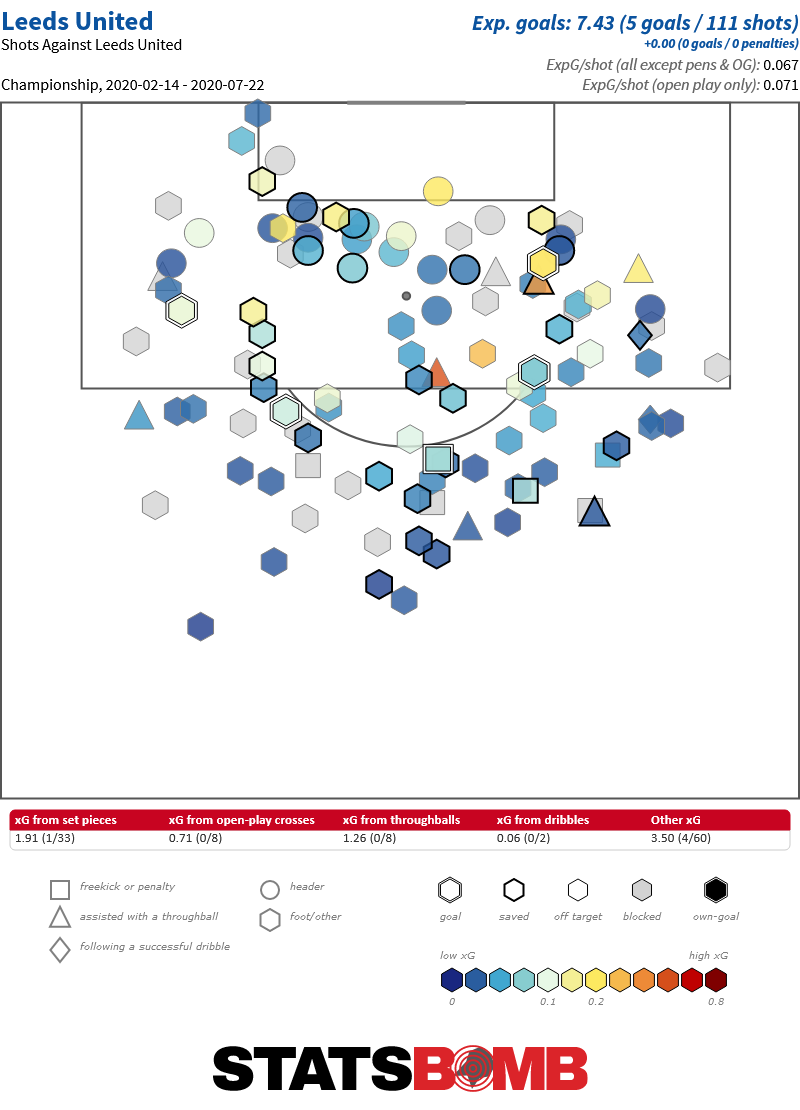
Some finishing luck? Yes, but look at the complete lack of high value chances (where is the red!), the paucity of good central footed shots (few hexagons!) and nearly nothing in the six yard box. Ironically, the only two goals Leeds have conceded from outside the box this season have come in this spell. This team waved goodbye to the Championship while hitting their full defensive stride.
As was then, is now
As we noted earlier, Bielsa's first fixture was at home to Stoke. A full 87 league matches and 704 days later, the same fixture recurred. Promotion was not yet certain and once again Leeds dominated the scoring, this time running out 5-0 victors. Yet if we compare the two pass networks from these two games, we can see how despite nearly two years having gone by, the way Leeds played, the positions their players took up and the overarching structure of the team had varied very little:
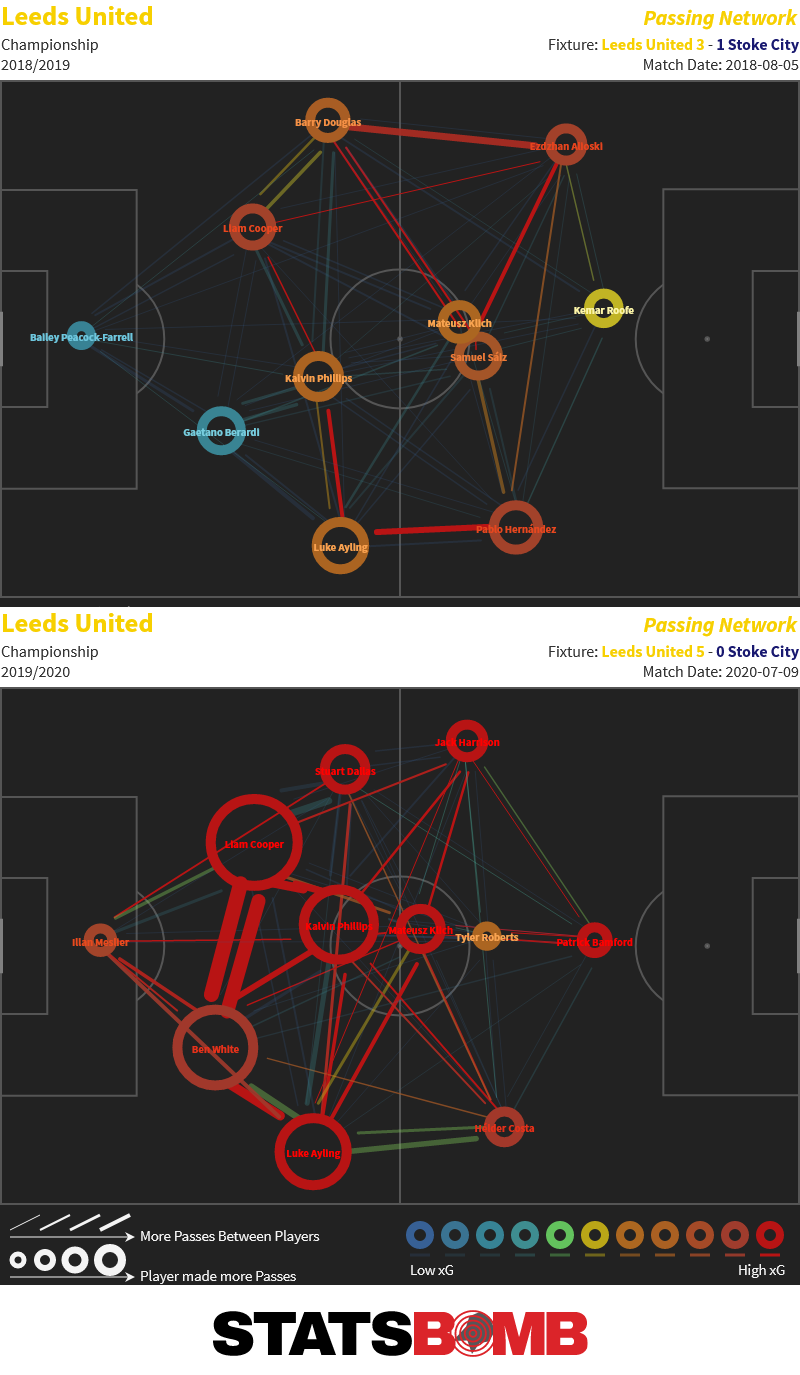
Perhaps, theoretically, the passing lanes have deeper grooves in them now... Leeds and Bielsa's success across the last two seasons is a rich chapter in a storied club's history. The Premier League now awaits, and few teams outside the top two are capable of playing a style anywhere near that which Bielsa demands of his team. Opponents will have to prepare for a hard workout. As a solitary reference point, the only time this Leeds team has faced Premier League opposition was an entertaining FA Cup tie against a strong Arsenal side.
They were very much second best in the second half and lost 1-0, but those who watched the game will recall the first half clearly. Leeds overwhelmed the Gunners for sheer energy and hustle and outshot them 15 to 3 without managing to breakthrough. Against weaker Premier League sides, that kind of play will bear dividends, and Leeds should be able to win a number of games this way. As well, a solid defensive record in a promotion season is quite often a portent for effective goal suppression in the Premier League, and Leeds have ticked that box.
They will need to beef out their squad but ideas around tiredness were not apparent in the broken up 2019-20 season and weren't entirely compelling the season prior. A shorter 38 game Premier League season will help here too, for all that it will be compressed. However the 2020-21 season progresses, few teams will be better physically and tactically prepared. The Premier League will be better for the presence of Bielsa's football and in particular matches against Pep Guardiola's Manchester City and Jürgen Klopp's Liverpool certainly whet the appetite. Leeds are back in the top flight, and they very much deserve to be.
If you're a club, media or gambling entity and want to know more about what StatsBomb can do for you, please contact us at Sales@StatsBomb.com
On a recent edition of the StatsBomb podcast, Ted made note of the lopsidedness of Manchester United’s shot map. There is a pronounced tilt toward the left, from where their two -- pre-Bruno Fernandes -- highest-volume shooters Anthony Martial and Marcus Rashford get off the majority of their efforts.
The data suggests a slight shift to the left is normal. For the purposes of this article, we have split the width of the pitch into five equal sections and then discarded the widest zone on each side. That leaves us with three zones that roughly span the width of the penalty area. From left to right we will name them, well... left, centre and right.
Across the last couple of seasons in the big-five European leagues, shots, expected goals (xG) and goals have been distributed like this:

In that time, 52.10% of all shots taken from the two wider zones, left and right, have been taken from the left. This season, 62 of the 98 teams in the big five leagues have taken a higher proportion of those shots from that side. This makes some degree of intuitive sense. The left forward or winger in most teams is a right-footed player tasked with moving inside to get off shots from their favoured foot. Left-footed, right-sided forwards, or at least good ones, are a rarer commodity.
Even within that context, United’s left-sided inclination stands out.

Across the three zones, only six teams take a higher percentage of shots from the left than United’s 30.35%. If we limit ourselves to just the two wider zones, only five take a greater proportion of those shots from the left than United’s 62.39%. It’s also notable that 24.07% of United’s goals have come from that left-sided zone: more than double the average.
The only teams who take a higher proportion of their wider zone shots from the left than United are Nantes, Watford, Real Valladolid, Crystal Palace and Real Madrid:
Karim Benzema aside, only Gareth Bale has taken more than 10 shots from the right for Madrid. Benzema, Toni Kroos, Vinícius Junior, Marcelo and even Casemiro have all hit double figures from the left. Between Bale’s relatively infrequent appearances and Marco Asensio’s absence through injury for the large majority of the campaign, there just hasn’t been any natural shot output from the right. Last season, thet took 57.30% of their wider zone shots from the left; this season, that has increased to 67.95%.
What about the right? There are far less standouts there. Only 36 teams have taken a greater proportion of their shots from the two wider zones from the right hand side. Within that, the highest proportion is Liverpool’s 57.47%. For reference, there are 16 teams with a larger proportional swing to the left.
Partly because they’ve also attempted a higher proportion of central shots than United, it isn't something that clearly shows up on their shot map.

What is perhaps of greater interest is that this tilt to the right, relatively subtle though it is, was also there last season, when 56.75% of their shots from the two wider zones were taken from that side.
The four teams that follow Liverpool in this season’s top five are Bayer Leverkusen, Brescia, Arsenal and Everton. Leverkusen were also up there last season. We can probably name that the Bellarabi effect.
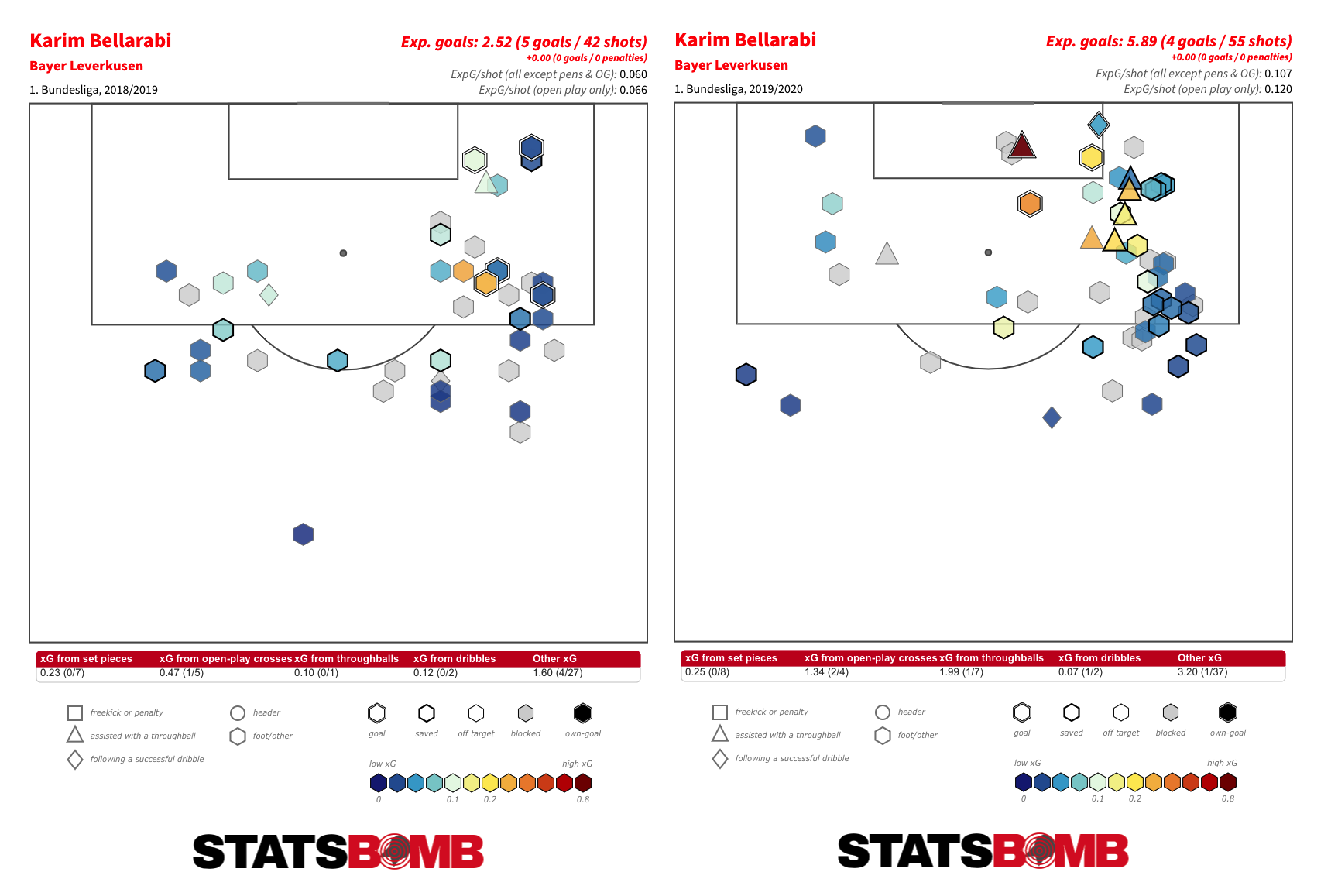
If we broaden our analysis to the proportion of right-sided shots amongst those attempted from all three zones, we encounter a few teams who struggle to create central shots and so attempt a relatively high proportion of efforts from both of the wider zones.
Stade Brestois are the prime example. No team have taken a larger proportion of their shots, generated a larger proportion of their xG or scored a larger proportion of their goals from the right this season. But only 51.08% of their shots from the two wider zones have been from that side. On a proportional basis, no team have taken less shots or scored less goals from the centre.
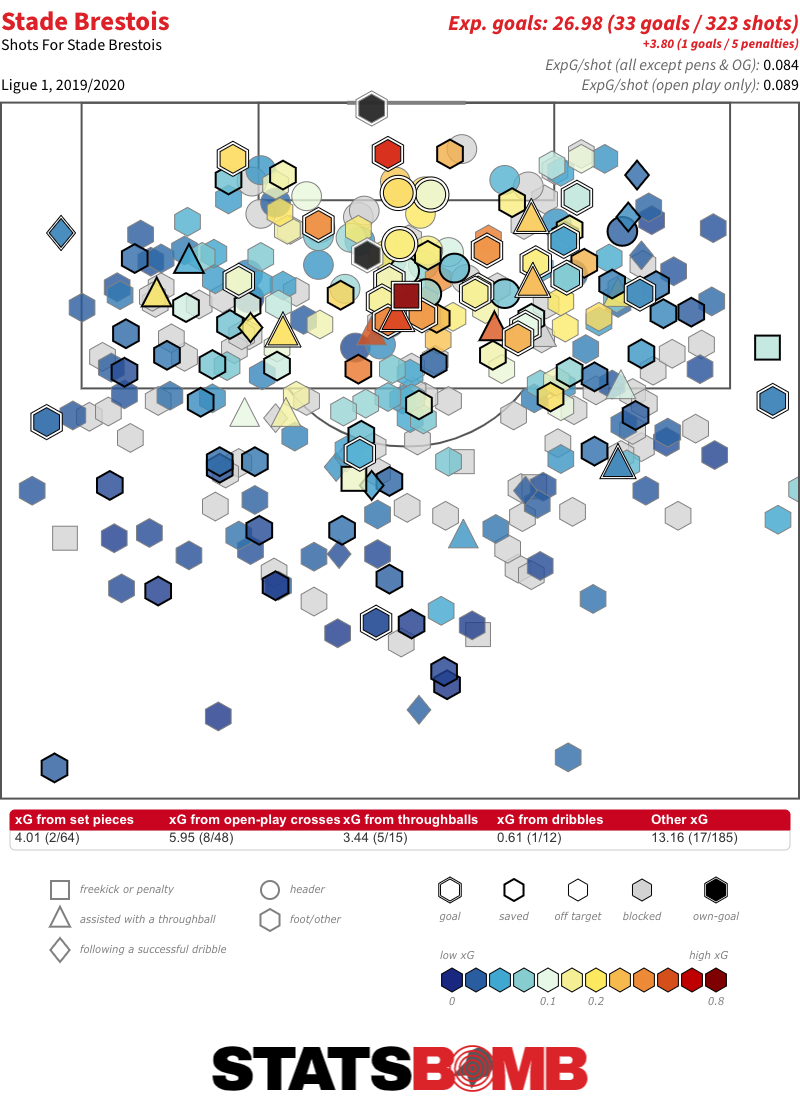
There are two teams with an almost perfect equilibrium between left and right-sided shots: Bayern Munich and Saint-Étienne. They have that in common, but the eventual outputs of their respective attacks almost couldn’t be more different:
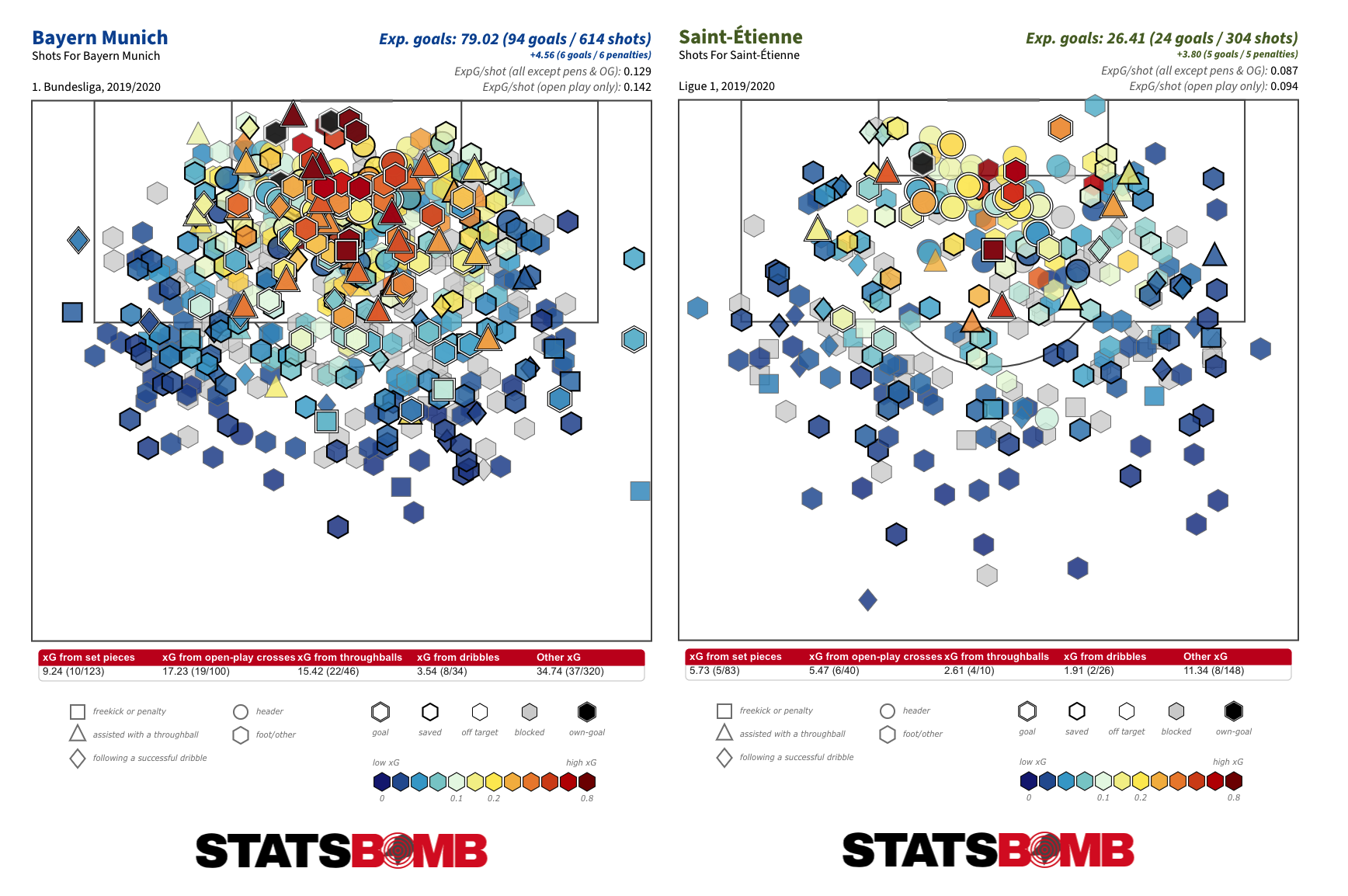
In fact, there is little evidence that the balance between left and right-sided shots has any marked effect on a team’s ability to create chances and goals. The top-10 highest scoring teams in the major European leagues this season display a variety of proportional breakdowns. It appears to be a stylistic indicator inevitably linked to the characteristics of the players out on the pitch rather than something that correlates with top-line outputs.
To finish up, a few tidbits:
- both Bournemouth and Torino have failed to score a single goal from a right-sided shot this season. Torino from 81 shots and 4.82 xG; Bournemouth from 48 shots and 3.16 xG.
- Espanyol are the only side not to have scored a single goal from a left-sided shot. That from 69 attempts and 2.94 xG.
- highest average quality shot from the left: Paris Saint-Germain (0.11 xG/Shot), Barcelona (0.10), Liverpool (0.09), Dijon (0.08), Borussia Dortmund (0.08).
- lowest average quality shot from the left: Mallorca (0.04 xG/Shot), SPAL (0.04), Espanyol (0.04), Genoa (0.04), Granada (0.04).
- highest average quality shot from the right: Borussia Monchengladbach (0.10 xG/Shot), Paris Saint-Germain (0.10), Hertha Berlin (0.09), Borussia Dortmund (0.09), RB Leipzig (0.09).
- lowest average shot quality from the right: Granada (0.04 xG/Shot), Espanyol (0.04), Mallorca (0.04), Genoa (0.04), Leganés (0.05).
The Premier League follows in the footsteps of the Bundesliga and La Liga in returning to action this week. Given it has been three months since a ball was last kicked in anger, perhaps it’s time to remind ourselves of how things stand in the major contests at both ends of the table. The Title Let’s be honest, Liverpool are going to lift the Premier League trophy. They’ve crushed this season, winning 27 of their 29 matches to open up a 25-point lead at the top. They need just two wins (or some other combination of results that yields six points) from their remaining nine to claim their first league title in 30 years. European Places This is where it gets interesting, particularly if Manchester City’s European ban stands. Remove them from the equation, and do likewise with the third-placed Leicester side who, despite a downward trend in their underlying numbers, enjoy a 10-point cushion over the first non-qualifying position, and things look very spicy indeed in the competition for the two remaining Champions League spots. Six teams are separated by just eight points; Arsenal, the side at the bottom of that group, have a game in hand. [table id=83 /] Results and the underlying numbers over the course of the season to date have Chelsea pegged as a frontrunner, but after that it gets a little more murky. 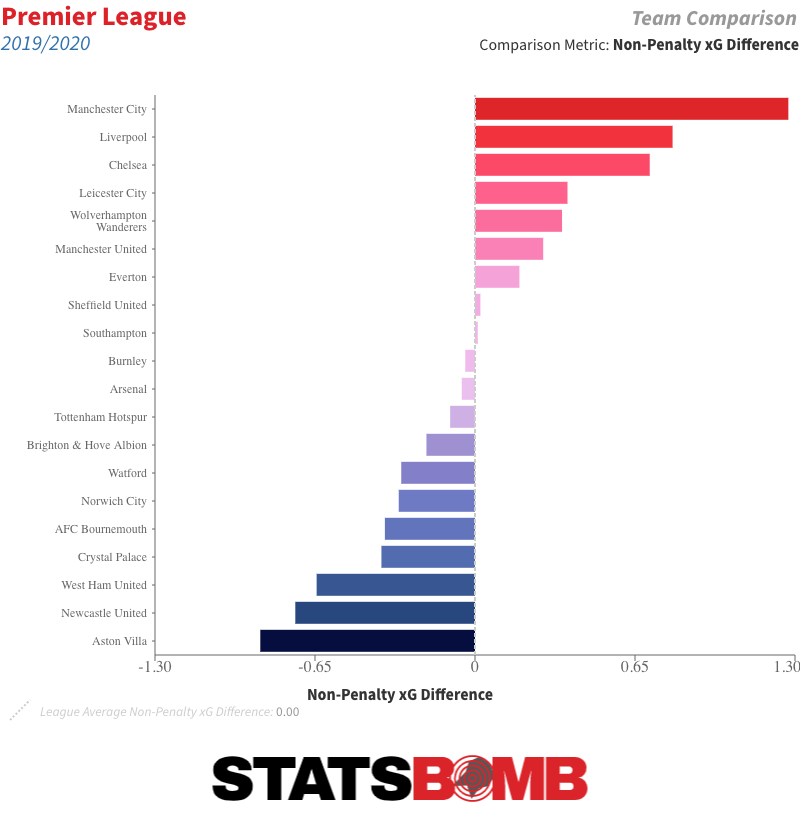 Manchester United and Wolverhampton Wanderers are separated by just two points, and are pretty much neck and neck on expected goal (xG) difference. The underlying numbers over the last 10 matches suggest the momentum is with Wolves...
Manchester United and Wolverhampton Wanderers are separated by just two points, and are pretty much neck and neck on expected goal (xG) difference. The underlying numbers over the last 10 matches suggest the momentum is with Wolves... 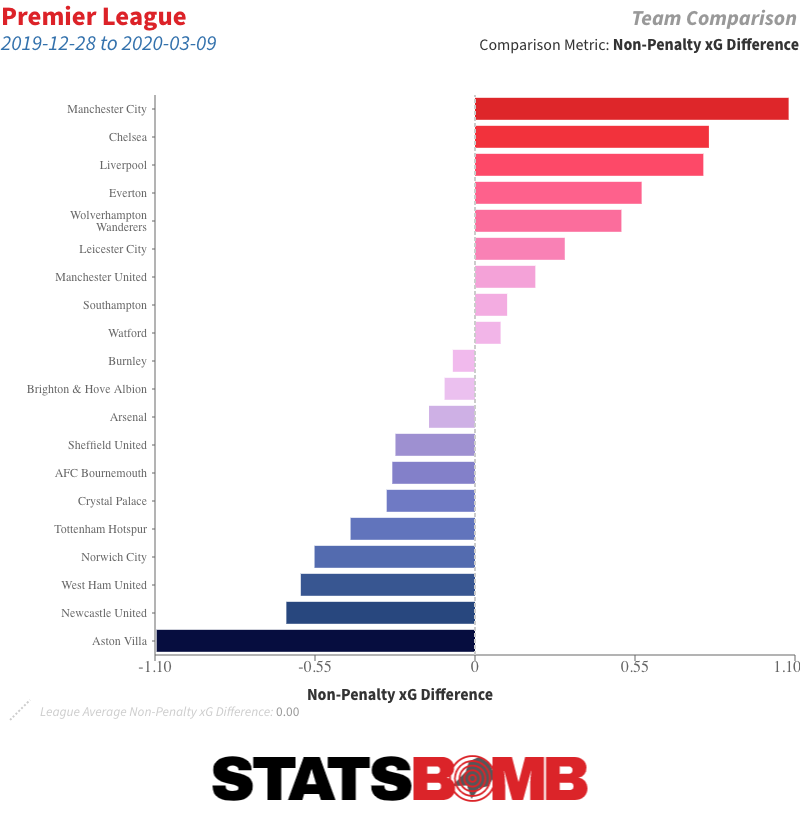 ...but it is United who have taken more points in that time: 17 to 13. These things often take much longer than nine matches to shake themselves out, especially when the differences are fairly minimal. United will also benefit from the return from injury of Marcus Rashford, their primary attacking contributor.
...but it is United who have taken more points in that time: 17 to 13. These things often take much longer than nine matches to shake themselves out, especially when the differences are fairly minimal. United will also benefit from the return from injury of Marcus Rashford, their primary attacking contributor. 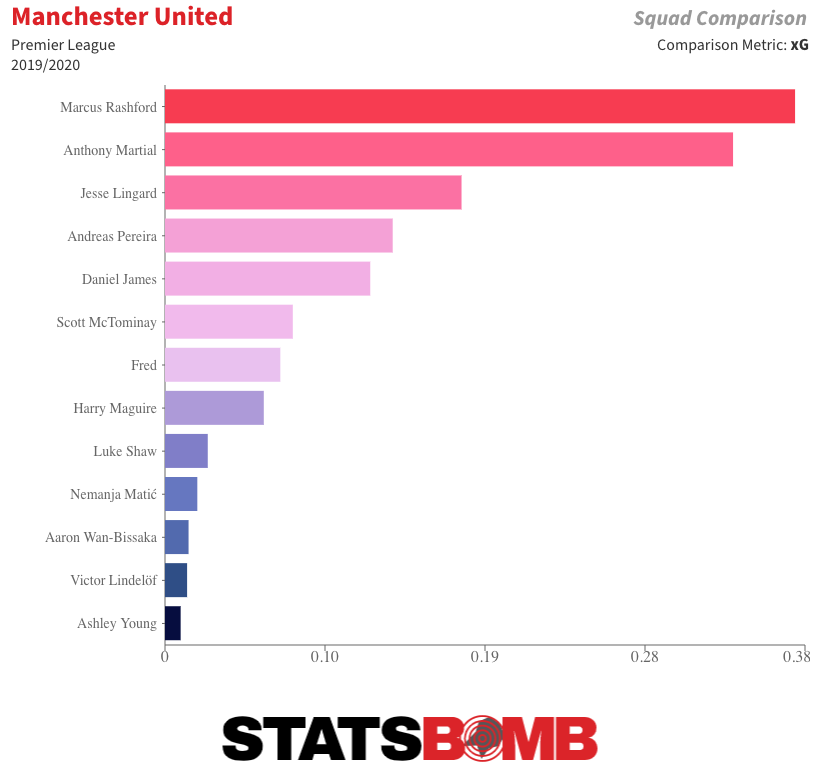 Tottenham Hotspur have also profited from the pause in action, as it has allowed them to recover some much-needed firepower in the form of Harry Kane and Heung-Min Son (as well as January recruit Steven Bergwijn).
Tottenham Hotspur have also profited from the pause in action, as it has allowed them to recover some much-needed firepower in the form of Harry Kane and Heung-Min Son (as well as January recruit Steven Bergwijn). 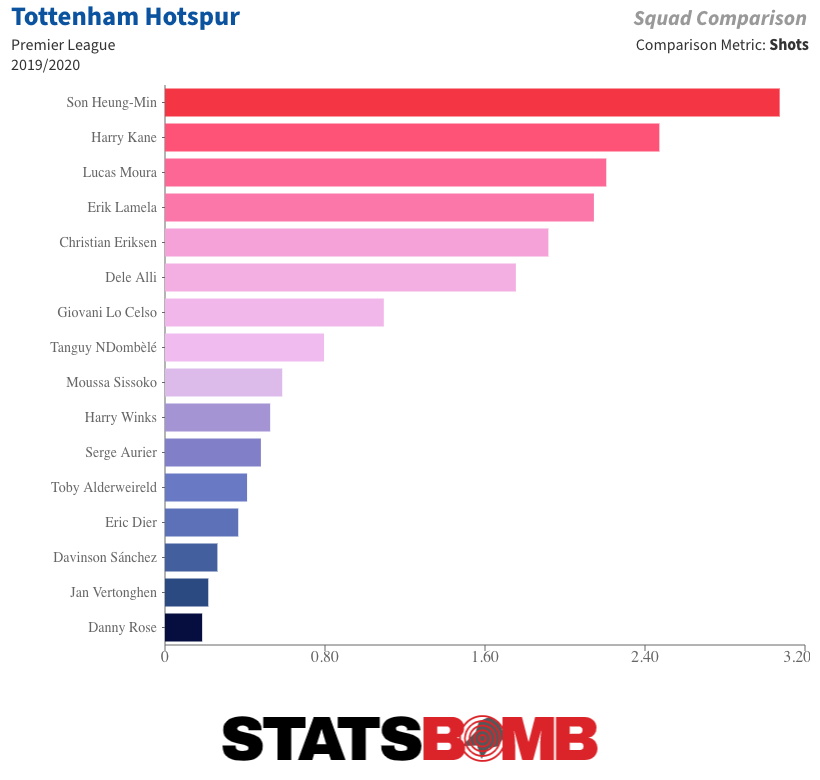 That alone is unlikely to turn things around for a side who after an initial surge under Jose Mourinho had combined mid-table results with downright sad underlying numbers in the lead up to the league stoppage, but it certainly won’t hurt their chances. Sheffield United are a couple of points ahead of Spurs and have a game in hand that if won would see them leapfrog United into fifth. They’ve already defied the odds by coming up and immediately establishing themselves as a very solid top-flight side, and while their numbers aren’t as good as those of some of the teams around them, they are still very much in the mix. Arsenal are at the back end of the group, and haven’t really shown enough signs of concrete improvement since Mikel Arteta replaced Unai Emery in December to give reason to believe they will end the campaign strongly. The two Champions League places and the two currently available Europa League places are likely to be filled by four of those six teams. But if the outcome of the FA Cup results in eighth place also yielding a spot in the latter competition, it could open to way to other challengers. Notably, an Everton side who have so far performed well below their underlying numbers.
That alone is unlikely to turn things around for a side who after an initial surge under Jose Mourinho had combined mid-table results with downright sad underlying numbers in the lead up to the league stoppage, but it certainly won’t hurt their chances. Sheffield United are a couple of points ahead of Spurs and have a game in hand that if won would see them leapfrog United into fifth. They’ve already defied the odds by coming up and immediately establishing themselves as a very solid top-flight side, and while their numbers aren’t as good as those of some of the teams around them, they are still very much in the mix. Arsenal are at the back end of the group, and haven’t really shown enough signs of concrete improvement since Mikel Arteta replaced Unai Emery in December to give reason to believe they will end the campaign strongly. The two Champions League places and the two currently available Europa League places are likely to be filled by four of those six teams. But if the outcome of the FA Cup results in eighth place also yielding a spot in the latter competition, it could open to way to other challengers. Notably, an Everton side who have so far performed well below their underlying numbers. 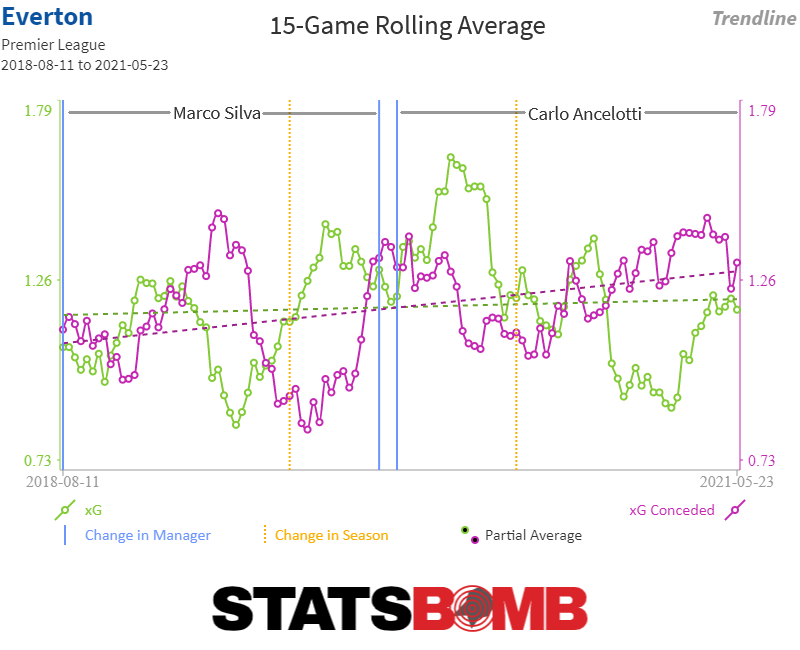 Relegation At the bottom of the table, there are probably six teams fighting to avoid filling the three relegation spots. Southampton, five points up the road from 15th placed Brighton and seven points clear of the bottom three, will likely be okay. [table id=84 /] Norwich are four points adrift at the bottom and it’s honestly difficult to see them making up the six points that separate them from safety. Their attempt to transplant their Championship approach and (largely the same) personnel to the top flight hasn’t really worked out for them. Aston Villa have had awful underlying numbers all season, particularly on the defensive side, where their concession of almost 18 shots per match has inevitably led to the worst xG conceded figure in the league.
Relegation At the bottom of the table, there are probably six teams fighting to avoid filling the three relegation spots. Southampton, five points up the road from 15th placed Brighton and seven points clear of the bottom three, will likely be okay. [table id=84 /] Norwich are four points adrift at the bottom and it’s honestly difficult to see them making up the six points that separate them from safety. Their attempt to transplant their Championship approach and (largely the same) personnel to the top flight hasn’t really worked out for them. Aston Villa have had awful underlying numbers all season, particularly on the defensive side, where their concession of almost 18 shots per match has inevitably led to the worst xG conceded figure in the league.  When your are conceding an average of two goals per match, you need your attack to be pretty damn good. Villa’s is only okay. They do, though, have a game in hand over those around them. Then comes the real action, four teams separated by just two points: Bournemouth, Watford, West Ham and Brighton. It is an incredibly hard race to call, and in truth, it wouldn’t be all that surprising if a similar number of points covered them come the end of the campaign. Watford have the momentum. Since Nigel Pearson became their third head coach of the season in early December, they’ve matched top-half results to top-half underlying numbers. There has been clear improvement, especially in defence.
When your are conceding an average of two goals per match, you need your attack to be pretty damn good. Villa’s is only okay. They do, though, have a game in hand over those around them. Then comes the real action, four teams separated by just two points: Bournemouth, Watford, West Ham and Brighton. It is an incredibly hard race to call, and in truth, it wouldn’t be all that surprising if a similar number of points covered them come the end of the campaign. Watford have the momentum. Since Nigel Pearson became their third head coach of the season in early December, they’ve matched top-half results to top-half underlying numbers. There has been clear improvement, especially in defence. 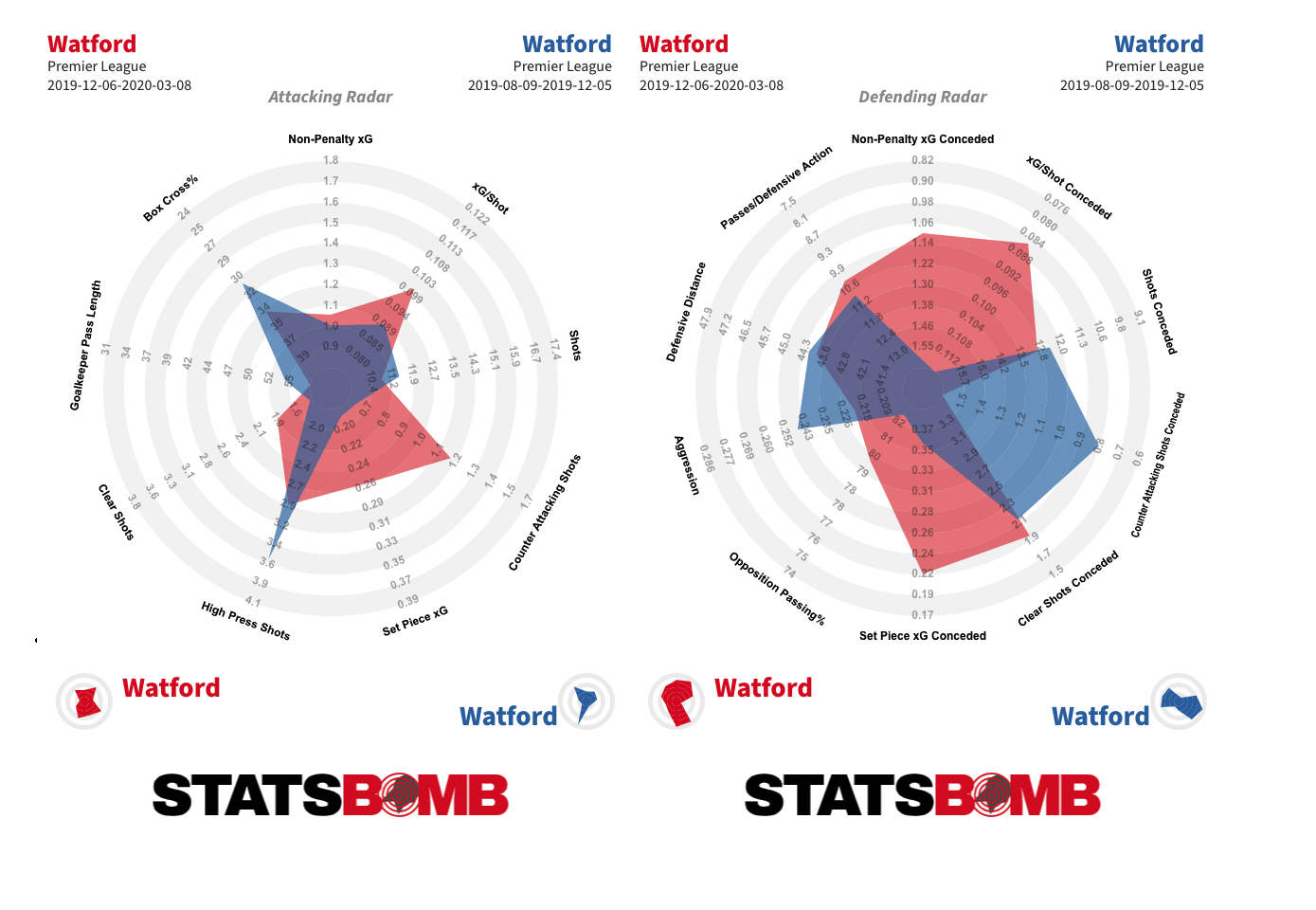 David Moyes has not yet had the same effect at West Ham. Results and underlying numbers have actually got marginally worse there since he replaced Manuel Pellegrini at the end of December. The stylistic changes are clear: deeper and more passive defending, and a greater reliance on transitional phases to create shots. The end result is all but unchanged.
David Moyes has not yet had the same effect at West Ham. Results and underlying numbers have actually got marginally worse there since he replaced Manuel Pellegrini at the end of December. The stylistic changes are clear: deeper and more passive defending, and a greater reliance on transitional phases to create shots. The end result is all but unchanged. 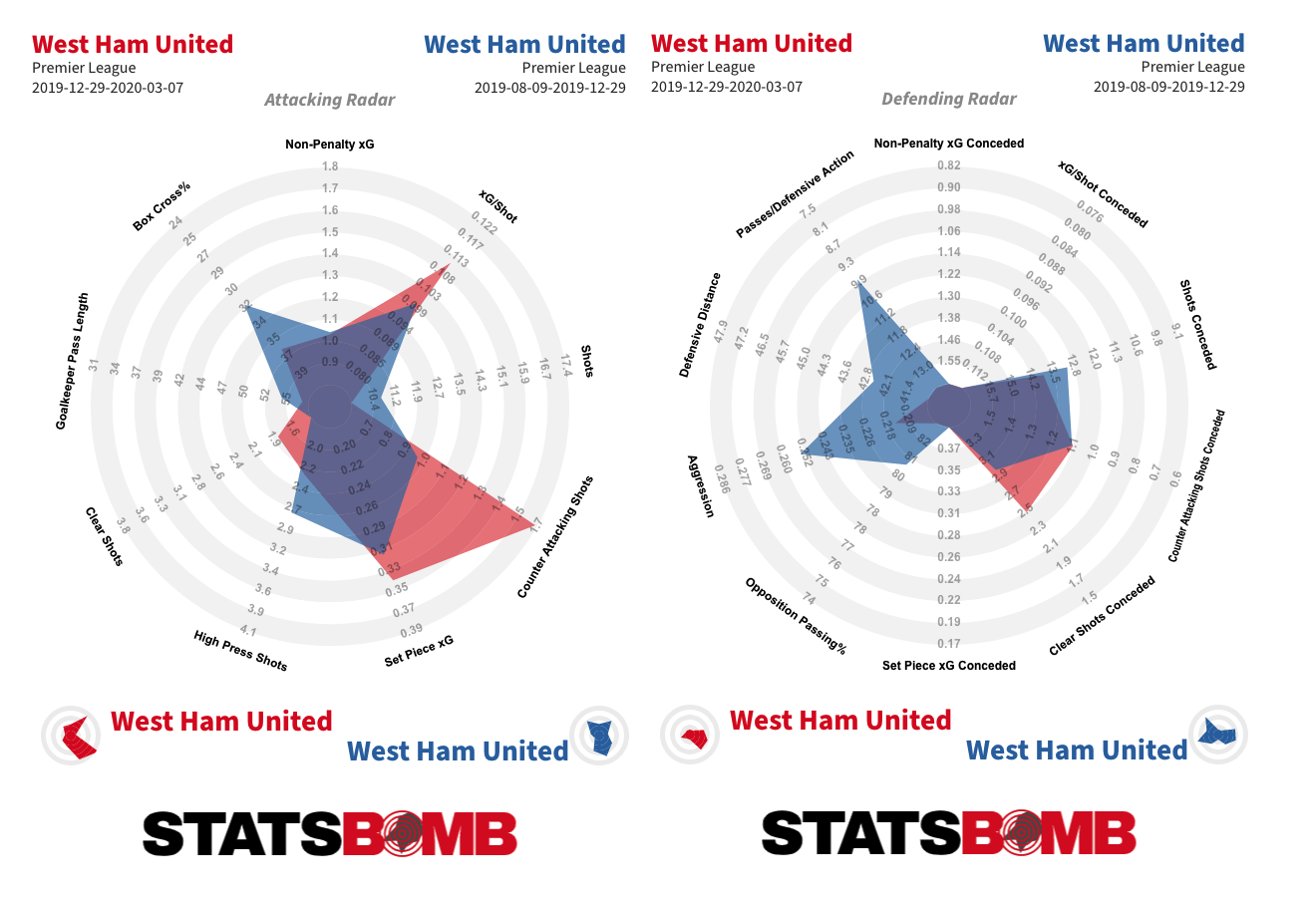 Bournemouth are one of the worst six teams by the underlying numbers and slipped into the bottom three off the back of three defeats and a draw prior to the league stoppage. They don’t inspire a great deal of confidence at either end of the pitch, and may have to lean on their set-piece ingenuity to steer themselves to safety.
Bournemouth are one of the worst six teams by the underlying numbers and slipped into the bottom three off the back of three defeats and a draw prior to the league stoppage. They don’t inspire a great deal of confidence at either end of the pitch, and may have to lean on their set-piece ingenuity to steer themselves to safety.  Brighton are yet to win a match this calendar year, and in fact have won only once in their last 14. No team have taken fewer points in 2020. While it is fairly easy to pinpoint the stylistic changes made since Graham Potter took charge last summer, it is not translating to results. Their underlying numbers are those of a mid-table side, and that would normally be enough to suggest they’ll probably be okay. But then you look at their remaining schedule, which includes encounters with four of the current top five across their next six matches, and it’s hard to be quite so sure.
Brighton are yet to win a match this calendar year, and in fact have won only once in their last 14. No team have taken fewer points in 2020. While it is fairly easy to pinpoint the stylistic changes made since Graham Potter took charge last summer, it is not translating to results. Their underlying numbers are those of a mid-table side, and that would normally be enough to suggest they’ll probably be okay. But then you look at their remaining schedule, which includes encounters with four of the current top five across their next six matches, and it’s hard to be quite so sure.
We’ve reached the 21st century in this week’s edition of our history of the European Cup, as we take a look at the 2009 final between Barcelona and Manchester United. Nearly a decade and a half on from the last one we covered, this is now recognisably the football of the modern age.
This is the fifth entry in our series.
We’ve already analysed:
- 1960: Real Madrid 7 - 3 Eintracht Frankfurt
- 1972: Ajax 2 - 0 Inter Milan
- 1989: AC Milan 4 - 0 Steaua Bucharest
There were some familiar faces from some of those finals in this one. Manchester United goalkeeper Edwin van de Sar had started for Ajax in 1995; Patrick Kluivert, scorer of the winning goal in that match, was in amongst the Barcelona support; Johan Cruyff, scorer of both goals is the 1972 final, was watching on from a more tranquil post.
Less directly, a then 18-year-old Sir Alex Ferguson had attended the 1960 final at Hampden Park and been left spellbound by the brilliance of that Real Madrid side.
United were the competition holders following their penalty shoot out win over Chelsea in the 2008 final, and had just wrapped up the Premier League title. Barcelona, in Pep Guardiola’s first season as head coach, had already secured a domestic double.
United Start Strong, Barcelona Gain Control
United were considered the pre-match favourites (marginally by the bookmakers; more robustly by the more insulated members of the British sporting press), and began on the front foot with a series of quick-fire attacks that saw them register five shots within the opening nine minutes. Only a sliding block from Gerard Piqué prevented Park Ji-Sung from turning in the rebound from a parried Cristiano Ronaldo free-kick.
With both of their regular full-backs Dani Alves and Eric Abidal suspended, and central defensive option Rafael Márquez also out injured, Barcelona fielded a makeshift backline that featured Yaya Touré alongside Piqué in the centre of defence. Touré played as if he was still in midfield, stepping out, shadowing opponents and taking time to regain his position. He settled in a bit as the match went on, but he was still regularly found in advance of his defensive colleagues.


Not that it mattered all that much because after that initial United flurry, Barcelona took control of the match off the back of a goal from Samuel Eto’o. Xavi, Andres Iniesta and Lionel Messi combined through the centre for the first time, Iniesta moved the ball on to Eto’o, and he skipped inside Nemanja Vidic before prodding home in the 10th minute of play.
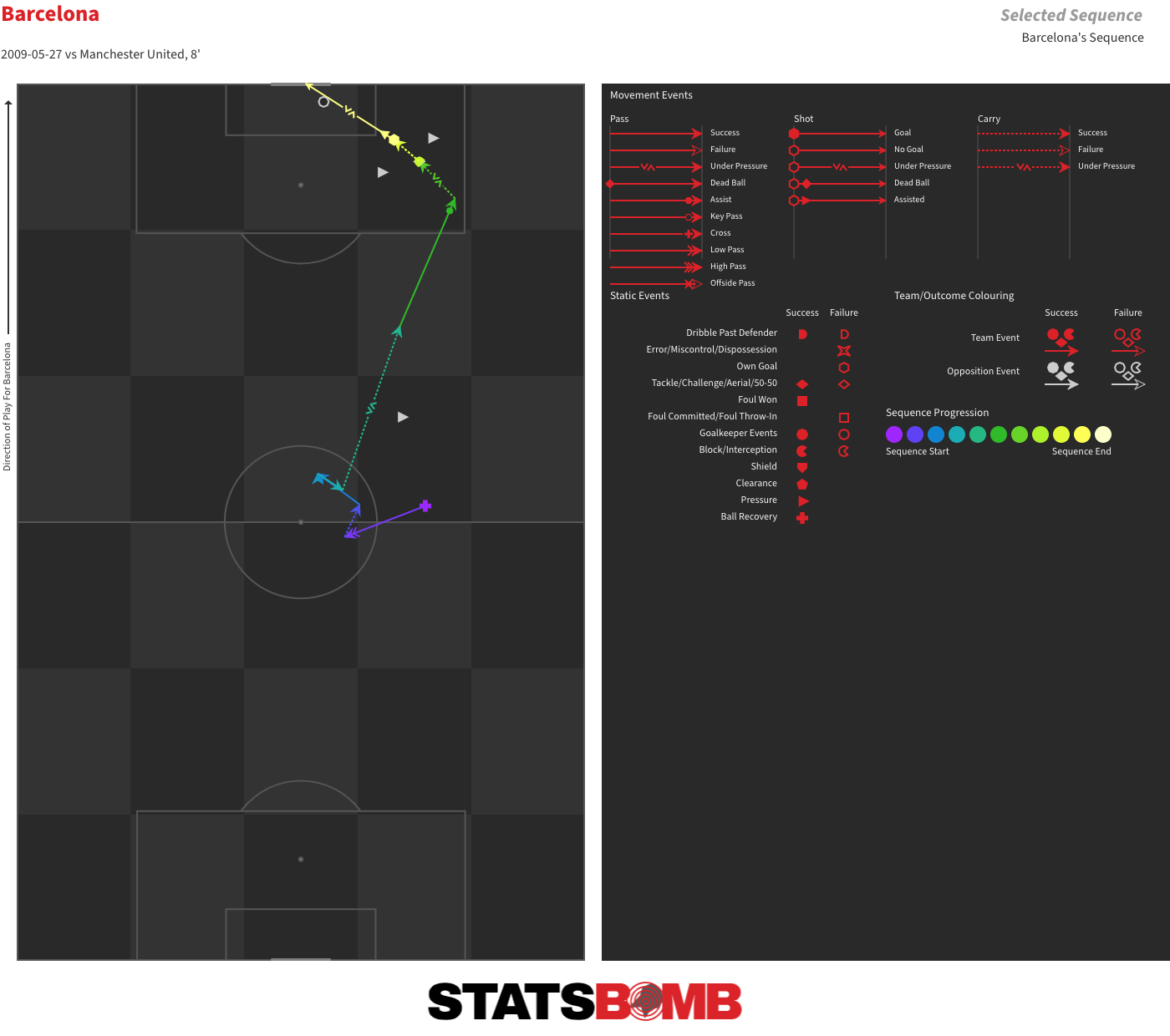
As in Barcelona’s 6-2 victory over Real Madrid in the league earlier the same month (a match we covered in detail as part of our series on Messi’s evolution), Messi lined up here as a False 9, with Eto’o and Thierry Henry either side of him as wide forwards.
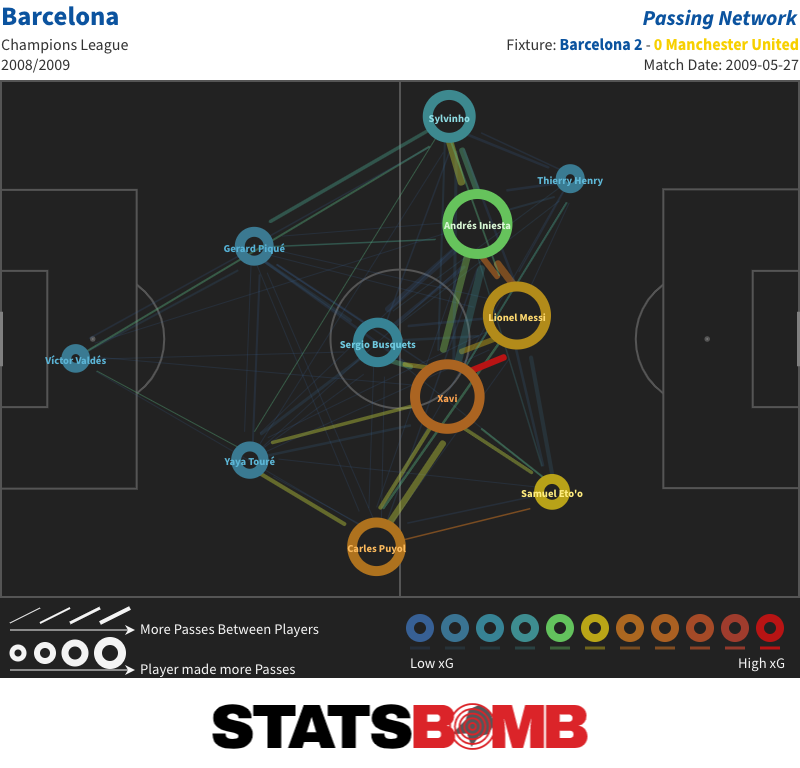
Just as in that match, it was Barcelona’s numerical superiority in the centre of pitch, with Messi essentially at the head of a diamond that had Sergio Busquets at its base, that allowed them to take control. For a while, there were still spaces for United to attack in transition. Piqué obstructed Ronaldo to prevent him getting into the area from a nice diagonal pass from Ryan Giggs. But those opportunities all but disappeared as Barcelona started to string together long sequences of controlled and progressive possession.
This sequence, which ended with a foul on Iniesta, acts as a good example of the way in which Guardiola’s side were able to move the ball and keep it away from United. Iniesta, Messi and Xavi were all heavily involved.
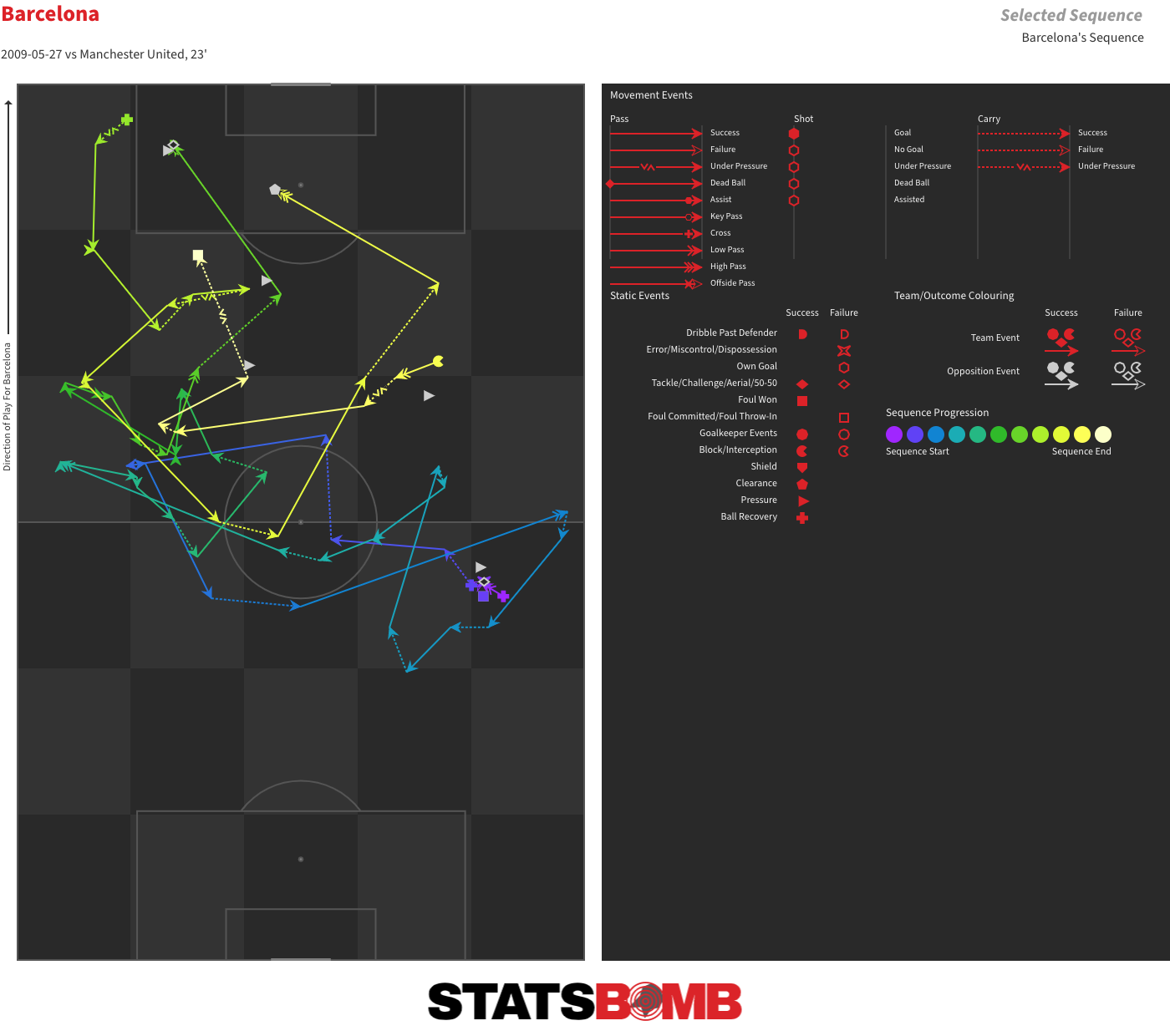
United seemed to have little response. From Barcelona’s opener until the 72nd minute, by which time Messi had doubled their lead, they mustered just three shots, including just one from open play. They got off none at all for almost 50 minutes after Ronaldo’s header wide from a corner on 23 minutes. Their offence was a flatline for over half the match despite the presence of Ronaldo, Wayne Rooney, and following his half-time introduction, Carlos Tevez.
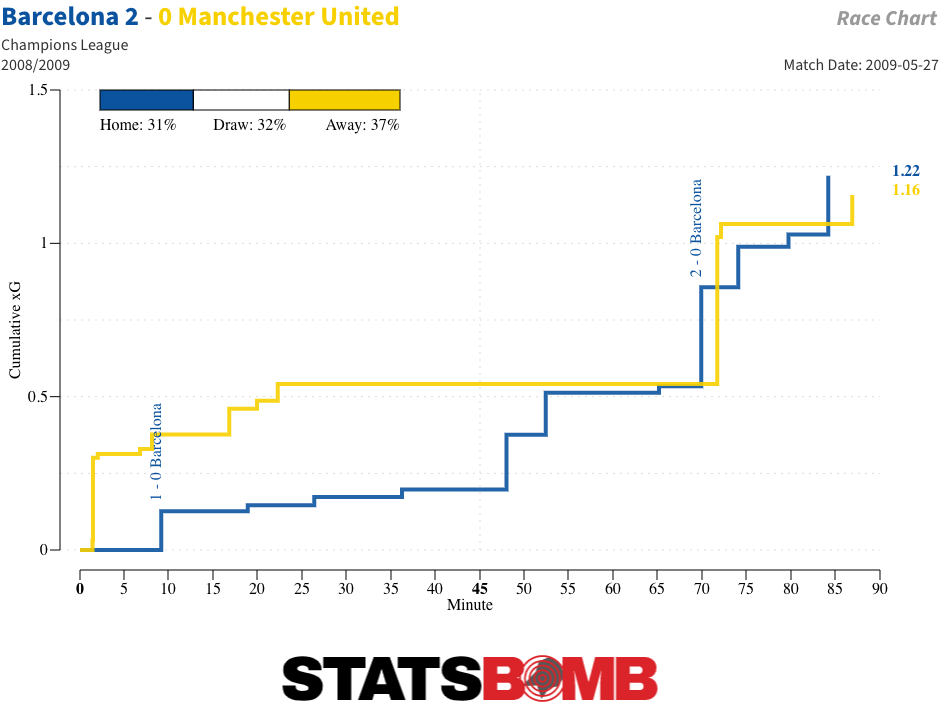
In fact, with Tevez on the field in place of Anderson, United found it even harder to get on the ball, and Barcelona began to close in on a second goal. A lovely piece of footwork from Iniesta began a swift attack that ended in a presentable Henry chance saved; Xavi hit the post with a free-kick from the edge of the area; and then, after a lull, Messi rose to head home Xavi’s pinpoint cross and all but end the match as a contest.
Xavi had an excellent match, as did Iniesta, whose touches left the Spanish commentators purring on multiple occasions. He was a reliable receiver under pressure, and a very able ball carrier. He advanced the ball into the final third more often than any other Barcelona player.
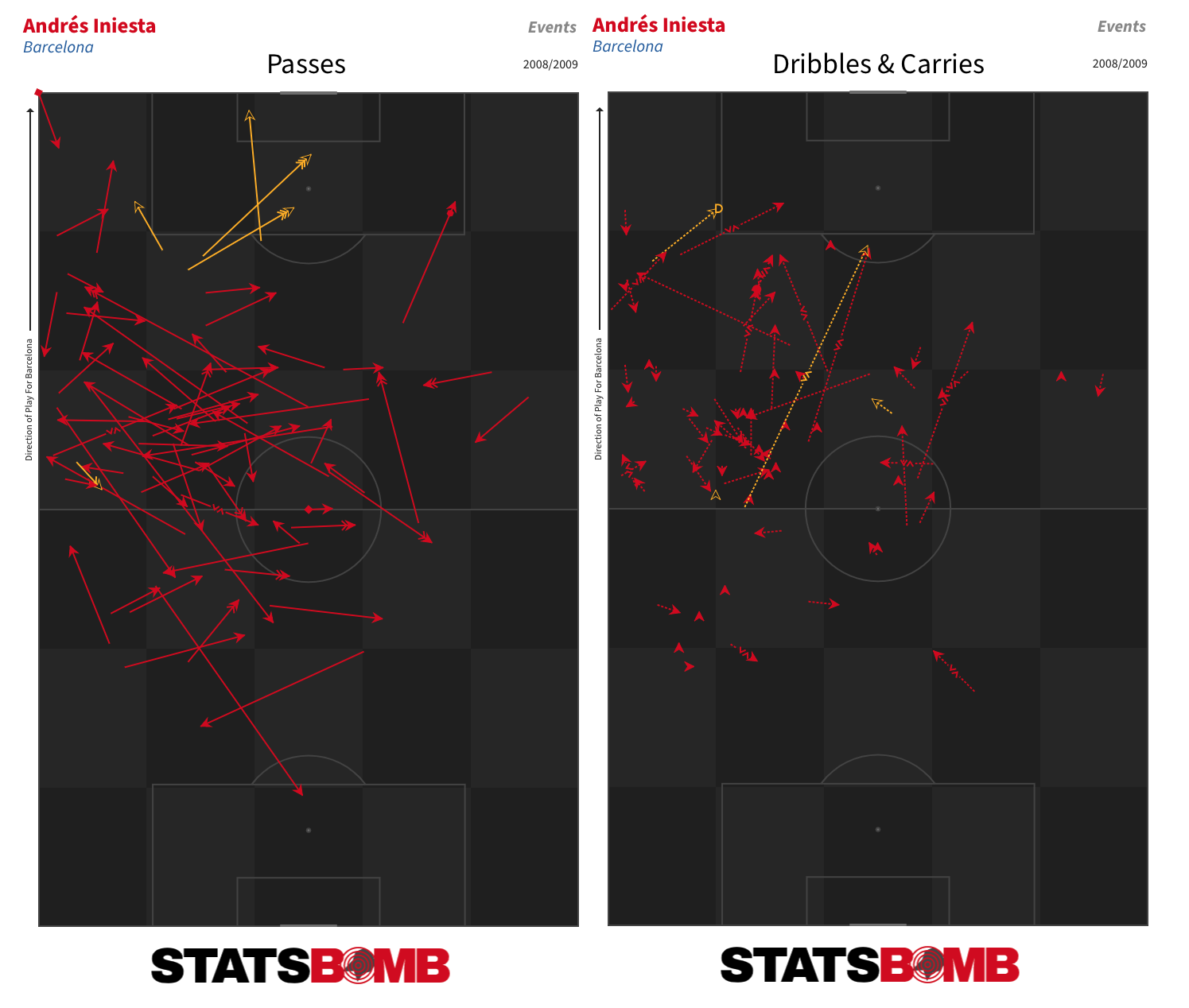
United came close to getting one back almost straight from kickoff following Barcelona’s second goal, but Giggs mis-kicked before Ronaldo had his low effort saved behind by Victor Valdés. From then on, they never looked likely to get back into it. Over the full course of the match, the two teams were evenly matched in terms of chances, but the timing of that first goal changed the complexion of the contest. From then on, Barcelona were in charge.
A Sign of Things to Come
There were spells in this match in which in contrast with the supple shifting of their opponents, United looked decidedly leaden-footed on the ball. While extended Barcelona possessions often eventually resulted in progress towards goal, United’s longer sequences regularly produced a steadily decreasing possibility of meaningful advancement. The counter-attack was their most dangerous weapon, and Barcelona swiftly neutered it.
This match acted as a preview of the prevailing style clash of the following years. Spain had won the European Championship the year previous, and they and Barcelona set a template that other teams were forced to adapt to. Their approach was dissected and counter-measures created. In La Liga, this 2008-09 Barcelona side still has the best expected goal difference of any in the Messi era. Subsequently, both their and Spain’s use of possession as a means of control became ever-more pronounced.
Not that the intervening couple of years and various demonstrations of ways of potentially countering Guardiola’s Barcelona did United any good. By the time the two teams met again in the 2011 final, the gap between them had widened considerably.
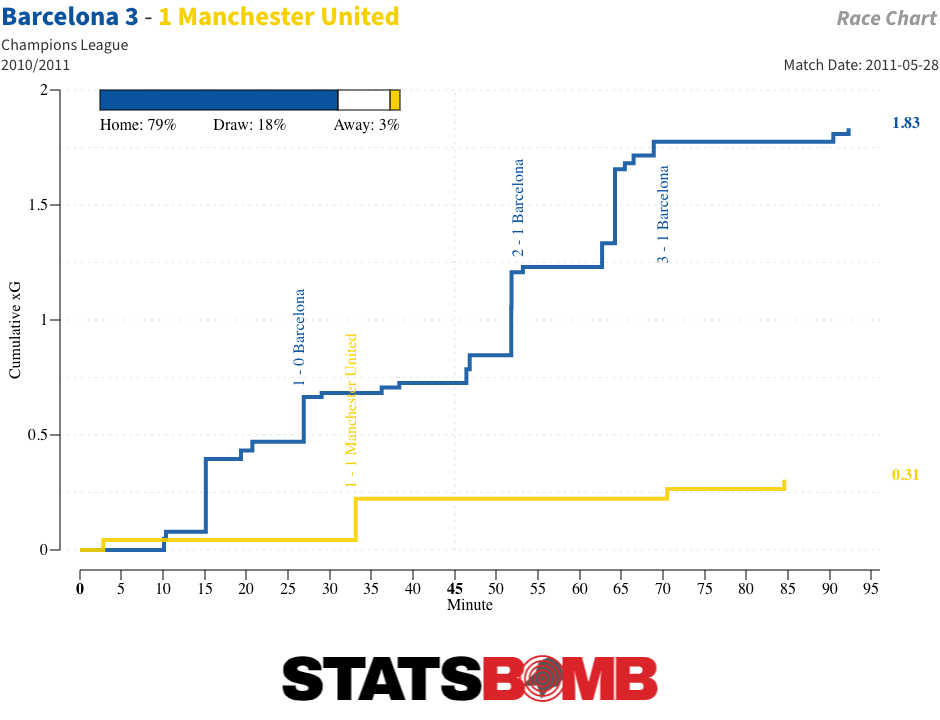
Shot Distances
This match felt like one from the modern era partly because it was the first we’ve seen that featured a reasonable spread of shots of decent average quality. Aside from a few speculative efforts from Ronaldo (after one of which, the sadly recently deceased Michael Robinson noted: “I’m more than happy for him to shoot from there. If it goes in, we’ll take off our hats to him, but very few are going to go in from there.”) and others, it was a set of shots of an average quality much closer to the contemporary average.
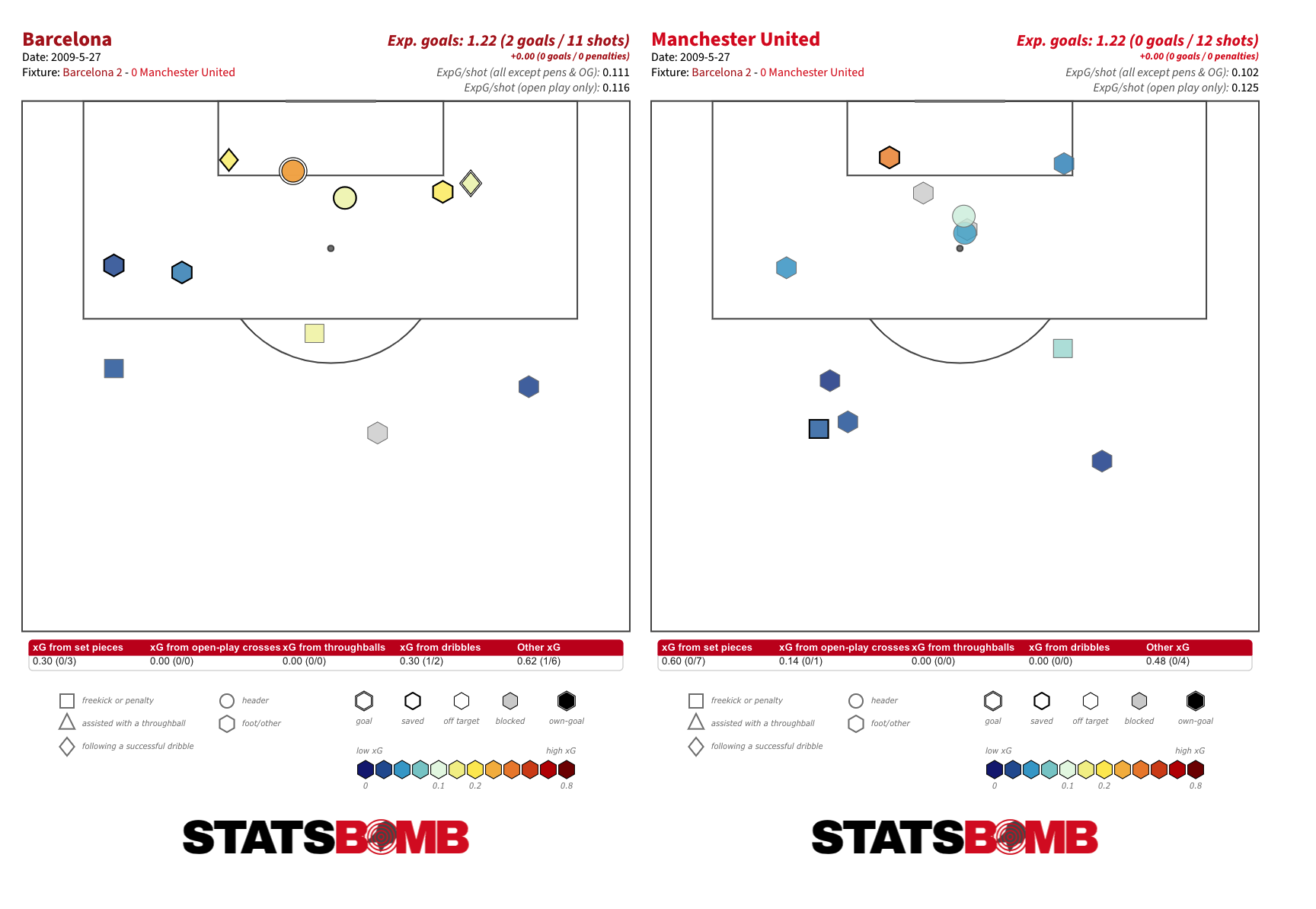
Over the last four finals of this series, there has been a consistent decrease in both the average shot distance and the percentage of efforts from outside the area.
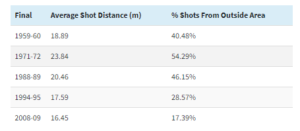
The only outlier is the 1960 final, likely because the heaviness of the ball in that age rendered long-range efforts inefficient. The only other relatively contemporaneous match in our system is the 1953 friendly between Hungary and England at Wembley, which had an even closer average shot distance and featured a lower percentage of efforts from outside the area.
It’s nearly two years since the StatsBomb site was relaunched in its current form, and I’ve been writing about the Premier League here for most of that time. With no football until God knows when, now is the best time to take stock and look at what we’ve learnt over the past couple of seasons. Expected Goals catch up to you... eventually It’s May 2018 and Manchester United are flying high-ish. A second place finish with 81 points is comfortably the best they’ve done in the post-Sir Alex Ferguson era, even if Pep Guardiola’s Manchester City look a long way off. The usual rumblings with Jose Mourinho are going on in the background, but with the right signings there’s no reason why this positive trajectory can’t continue, right? Unfortunately for Man Utd, the rot had already set in some time ago. The 2017/18 season saw them concede nearly 14 goals fewer than expected, while scoring an extra 10. The data suggested the most likely outcome was a decline in results, and guess what? Well, you’re reading a football analytics website in the middle of the coronavirus pandemic, so you probably know Mourinho was sacked by Christmas. It’s true that the side did decline in other ways, but the xG overperformance coming to an end was paramount. United actually conceded 3.5 more goals than expected in 2018/19, and though they scored an additional 4.4, we’re not talking about hugely significant finishing gains.  The same story came true for Mauricio Pochettino at Tottenham, although it took its time. If we look at the xG trendlines, it’s pretty startling how much Spurs start to decline in both attack and defence around spring 2018 and never recover.
The same story came true for Mauricio Pochettino at Tottenham, although it took its time. If we look at the xG trendlines, it’s pretty startling how much Spurs start to decline in both attack and defence around spring 2018 and never recover. 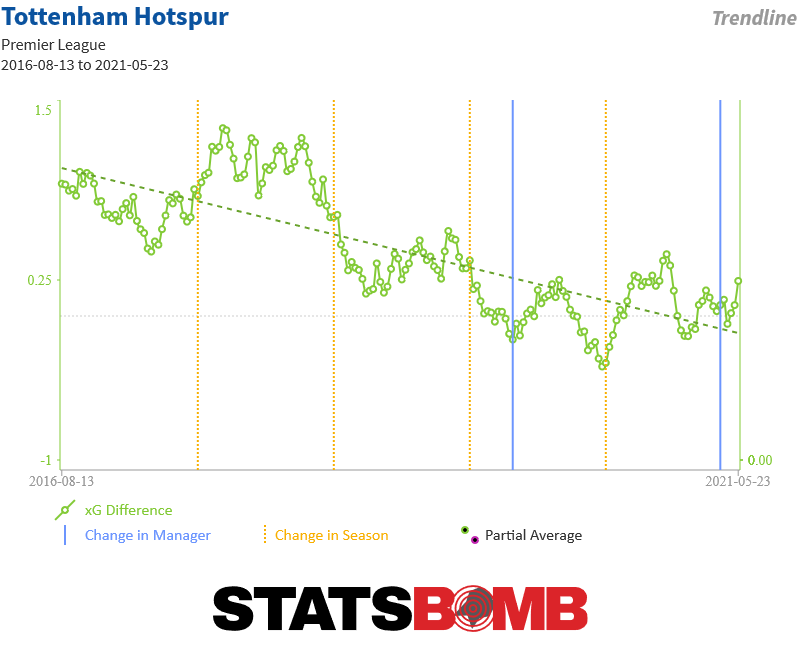 Spurs spent calendar year 2018 beating xG at both ends of the pitch, scoring nearly 17 extra goals and conceding almost 9 fewer than expected. A number of reasons were put forward to explain this: good goalkeeping from Hugo Lloris, elite finishing from the likes of Harry Kane and Son Heung-min, or even Pochettino’s tactics. It’s entirely possible that some of those factors were in play, but ultimately you can’t outrun xG forever. Different ways to get it forward Liverpool are 25 points clear at the top of the Premier League table. If we ever play the rest of the season out, it will be a coronation process for the Reds. The biggest stats story with Liverpool is in how they move the ball forward. Looking at the graph below, we can see the players most used in moving the ball both into the final third (x-axis) and then into the box (y-axis) are the two full backs, Trent Alexander-Arnold and Andrew Robertson.
Spurs spent calendar year 2018 beating xG at both ends of the pitch, scoring nearly 17 extra goals and conceding almost 9 fewer than expected. A number of reasons were put forward to explain this: good goalkeeping from Hugo Lloris, elite finishing from the likes of Harry Kane and Son Heung-min, or even Pochettino’s tactics. It’s entirely possible that some of those factors were in play, but ultimately you can’t outrun xG forever. Different ways to get it forward Liverpool are 25 points clear at the top of the Premier League table. If we ever play the rest of the season out, it will be a coronation process for the Reds. The biggest stats story with Liverpool is in how they move the ball forward. Looking at the graph below, we can see the players most used in moving the ball both into the final third (x-axis) and then into the box (y-axis) are the two full backs, Trent Alexander-Arnold and Andrew Robertson. 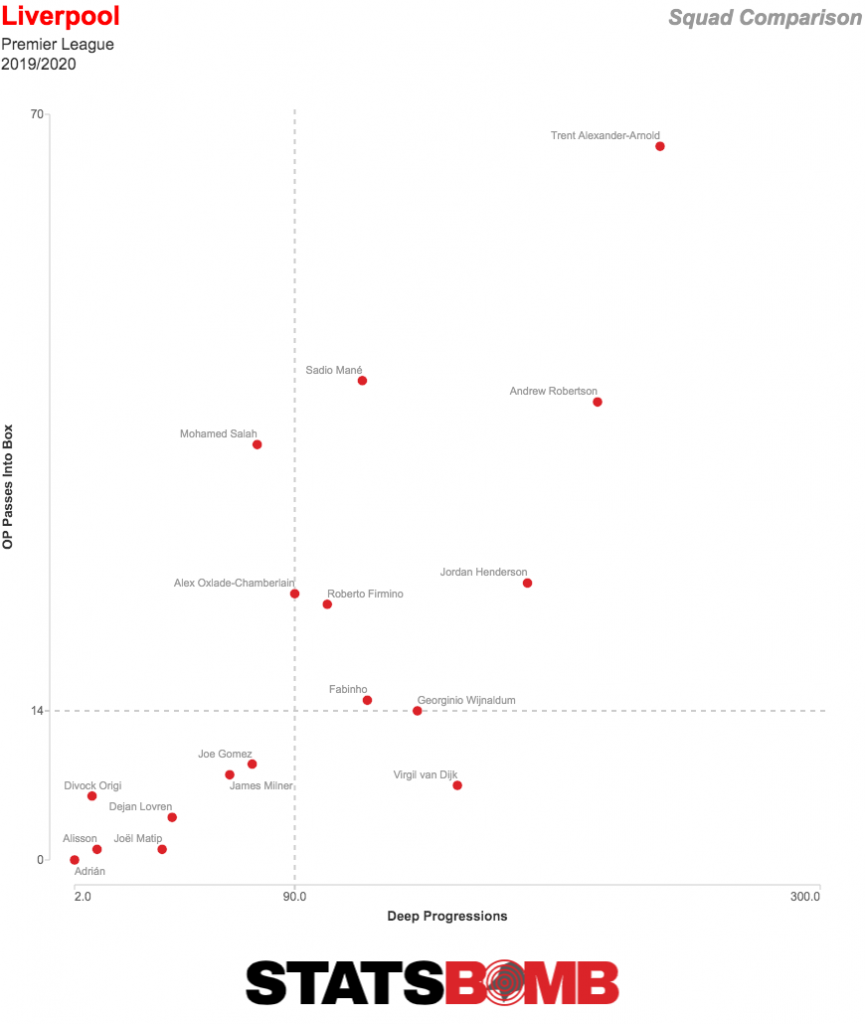 But then we take a look at second placed Manchester City, and a different story emerges. It’s Kevin De Bruyne town, with the full backs a much smaller part of the picture.
But then we take a look at second placed Manchester City, and a different story emerges. It’s Kevin De Bruyne town, with the full backs a much smaller part of the picture. 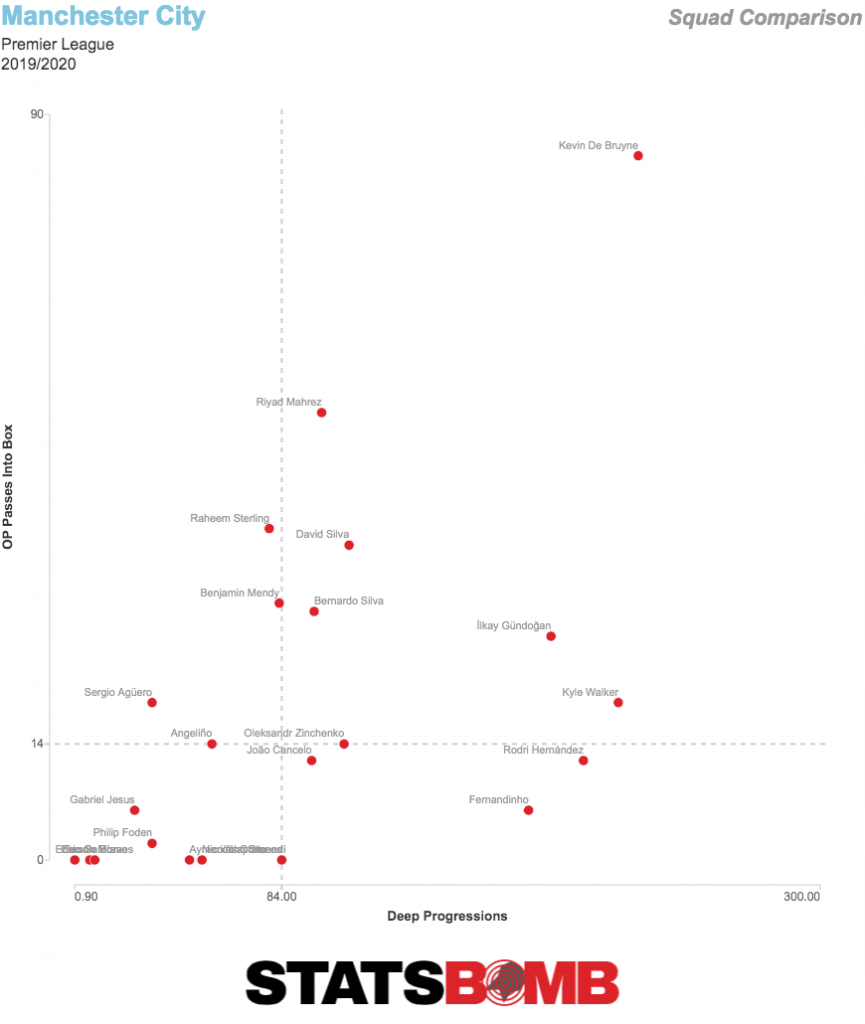 The top of the Premier League has two entirely different models for how a team should be able to get the ball forward without sacrificing solidity. There’s the Jürgen Klopp model, which takes the view that midfield should be kept as tight and ugly as possible, but then giving the full backs freedom to roam and become key players in the attack. The Pep Guardiola model, conversely, uses the full backs as facilitators in the midfield areas to make the side more solid, then allowing some of the nominal midfielders to be more involved in the final third. Both “work”, but it helps show the greater tactical variance in the league from 20, 10 or even 5 years ago. High pressing works, but there are other ways There has not historically been an obvious way of measuring "pressing", and a raw count of StatsBomb's pressure data does not instantly show a solution. When we look at the teams making the most pressures, we see a list that doesn't really correspond to most people's ideas of the Premier League's high pressing sides.
The top of the Premier League has two entirely different models for how a team should be able to get the ball forward without sacrificing solidity. There’s the Jürgen Klopp model, which takes the view that midfield should be kept as tight and ugly as possible, but then giving the full backs freedom to roam and become key players in the attack. The Pep Guardiola model, conversely, uses the full backs as facilitators in the midfield areas to make the side more solid, then allowing some of the nominal midfielders to be more involved in the final third. Both “work”, but it helps show the greater tactical variance in the league from 20, 10 or even 5 years ago. High pressing works, but there are other ways There has not historically been an obvious way of measuring "pressing", and a raw count of StatsBomb's pressure data does not instantly show a solution. When we look at the teams making the most pressures, we see a list that doesn't really correspond to most people's ideas of the Premier League's high pressing sides. 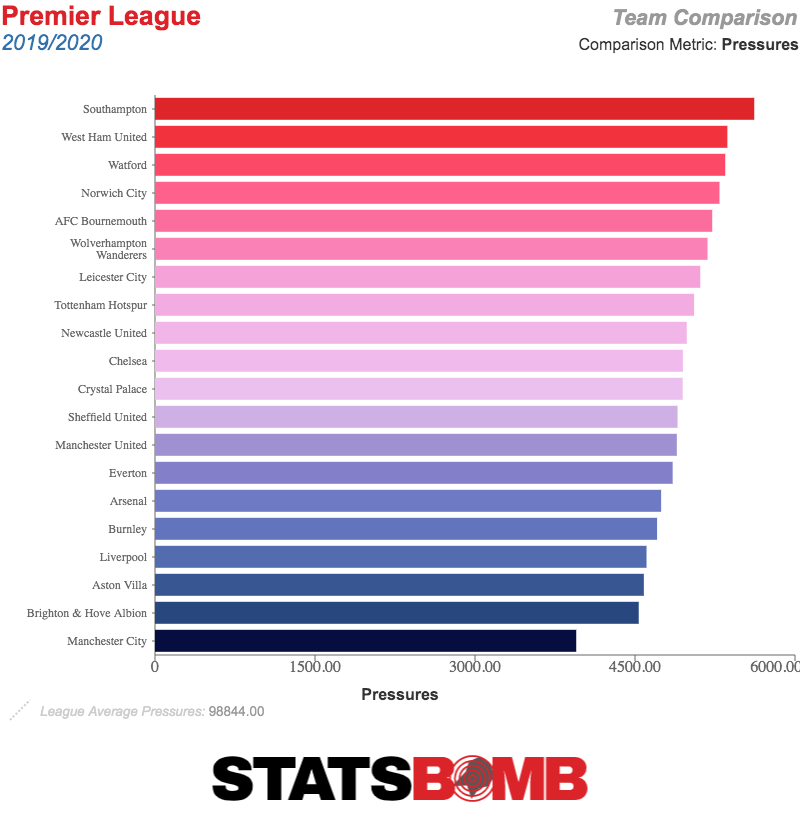 Man City at the bottom! That includes a lot of chaotic defending in teams' own third, so let's strip it down just to pressures in the opposing half. There's a little more of a pattern here.
Man City at the bottom! That includes a lot of chaotic defending in teams' own third, so let's strip it down just to pressures in the opposing half. There's a little more of a pattern here. 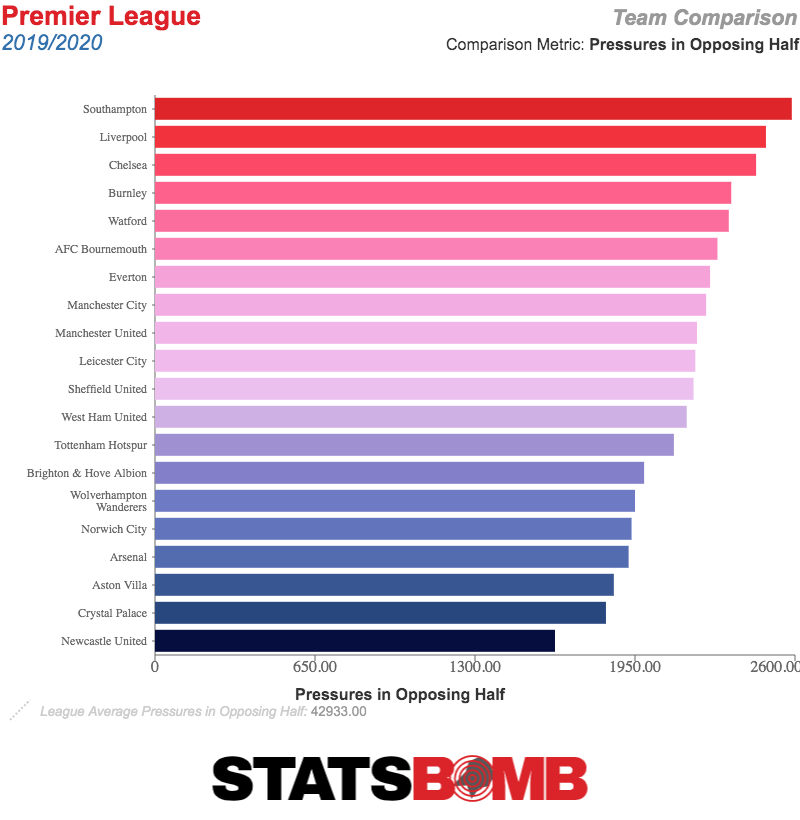 Man City still look like a middling pressing team, which obviously isn't what most people see with their eyes. They have so much possession that they're rarely having to make many pressures, which is the issue here. Raw numbers of pressures don't seem to tell us much of note. If we just look at the percentage of all pressures made in the opposing half, then guess what? City shoot up to the top of the table.
Man City still look like a middling pressing team, which obviously isn't what most people see with their eyes. They have so much possession that they're rarely having to make many pressures, which is the issue here. Raw numbers of pressures don't seem to tell us much of note. If we just look at the percentage of all pressures made in the opposing half, then guess what? City shoot up to the top of the table. 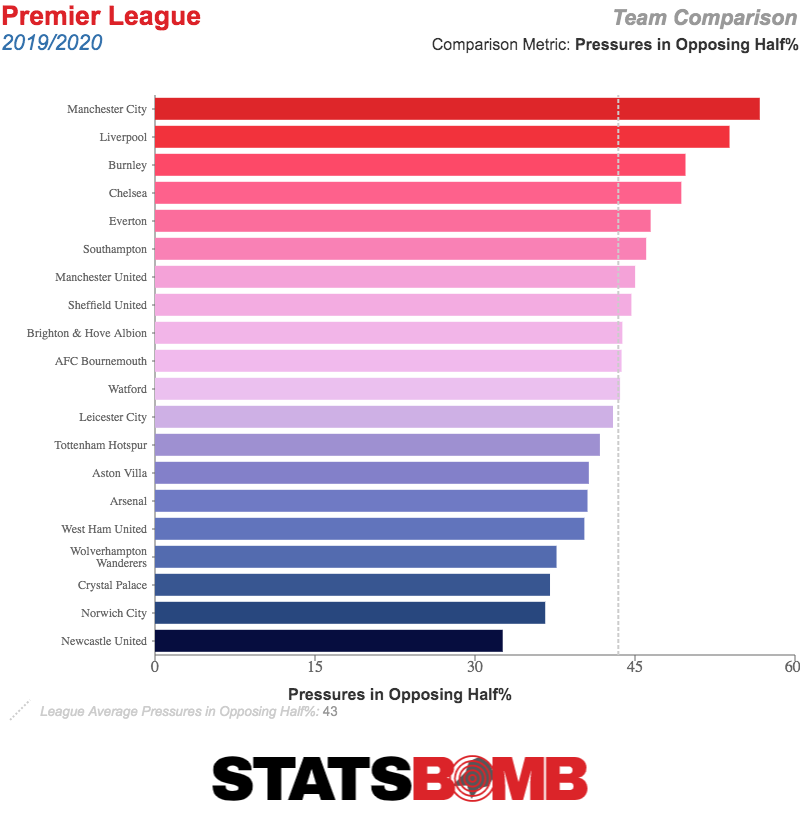 The obvious surprise towards the top here is Burnley. We all know at this point that Sean Dyche’s side do things differently, so it does make some sense to see them statistically stand out like this. At the bottom we have mostly less capable sides, but third placed Leicester sit in midtable. So do teams that defend high do a better job of it? Let’s compare this number to sides' xG conceded.
The obvious surprise towards the top here is Burnley. We all know at this point that Sean Dyche’s side do things differently, so it does make some sense to see them statistically stand out like this. At the bottom we have mostly less capable sides, but third placed Leicester sit in midtable. So do teams that defend high do a better job of it? Let’s compare this number to sides' xG conceded. 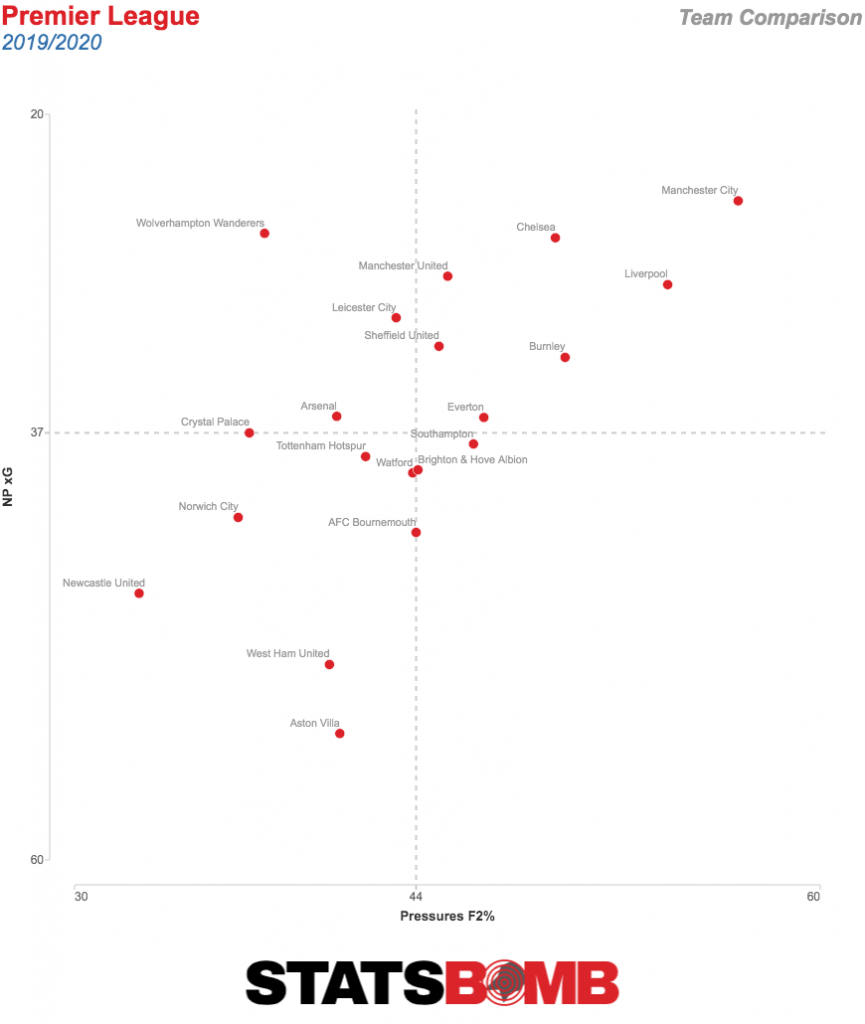 The obvious thing here is that the bottom right square is near empty. There isn't a team in the Premier League that offers an effective high press but just cannot defend at all. In terms of the sides that do actually defend well, there's a significant contrast. You have high pressers Man City and Liverpool, yes, but also a very solid Wolves outfit staying compact. The better sides do generally press more, but otherwise it isn't totally obvious that a particular pressing approach leads to better defending. David McGoldrick still can’t score goals Sorry, David. It feels mean at this point, but we can still gawk at your shot map one more time. Who knows, maybe your first attempt after football returns will go straight in the back of the net.
The obvious thing here is that the bottom right square is near empty. There isn't a team in the Premier League that offers an effective high press but just cannot defend at all. In terms of the sides that do actually defend well, there's a significant contrast. You have high pressers Man City and Liverpool, yes, but also a very solid Wolves outfit staying compact. The better sides do generally press more, but otherwise it isn't totally obvious that a particular pressing approach leads to better defending. David McGoldrick still can’t score goals Sorry, David. It feels mean at this point, but we can still gawk at your shot map one more time. Who knows, maybe your first attempt after football returns will go straight in the back of the net. 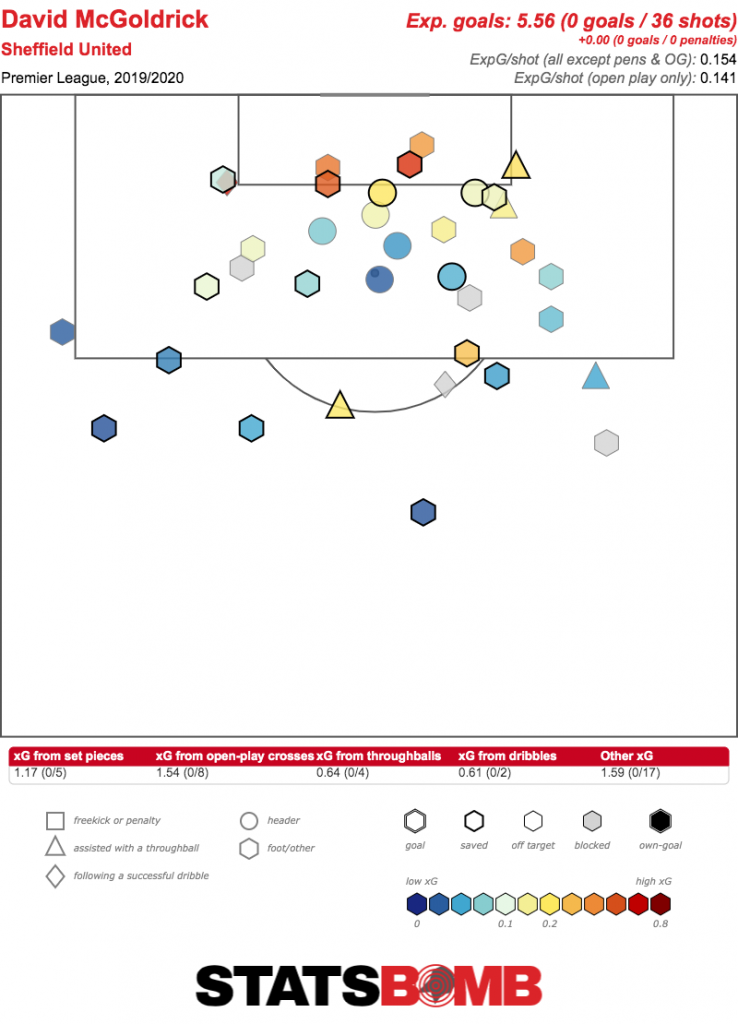 Next time, we’ll discuss some things we don’t know about the Premier League.
Next time, we’ll discuss some things we don’t know about the Premier League.
Sometimes football provides us with sliding doors moments. Sometimes it provides us with moments that change the trajectory of both clubs for years to come. Sometimes it provides us with moments that feel like they perfectly capture both teams at the time, but in later years look very strange in hindsight. When Tottenham Hostpur embarrassed Liverpool with a 4–1 win in October 2017, it only came as a mild surprise. See, back in the ancient period known as two-and-a-half years ago, Jürgen Klopp’s side were a bit flaky. The principles of the good play we’ve seen since were in place, but the Reds had an incredible talent to shoot themselves in the foot by giving up a select few high-quality chances. Liverpool would be great for most of the game, but when a team broke them open, they really broke them open. Here are the shots conceded in the eight games of the 2017–18 season they played before facing Tottenham. 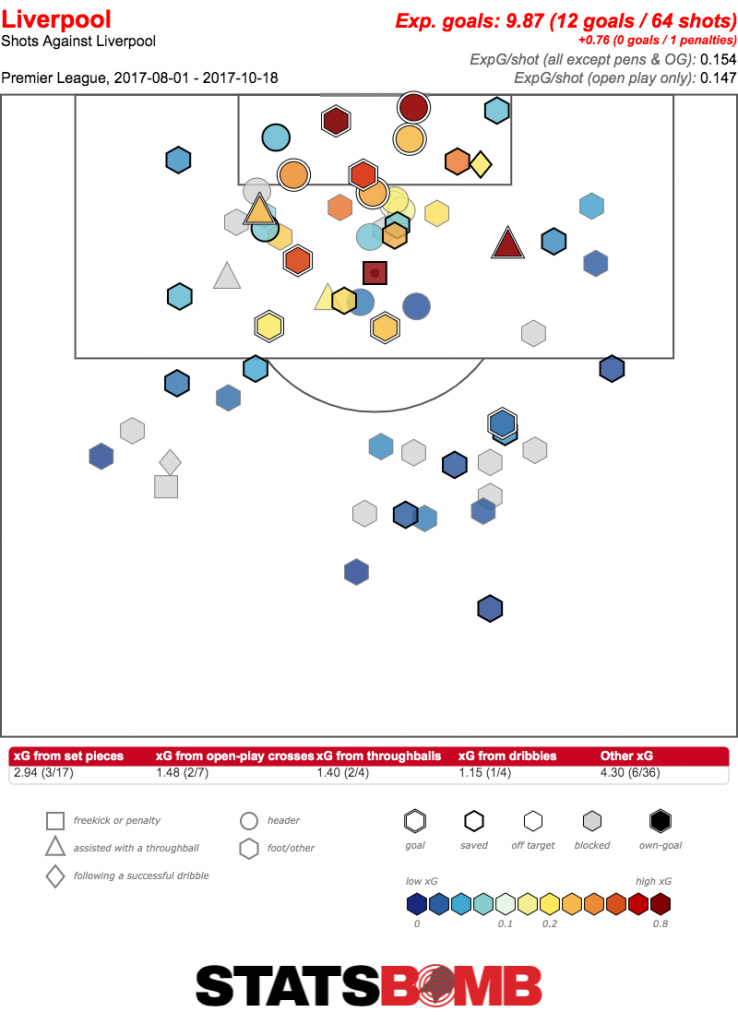 If that expected goals per shot doesn’t scream danger on the surface, let’s put it into context by examining the xG conceded of the entire league at this point.
If that expected goals per shot doesn’t scream danger on the surface, let’s put it into context by examining the xG conceded of the entire league at this point. 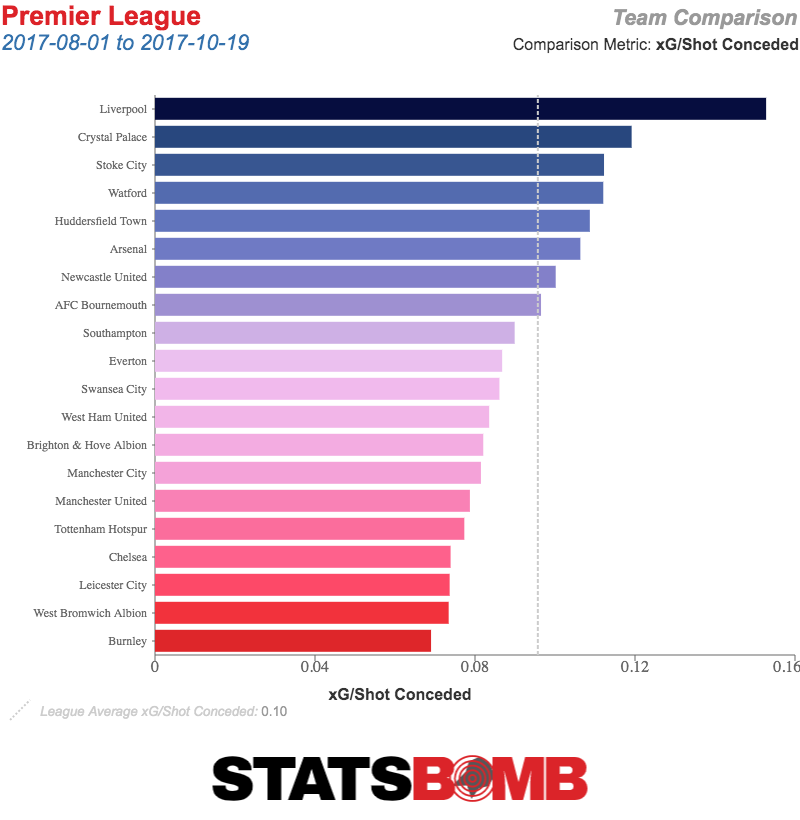 Yeah. The average chance Liverpool conceded was — by a decent margin — worse than those faced by any other team in the league. Yikes. Thus it wasn’t a huge surprise to see Spurs carve Liverpool up and score with their first two shots. The first saw Harry Kane react much quicker than all of Liverpool’s defenders and Simon Mignolet, earning himself a pretty decent angle with the goalkeeper in no man’s land.
Yeah. The average chance Liverpool conceded was — by a decent margin — worse than those faced by any other team in the league. Yikes. Thus it wasn’t a huge surprise to see Spurs carve Liverpool up and score with their first two shots. The first saw Harry Kane react much quicker than all of Liverpool’s defenders and Simon Mignolet, earning himself a pretty decent angle with the goalkeeper in no man’s land. 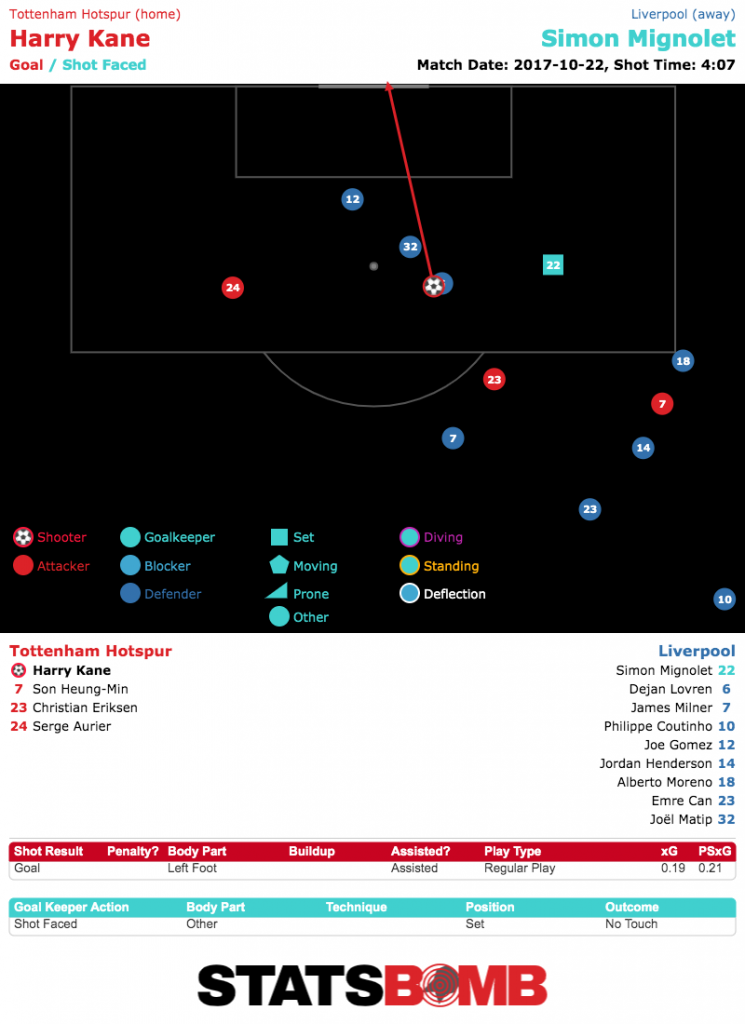 Kane outthought Liverpool’s backline again all of seven minutes later, this time catching the side out on a counter and playing in Son Heung-min for the finish. Neither of these goals really came from Mauricio Pochettino’s plan in possession. The action developed in transition moments, with Liverpool caught totally disorganised and 2–0 down before even registering a shot.
Kane outthought Liverpool’s backline again all of seven minutes later, this time catching the side out on a counter and playing in Son Heung-min for the finish. Neither of these goals really came from Mauricio Pochettino’s plan in possession. The action developed in transition moments, with Liverpool caught totally disorganised and 2–0 down before even registering a shot. 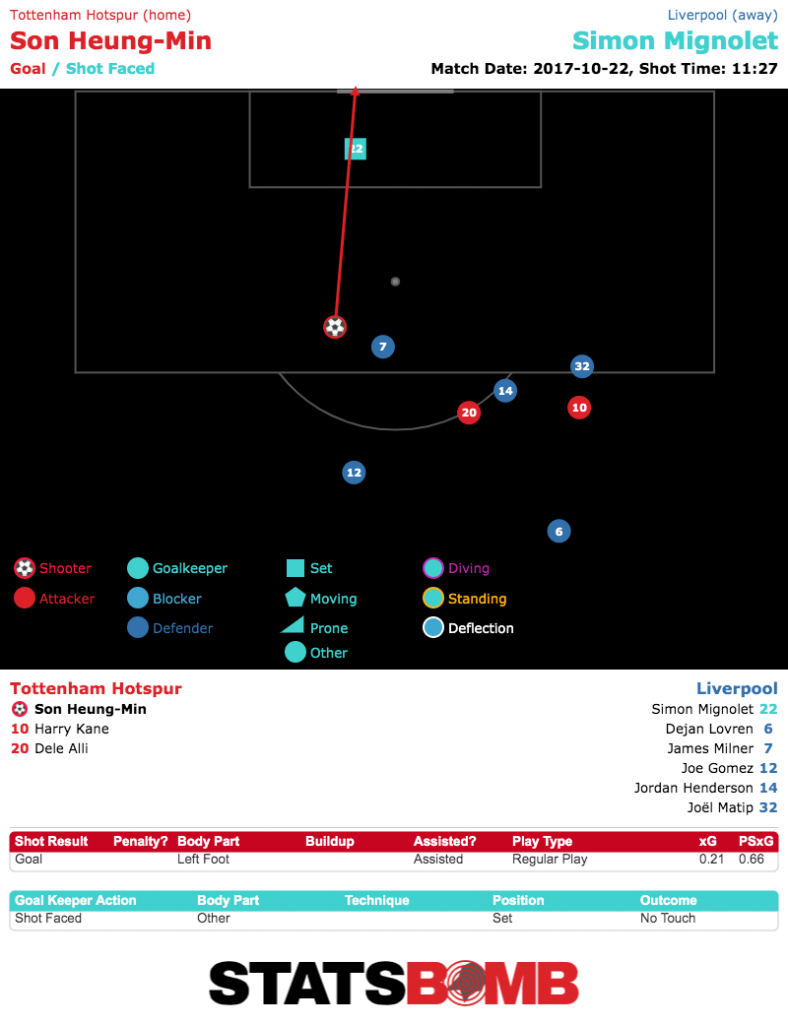 The race chart tells the story for the rest of the game. Liverpool had all of one good chance in the first half, which Mohamed Salah dutifully put away, but otherwise didn’t get going until they were already 4–1 down. Spurs came in waves, never feeling like they were dominating in terms of sustained periods but always landing the knockout punch.
The race chart tells the story for the rest of the game. Liverpool had all of one good chance in the first half, which Mohamed Salah dutifully put away, but otherwise didn’t get going until they were already 4–1 down. Spurs came in waves, never feeling like they were dominating in terms of sustained periods but always landing the knockout punch. 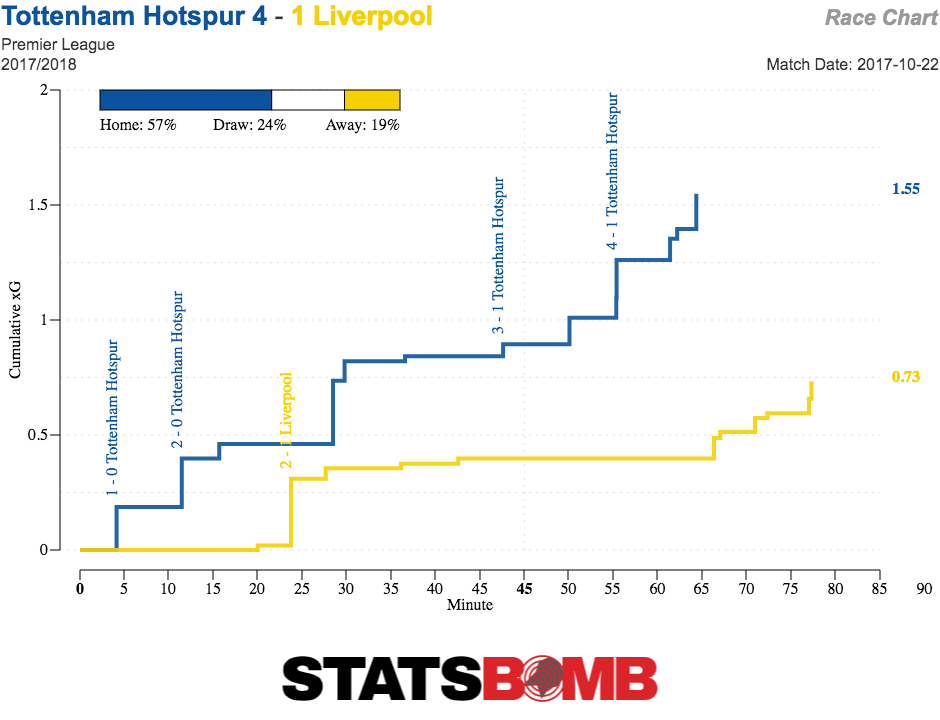 Their choice to play like this might have actually been enforced. Pochettino’s football at its best was always about pressing high and working good opportunities in possession. This game didn't show that. The key selection issue was Mousa Dembélé’s injury. The Belgian's out-of-this-world ability to evade pressure while moving the ball through midfield made him irreplaceable for Spurs’ Plan A. It’s not a coincidence that Tottenham have declined since he left North London. But his absence meant that Pochettino didn’t even try to control the game with the ball. Instead, he trusted that Liverpool’s concentration lapses would be enough to move to a purely reactive game plan. Spurs were able to win the game not through tactical ideas or talented players, but simply by being more switched on in moments of transition.
Their choice to play like this might have actually been enforced. Pochettino’s football at its best was always about pressing high and working good opportunities in possession. This game didn't show that. The key selection issue was Mousa Dembélé’s injury. The Belgian's out-of-this-world ability to evade pressure while moving the ball through midfield made him irreplaceable for Spurs’ Plan A. It’s not a coincidence that Tottenham have declined since he left North London. But his absence meant that Pochettino didn’t even try to control the game with the ball. Instead, he trusted that Liverpool’s concentration lapses would be enough to move to a purely reactive game plan. Spurs were able to win the game not through tactical ideas or talented players, but simply by being more switched on in moments of transition. 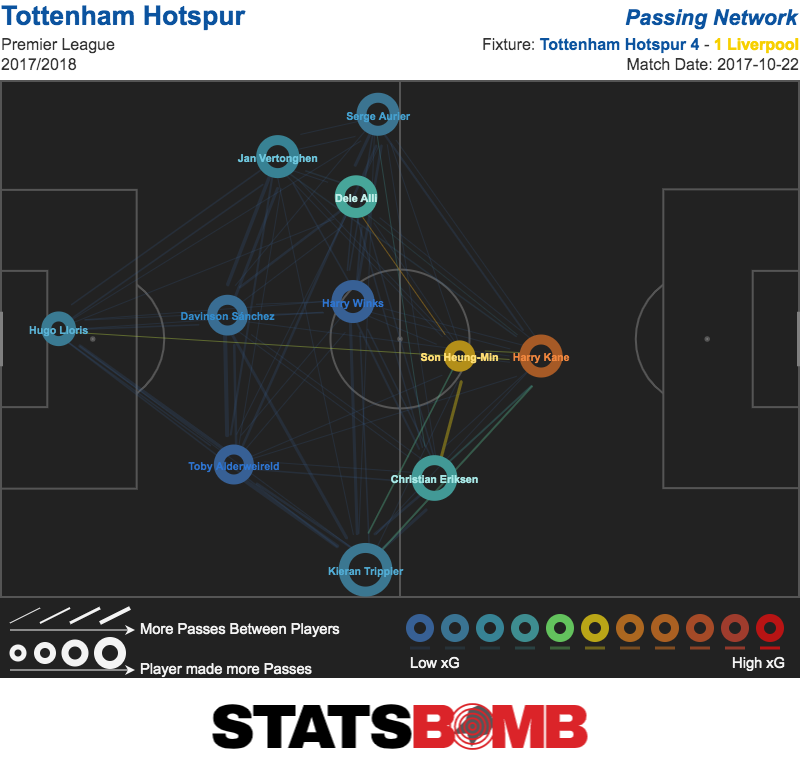 I’ve not been the kindest to Kane in the past, so it’s worth highlighting just how good he was here. He was mostly playing on the shoulder of the defenders and managed to be quicker than all of them to just about everything. This would make sense for Sergio Agüero or Jamie Vardy, but Kane isn’t especially fast. He just thought quicker than Dejan Lovren, Joël Matip and Joe Gomez. They were forced to react to things he had already done a split second ago. Lovren in particular was poor enough to be substituted after half an hour for Alex Oxlade-Chamberlain. This sounds like an extreme move, but in practice it was just Gomez moving to centre back as Emre Can shuffled over to right back, with Philippe Coutinho coming into central midfield and Oxlade-Chamberlain on the left of the front three. If it sounds like chaos, it was. Clearly, after this game Liverpool became exceedingly organised. Since then, the Reds have won 75 of the 96 league matches played, with a fairly ridiculous 2.5 points per game over such a long period. Their backbone is now strong. Of the goalkeeper and back four that started against Spurs, only Joe Gomez would now be expected to start such a big game. And he now plays a different position, with Trent Alexander-Arnold established as the undroppable right back. Salah and Roberto Firmino both started in attack here, but they were joined by Philippe Coutinho rather than Sadio Mané. Coutinho’s talent is obvious, but he’s much more of an individual than Mané, making the side less tactically coherent. This was a rough sketch of a Liverpool side that has since become worth hanging in the Louvre. For Tottenham, however, the game was something of the beginning of the end. As discussed, Dembélé was unavailable here, prompting a switch in strategy. The more reactive Spurs were able to pull off a few good results in one-off games, with the run to the Champions League final likely to be remembered for a long time. But they couldn’t produce consistent league results. As seen on the xG trendlines below, both the attack and defence cratered. This can’t be put down purely to the system, as players’ personal frustration with Pochettino was also an undeniable piece of the puzzle. But this confluence of factors brought a golden era of Tottenham to a fairly abrupt end.
I’ve not been the kindest to Kane in the past, so it’s worth highlighting just how good he was here. He was mostly playing on the shoulder of the defenders and managed to be quicker than all of them to just about everything. This would make sense for Sergio Agüero or Jamie Vardy, but Kane isn’t especially fast. He just thought quicker than Dejan Lovren, Joël Matip and Joe Gomez. They were forced to react to things he had already done a split second ago. Lovren in particular was poor enough to be substituted after half an hour for Alex Oxlade-Chamberlain. This sounds like an extreme move, but in practice it was just Gomez moving to centre back as Emre Can shuffled over to right back, with Philippe Coutinho coming into central midfield and Oxlade-Chamberlain on the left of the front three. If it sounds like chaos, it was. Clearly, after this game Liverpool became exceedingly organised. Since then, the Reds have won 75 of the 96 league matches played, with a fairly ridiculous 2.5 points per game over such a long period. Their backbone is now strong. Of the goalkeeper and back four that started against Spurs, only Joe Gomez would now be expected to start such a big game. And he now plays a different position, with Trent Alexander-Arnold established as the undroppable right back. Salah and Roberto Firmino both started in attack here, but they were joined by Philippe Coutinho rather than Sadio Mané. Coutinho’s talent is obvious, but he’s much more of an individual than Mané, making the side less tactically coherent. This was a rough sketch of a Liverpool side that has since become worth hanging in the Louvre. For Tottenham, however, the game was something of the beginning of the end. As discussed, Dembélé was unavailable here, prompting a switch in strategy. The more reactive Spurs were able to pull off a few good results in one-off games, with the run to the Champions League final likely to be remembered for a long time. But they couldn’t produce consistent league results. As seen on the xG trendlines below, both the attack and defence cratered. This can’t be put down purely to the system, as players’ personal frustration with Pochettino was also an undeniable piece of the puzzle. But this confluence of factors brought a golden era of Tottenham to a fairly abrupt end.  Will Liverpool suffer the same fate in the years to come? It’s not out of the question. Most of the Reds’ key players are in their late twenties, and only a small drop off from several of them could have a snowball effect. The club’s excellent record in the transfer market in recent years could be tested to the limit as the side will have to rebuild faster than most fans likely assume. Liverpool do have a plan, and they can avoid this fate. But Spurs should be a pertinent example for what the club must avoid in order to continue to dominate.
Will Liverpool suffer the same fate in the years to come? It’s not out of the question. Most of the Reds’ key players are in their late twenties, and only a small drop off from several of them could have a snowball effect. The club’s excellent record in the transfer market in recent years could be tested to the limit as the side will have to rebuild faster than most fans likely assume. Liverpool do have a plan, and they can avoid this fate. But Spurs should be a pertinent example for what the club must avoid in order to continue to dominate.
